These summaries focus on the 1950s through the 1970s, with an emphasis on trying to figure out which stations might have played rhythm & blues, rockabilly, or straight-on rock ‘n’ roll before WDGY, the first full-time rock ‘n’ roll station, hit the airwaves in February 1956. The Pavek Museum of Broadcasting has radio station ratings books that list programs from 1953 to 1955. At that time, the Twin Cities had only about nine stations, all AM, of course, with WCCO being the powerhouse. Let us assume that the mighty ‘CCO did not dabble in such vulgar music and focus on the others. Many thanks to Jeff Lonto, who is one of the Cities’ experts on radio history, for much of the information cited here.
Also see:
A Brief History of Twin Cities Radio
Twin Cities’ First Rock ‘n’ Roll
RADIO AIRCHECKS
Airchecks are samples of old radio recordings, with the music cut out. The first two sites below focus of Twin Cities radio stations, while the third is mostly national.
http://radiotapes.com/ (Tom Gavaras)
http://www.twincitiesradioairchecks.com/ (Rick Burnett)
Click on a station below for history, photos, etc.
Rock ‘n’ roll came roaring into the Twin Cities like a full force gale on February 6, 1956, when WDGY, 1130 AM, became a Storz station. Todd Storz had purchased this storied station, whose roots went back to 1923, and patterned it after his other rock ‘n’ roll stations in New Orleans, Kansas City, and St. Louis. Herb Oscar Anderson was the first disk jockey on the air with the new “Top 40” rock ‘n’ roll format that morning, and the jocks and the new sounds boosted the station from a tepid Number 4 to second place behind behemoth WCCO. You can hear some of Herb’s patter from September 7, 1956, on Tom Gavaras’s RadioTapes Web site: radiotapes.com/WDGY.html. Other early ‘DGY personalities were Bill Armstrong, Jack Thayer, Bill Bennett, Don Loughnane, and Stanley Mack.
But was this the first opportunity that Twin Citians had to hear what came to be known as rock ‘n’ roll on the radio? When did they first hear this new music that some loved, some hated, some called “just a fad,” but few could ignore? Here are some possibilities:
THE LABOR TEMPLE
Rock ‘n’ roll’s roots lie in pop, country, and most important, rhythm and blues. R&B existed right here in the Twin Cities, but was apparently a well-kept secret. As far back as 1950 promoters Rufus Webster and D.P. Black brought major R&B acts to the Labor Temple on 4th Street SE in Minneapolis. The list of performers runs the gamut of the important influences on rock ‘n’ roll; Bullmoose Jackson, LaVern Baker, Ruth Brown, Earl Bostic, Dinah Washington, Wynonie Harris, Johnny Otis, James Moody, Louis Jordan, the Clovers, Amos Milburn, Percy Mayfield, Johnny Ace, the Orioles, the Ravens, B.B. King, and the Spaniels are perhaps the best known.
The concerts were advertised in the Minneapolis Spokesman, the city’s African-American newspaper, but rarely in the mainstream dailies. Unlike most metropolitan areas of our size, the Twin Cities did not have a black radio station until December 1964 when KUXL changed its format from jazz to R&B. The simple fact was that the black population was so small (less than one percent of the state’s population through 1970) that the community wasn’t able to support one. But late at night, if the conditions were right, Minnesotans could hear all kinds of music through the airwaves from all parts of the United States – country blues from Arkansas, R&B from WLAC in Nashville, and maybe even some doo-wop from back East.
As for our own radio stations, there were about nine to choose from – the mighty WCCO (which had nothing remotely like rock ‘n’ roll) and those listed below. We have no airchecks, but ratings books from 1953 to 1955 do give us the names of programs that give hints as to what they were playing:
KEYD was primarily a country station, with shows by Slim Jim and the Vagabond Kid and programs called Record Rodeo and Random Ranch. But we also know that the Key Room program featured live performances by Augie Garcia, the Godfather of Twin Cities Rock ‘n’ Roll, performing jump blues in 1954-55 from the River Road Club in Mendota.
KSTP had some country shows as well, such as Dude Ranch Jamboree, but some of the other programs leave room for speculation that they may have played something hot: Rhythm at Random, Saturday Juke Box, Young Ideas, and Record Rack. By 1957 KSTP was squarely on the rock ‘n’ roll bandwagon, but got off pretty quickly.
WCOW, owned by the Tedesco brothers, was definitely a country – make that a hillbilly – station, with DJs named Sidesaddle Sore Sam (Sabean), Denver Don Doty, Buffalo Bob Montgomery, and Pecos Paul (Denault). They also played some Whoopie John and Frankie Yankovic for the polka crowd. But Sam Sabean [Sam Sherwood] reports on this very important development:
Joe Zingale called himself “Mr. Rhythm.” Here was a country station, WCOW, and on Saturday afternoon and evening, along came Mr. Rhythm [in 1955] and played the real soul of rhythm and blues. You can’t imagine how his popularity took off. When he was on the air, there were hundreds and hundreds of people around the radio station just hanging out and listening to the music. Joe then took it a step further and booked the St. Paul Auditorium for a rhythm and blues show with great locals such as Augie Garcia. Joe came from Cleveland, Ohio, and was a time salesman for WCOW and he just got this wild idea about playing that music. It was an overnight smash.
Zingale urged the Tedescos to change the station’s format to all R&B, and they considered it, but since they were only a 1,000 watt daytimer, they figured that a more powerful station would just steal the format and leave them hanging. Ironically, WCOW eventually morphed into rock ‘n’ roll station KDWB in 1959.
In the meantime, it was Zingale who arranged for Augie Garcia to open for Elvis when the King came to town in May 1956. Garcia was so good that Colonel Parker pulled him off early so he wouldn’t upstage Presley.
In 1956 or ’57 Zingale went to New York as an account executive and, with two others, bought a White Plains radio station. He made a ton of money, eventually owning part of the Cleveland Nets World Tennis Team, Cleveland Indians, and Cleveland Cavaliers basketball team.
WDGY: Dick Driscoll remembers trying to sneak in some peppier tunes in the mid- 1950s, to his boss’s chagrin. By 1955 the station was starting to play covers of rock ‘n’ roll in with Perry Como and Doris Day. Scripts saved all these years by DJ John Evans list songs such as:
- “Sincerely” by the McGuire Sisters. Out on the East Coast listeners heard the original version by the Moonglows. The Sisters’ version sold six times better.
- “Tweedle Dee,” not by LaVern Baker or even Georgia Gibbs, but by someone named Vicky Young.
- “Bo Diddley” by (are you ready?) the Harmonicats“
- Glory of Love” by the Four Knights. This was best done by the Five Keys in 1951, but the song was written in 1936, so who’s to complain.
- In July the McGuire Sisters were back with a song called “Rhythm and Blues” Somehow even they heard about it.
- Perry Como actually sort of rocked with a great tune called “Tina ”
- The year closes out with the Fontane Sisters back with “Seventeen,” a pretty good song if done by Boyd Bennett and His Rockets, a rockabilly band.
WLOL had lots of shows with tantalizing names, such as Top Tunes, Roy’s Record Shop, Today’s Hits, Top Ten, Hit Parade, and Off the Record.
In 1954 and ’55 Bob Bradley and Jerry Cunning played R&B tunes.
By 1956 WLOL was squarely in the rock ‘n’ roll camp and stayed there until at least 1959, although WLOL-FM featured classical music.
WMIN had several shows that might have included some jump tunes. While there were clearly some country/western shows – Saturday Hoedown and Western Favorites – and perhaps some old-time songs – Tin Pan Allan was on a lot – there were others with intriguing names: Ralph (Smith) and His Records, Top Tunes, (Judy’s) Juke Box, and Your Rhythm Review.
Most important, WMIN had some powerhouse disk jockeys:
- Bill Diehl worked at WMIN from 1948 to ’49 and from 1951 to ’55. His shows were variously called Diehl ‘n Music, Diehl’s Caravan, and It’s Your Diehl.
- Steve Cannon was at WMIN from 1949 to ’54. In a column dated January 24, 1954, Will Jones of the Trib called Cannon a “hep talking radio disk jockey.”
- Merle Edwards was at WMIN from 1949 to ’55 and had shows like Merle Edwards’ Caravan and Merle’s Mad House.
Bill Diehl tells the story about a car dealership called Slawik Motors that wanted to sponsor a show, but insisted that the DJ call himself “Hub Cap.” The station approached Diehl, but he thought the idea was ridiculous – he was a columnist for the St. Paul Pioneer Press after all. So they convinced Edwards to do it and he became Merle “Hub Cap” Edwards.
David Hersk, founder of North Minneapolis recording company Gaity Records, remembered that Edwards had a late night show where he called himself “Uncle Merle” and played plenty of R&B and rock ‘n’ roll in 1954-’55. “I remember recording ‘Rock Around the Clock’ from a WMIN broadcast on my Wilcox- Gay recorder. Merle introduced me when I called in, and gave me five seconds of dead air to start my home recorder at 78 rpm.”
WPBC: No, that’s not a mistake. The venerable family station bowed to pressure in 1954 and ’55 and started playing rock ‘n’ roll. Radio was going through a fearful period in the face of the TV monster, and Bill Stewart and his co-owner wife, Becky Ann, urgently called their staff together.
We asked them what WPBC should be playing and it was almost unanimous that we should play the Top 40, rock and roll … I remember that the No. 1 tune was Ernie Ford singing “Mule Train,” and can you imagine me calling from home on the phone that we weren’t playing “Mule Train” often enough? … The turning point came one night around [January 1956] when we tuned in the Tommy and Jimmy Dorsey Show on TV and they had on Elvis Presley … They predicted that he and his music would be the wave of the future, and when we heard what he sang and how he sang it, we began to be concerned. My wife and I had long discussions late into the evening. If we had to play junky music with morally degrading lyrics, we’d get out of the business.
WTCN was the home of Jack Thayer and Bill Diehl (before they moved over to WDGY) and had a lot of music shows with ambiguous titles. Reportedly one of them was a one hour program playing rockabilly and R&B – perhaps the first in the area. I’d like to think that 8 Steps Down was some kind of cool jazz program with some Brubeck, some Mingus, etc., but there’s no way to know unless someone out there remembers!
There were other ways for Twin Citians to hear pre-WDGY rock ‘n’ roll, of course: Records from Melodee Record Shop in Downtown Minneapolis, movies like Blackboard Jungle, and live performances of pop, jazz, and country acts. I asked a black friend of mine how her father heard his music in the ’40s and ’50s, and he said that Pullman porter friends of his would bring them in on the train from Chicago.
But the advent of WDGY was the quantifiable arrival of the genre that influenced lifestyles, attitudes, fashion, language, and of course, radio formats for generations to come.
WWTC started out as WTCN radio, 1280 kc AM.
The call letters were changed to WWTC on October 2, 1964, after the station was sold to Buckley-Jaeger Broadcasting. At the time it was programming Classical music.
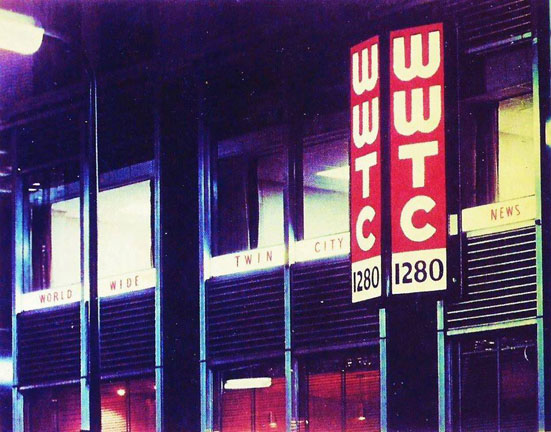
2nd Ave. So., Builder’s Exchange, 1965
I have absolutely no idea what is going on here. Did they bring Imogene the horse inside Jennings? And as many times I tried to get Jim Jennings to talk to me, he ducked me every time. So maybe we’ll never know. Oh wait! The Strib is online now! Imogene was giving free rides in the parking lot for a new ad campaign. Thank goodness for Will Jones!
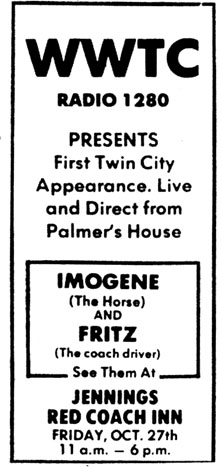
Jack Reynolds became General Manager in April 1971.
SOFT PROGRESSIVE
The Insider reported that it was moving toward “soft progressive” in September 1971, when Dick Driscoll came back to the station after Dick had turned KQRS from classical to progressive.
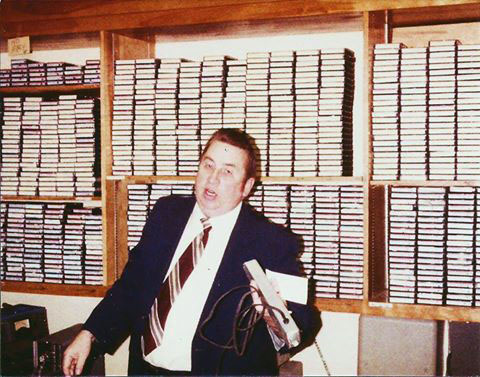
Dick Driscoll at WWTC in 1980, courtesy Jeff Lonto
SPECTRUM
In April 1973 there was an ad for WWTC Spectrum, “If you’re not thrilled with KSTP, WYOO, KEEY, or WLOL.” All things to all people, apparently: “Every twenty minutes it’s a different color of spectrum. Humor from a local Twin City news item. A unique look at sports. The why behind recent legislation. The why behind a cheeseburger. This is WWTC Spectrum. Always a different color of Twin Cities life. The colors range from bright to blue, from funny to warm, from entertaining to informative.” I guess that means no music.
I’m sorry the ad below is so hard to read.
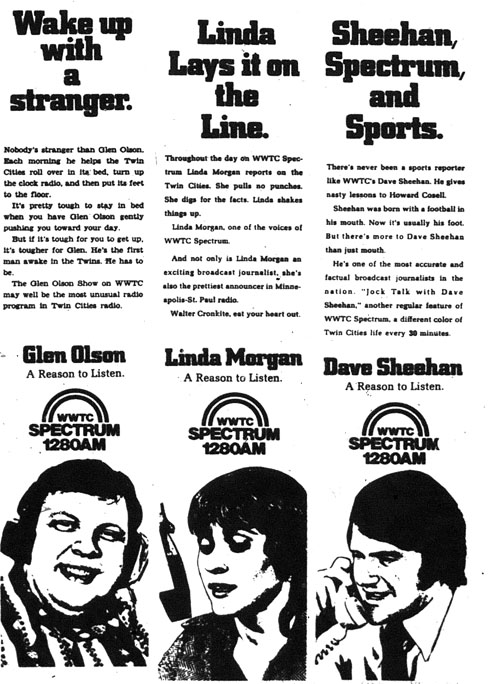
April 18, 1974, Sun Newspapers
NIS
On June 18, 1975, 1280 switched to NBC’s News and Information Service (NIS).
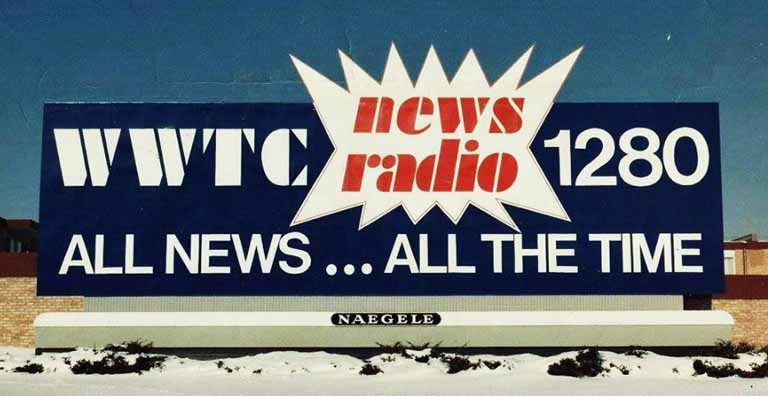
Image courtesy Jeff Lonto
On the day the station switched over, rival station KEEY, published this rather gruesome ad. The text is rather small; it reads:
Today WWTC Radio trades violins for violence
June 18, WWTC radio replaces every bit of music with news. Now, we’re not trying to put down all-news radio stations. But if you listen to radio to soothe your nerves, reports of mideast tension, recession and crime just might produce the opposite effect.
That’s why we’d like to call your attention to the music of KEEY-AM at 1400 on your standard radio dial. The best of what you’re about to give up on WWTC is what we play all the time on KEEY. Along with enough news to give you information, but not anxiety. What’s more, we do it selectively enough to fill just the news you want. At the time you want it.
Think of it this way. You’re not losing WWTC, you’re gaining a KEEY.
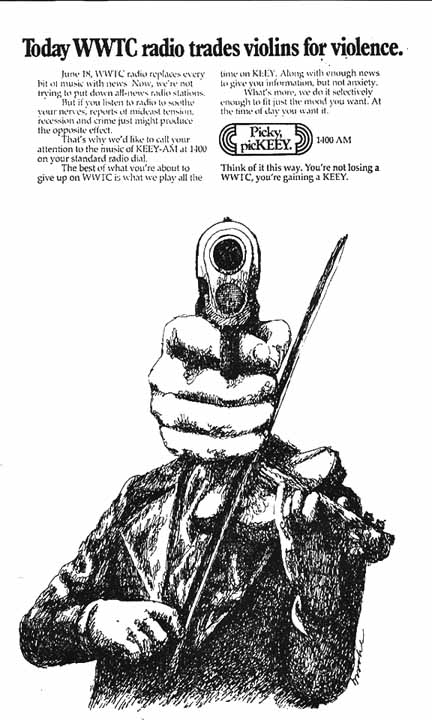
June 18, 1975. Image courtesy Jeff Lonto
NIS ended in May 1977 but WWTC continued the all-news format with its own staff. Bob Allard’s call-in show nearly caused a riot on July 14, 1978, when he hosted Nazi Steven Martinson.
GOLDEN ROCK!
Bob Short bought the station from Buckley Broadcasting in early (in or before March) 1978. It changed its format to “Golden Rock” on October 1, 1979. This was a fun station. The promotional flier or whatever below was posted on Facebook, and I don’t know what the class designations mean. I do know that Nancy Rosen’s name is spelled wrong. Oops!
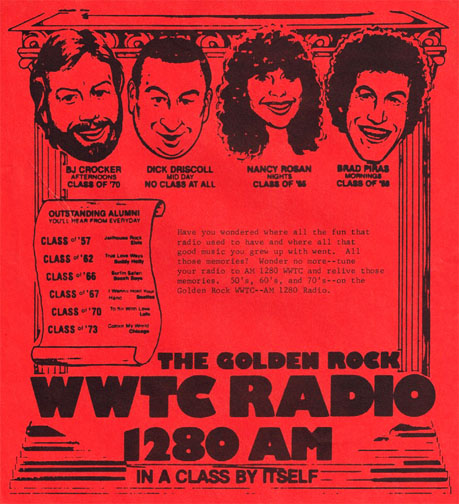

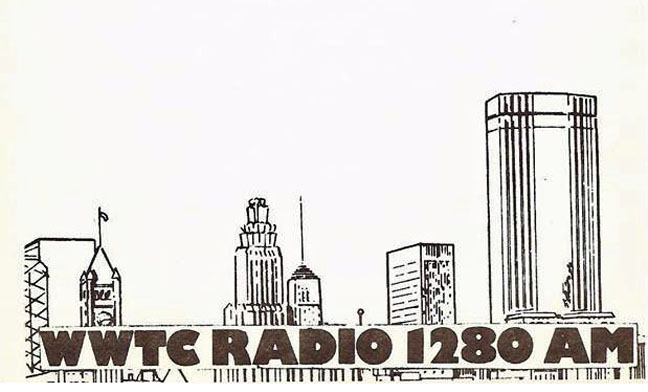
WWTC Stationery from 1979 (scoped!). Probably poached from Facebook.
The caption to the photo below, from Minnesota Music magazine, 1980, reads
WWTC AM Radio is something of an oasis in the local radio market. More than a nostalgia station, more than a mixture of rock ‘n’ roll history and local rock trivia, ‘TC offers listeners personality programming and a fun sense of belonging to a rock ‘n’ roll community.
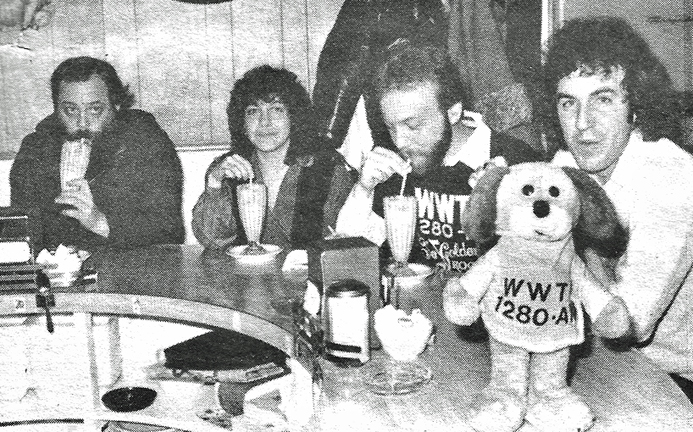
Steve Bowman, Nancy Rosen, B.J. Crocker, and Brad Piras. Photo by Greg Helgeson, Minnesota Music magazine
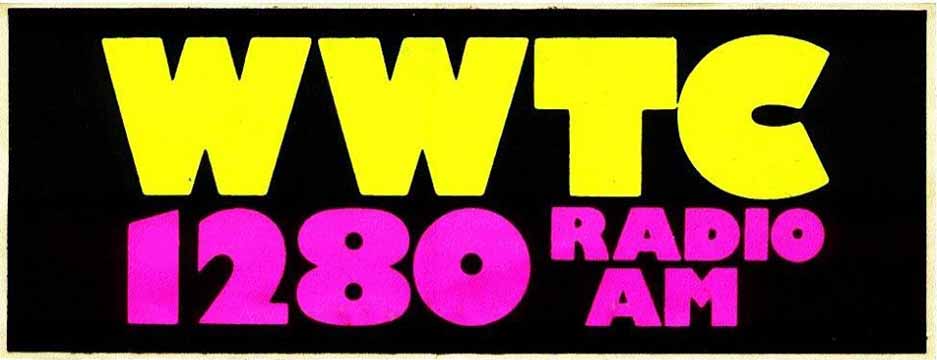
Bumper sticker @ 1980 – 1984. Image courtesy Jeff Lonto
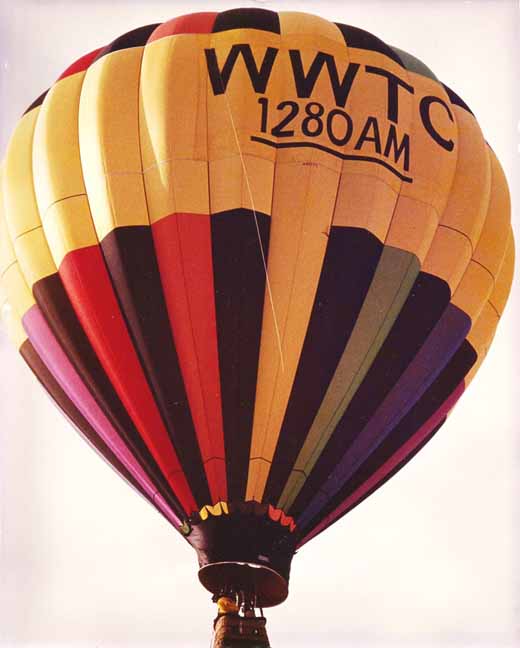
1980 Image courtesy Jeff Lonto
Alan Freed posted the photo below of WWTC’s control center taken in 1981.
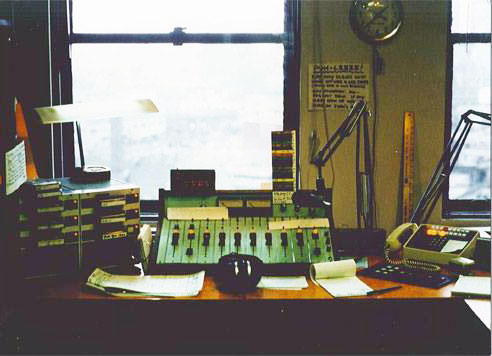
Photo courtesy Alan Freed
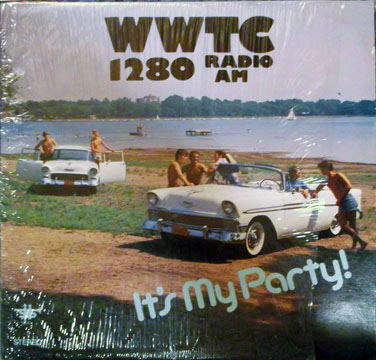
Record album issued by WWTC in 1981 – image courtesy Jeff Lonto
I’m going to stop here – I should have stopped long ago, since this website only goes to 1974. I leave it to smarter people than me to figure out the history of this craziest of stations. Thanks to all contributors.
As always, much more information and many airchecks are available at www.radiotapes.com/wwtc.html and http://twincitiesradioairchecks.com/wwtc.html
1370 AM went through more ups and downs than probably any other local radio station. Doing the research for this page has taken all of my resources, from the all-important Facebook, Star Tribune, and Wikipedia, broken links, bad info and all. Let’s hope this is sort of right. Special thanks to Jeff Lonto and Alan Freed!
THE BUILDING
The building was the old WPBC studio on Stinson Blvd., near Broadway, abandoned because of freeway construction. The State put it up for sale, and three cheeky guys, Roger Wilson, William Woods, and Dave Herman, put in a bid for $200. Since it was the only bid submitted, they were handed a building worth $35,000, complete with air conditioning, transmitting equipment, control board, and “paneled studios and offices.” For $7,000 they moved the entire concrete block structure 25 miles across town.
The studio, transmitter, and a 3-tower directional antenna array were located off Military Road in Woodbury (just east of Newport). The street address was 6541 Military Road. A fair portion of its signal pointed away from populated areas, making it audible only to its intended audience in South and West St. Paul.
WMKT
Reported the Minneapolis Star, “The new station will go on the air in early May with a music format, said Herman, ‘and not all that yakety-yak you hear on some stations.'” (April 13, 1965)
The station was licensed as 500-watt daytimer serving South St. Paul.
The station began broadcasting on July 1, 1965. The manager was Roger D. Wilson, and in an ad for sales people he called the station “Katy Radio.”
Early disc jockeys were:
Tom Kaye and Bob Lulline (1965 to 1966)
Denny Long (1966 to 1967)
Jay Daniels, Phil LaManne (1966 to 1968)
Dick Daniels, Ed Lowell, Harvey Moss (1968 to 1969)
Doug White, Tony Young, Dee Carr, and Tom O’Neal (1969 to 1970)
The last listing in the Minneapolis papers as WMKT was April 11, 1970.
KDAN
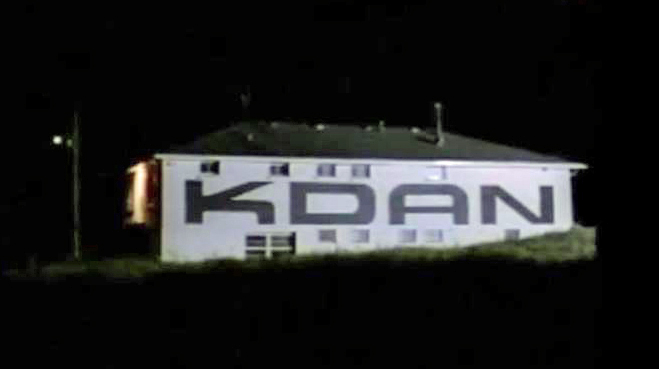
Screen grab from the movie “Purple Haze.” Image courtesy Alan Freed
The station changed its call sign to KDAN in March 1970. The initial format was apparently Modern Country.
There were a few periods of time when the studios were remotely located in (glassed-in) studios across from the 1st floor elevators of Metro Square shopping mall in downtown St. Paul.
The KDAN Remote “Caboose” Studio was used in the early 1970s for commercial remote broadcasts and for broadcasting from the Minnesota State Fair.
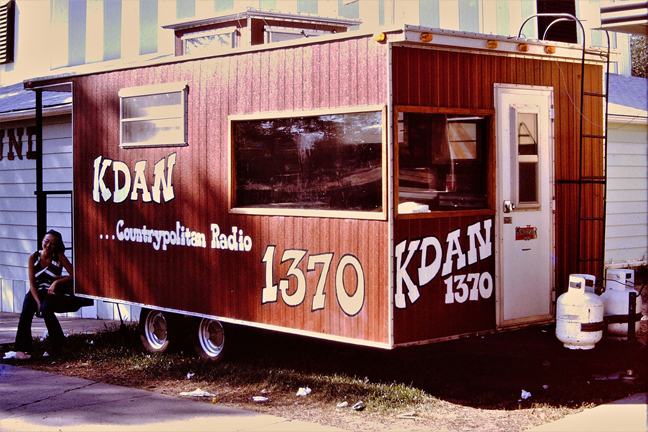
Paul Johnson recalls the remote surroundings of the transmitter and other memories of the tiny station:
To make a once-per-day required base current reading at the bottom of the center tower meant you had to trudge through chest-deep snow in the winter. In the summer, you waded through chest high weeds – and as important as noting the amperage, was pulling (and, for sport, counting) any number of wood ticks that would jump on you for the ride (I counted 27 one day.)
It was automated country with a Schaffer pegboard sequencing unit when I was given the duty of being the station’s Program Director in early 1975 – added to my duties of being production coordinator for the short-lived Viking State News Network. VSNN had taken over the station on a management agreement and, in reality, nobody else at VSNN wanted the PD job.
In 1976, U of M student Gregg Lindahl joined for summer employment as music director. With the aid of conviction to principle, an innovative approach to tweaking the automation to liven up the sound and programming our own currents and recurrents, p*ss, vinegar and a well-crafted letter and position paper to Jim Duncan, then R&R’s Country Editor, we managed to get KDAN appointed as the 75th Country reporter for the fledgling trade paper. 36 years later, I’m still in the radio game – with more than my fair share of terrific experiences. KDAN may not have been much…but it provided me opportunity – and a beginning. I’ll always be grateful for the little station in the funky building on Military Road in Newport.
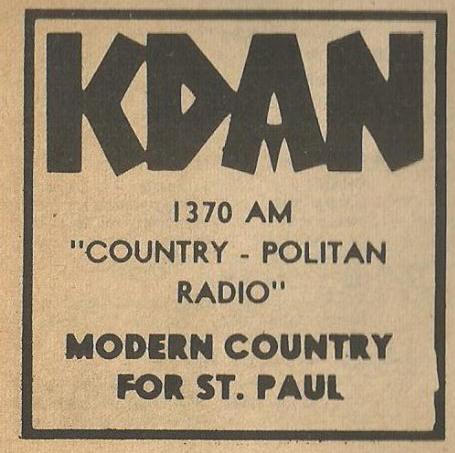
TV Times, 1973. Courtesy Jeff Lonto
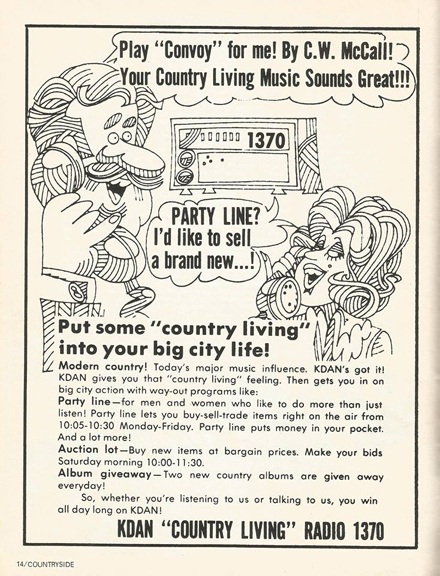
Countryside magazine, March 1976. Courtesy Jeff Lonto
Steve Valeri donated the KDAN lighter holder shown below. I didn’t know there was such a thing, but I’m guessing it was probably from the Country era. Many thanks to Steve for this truly unusual artifact!
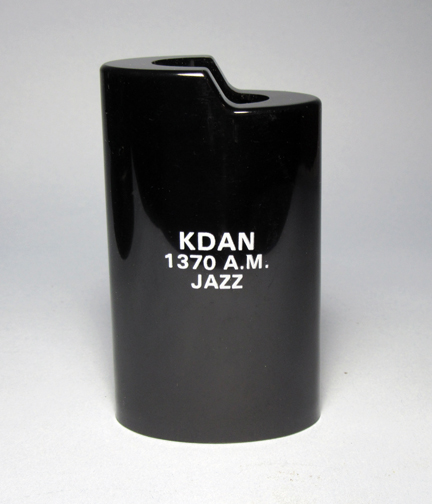
Lighter holder courtesy Steve Valeri. Photo courtesy Steve Raymer
DISCO
Sometime between March 1976 and January/February 1979, the station flipped to Disco. Radiotapes.com has an aircheck by DJ Phil Conklin playing “The Music You Wanna Hear,” submitted by Al Arneson.
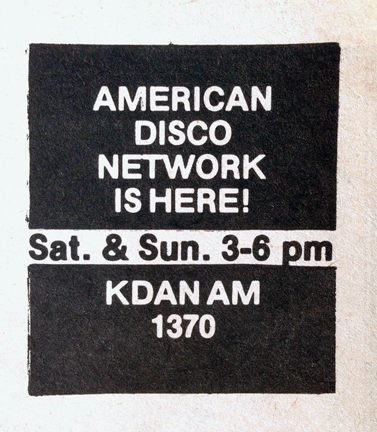
Metro Student News, April 20, 1979. Image courtesy Alan Freed
In 1980 KDAN was airing the syndicated Wolfman Jack Show.
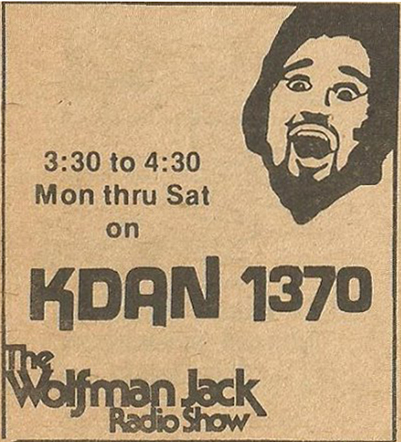
TeleVue magazine, 1980. Courtesy Jeff Lonto
On August 28, 1981, the station was purchased by Soho Broadcasting, Stanley Soho, President.
By 1981 it was back to Country, testified by Chris McKay:
In 1981 I had just graduated from Brown Institute, and was the CHIEF ENGINEER at KDAN AM 1370! I was the only one there with a GRTO [General Radiotelephone Operator license]. The format was “Country With A Kick.” There was a three tower directional array, and a transmitter that looked more like a refrigerator. We sold spots “a dollar a holler.”
A PEEK INSIDE
Alan Freed points out that the 1982 film, “Purple Haze,” shot in the Twin Cities, used the mighty KDAN 1370 South St. Paul for a scene. Jeff Lonto: KDAN was depicted as an FM underground rock station, the complete opposite of what it actually was. Freed: KDAN, being a daytimer, was a perfect station to shoot at because it was off the air from sunset to sunrise, so a film shoot wouldn’t interfere with normal operations if the filming was overnight. And this scene was a night scene. That clock is probably showing real time. Screen grabs below courtesy Alan Freed.
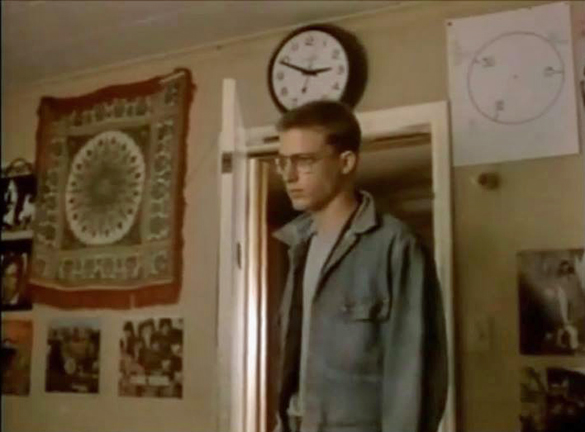
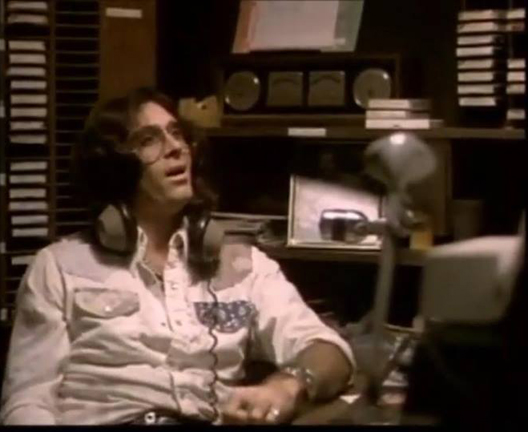
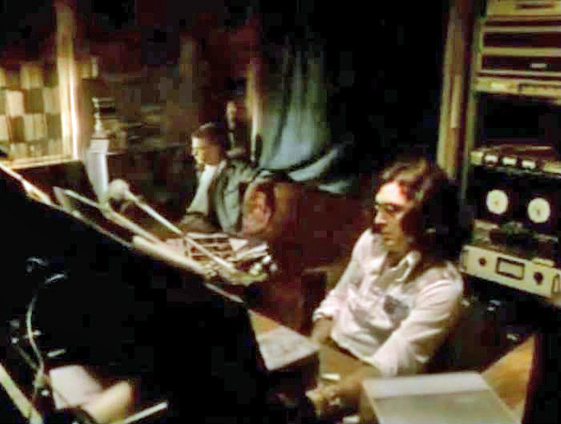
Bad news from Wikipedia: “Despite receiving positive reviews in some mainstream publishings, Purple Haze was a flop. It faded into obscurity shortly after its release.”
THE END OF KDAN
Wikipedia says that the station went through jazz, and all news formats. The Broadcasting Yearbook for 1983 indicates that the format was country. The Yearbook also gives the personnel as:
- Michael Scroggins, General and Program Manager, Program Director
- Jean Myts, Commercial Manager and News Director
- Mark Scroggins, Music Director
- Scott Christensen, Chief Engineer
Regardless, it went bankrupt by 1983 and left the air. Last mention in news listings was on September 13, 1983. The station had a country format at the time and was owned by Benita Soho of Los Angeles, doing business as Newport Broadcasting.
DARKNESS FELL
And then, nothing. Did the snakes and ticks take over the studio? Who had the key? What happened to the records? So many questions.
KMAP
But then on May 2, 1988, new life came to our little station in the form of KMAP. Broadcasting Yearbooks for 1984 through 1987 show that the name had been changed when KDAN went dark in 1983. Those Yearbooks and a Minneapolis Star Tribune article dated April 30, 1988, provide the details below.
The 1989 Broadcasting Yearbook reported that the station was now owned by Newport Broadcasting. The Star Tribune article also reported that Al Alonzo reported to Newport. The station’s address was given as 287 E 6th Street, St. Paul. Personnel listed were:
- Al Alonzo, Vice President and Program Director (also identified as General Manager by the Star Tribune)
- Don Vincent, Musical Director
- Dave Edwards, Chief Engineer
The station’s format was described in the Yearbook as Urban Contemporary. It was also described as 90 percent dance music in a TV interview on YouTube. The article in the Star Tribune outlined the new program:
- Mornings featured DJs Larry Fitzgerald and DonOvan Staar Johnson, formerly of KMOJ
- Jan R., brought in from New York
- Alonzo himself was to do the afternoon drive.
- Ed Garrett of KTCJ, 7-midnight
- From Midnight to 6 am they would broadcast “The Quiet Storm,” a syndicated program of laid-back music.
Drew Durigan: “I DID hear them very well in 1988 as KMAP. Format was Urban and they were targeting inner city Minneapolis. They claimed to be running 5,000 watts.” On the banner below is an outline of Downtown (St. Paul?) and the slogan “Beat of the Cities.”
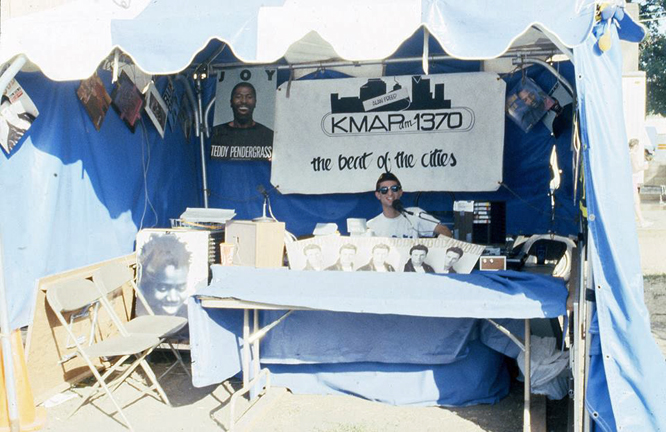
Alan Freed at KMAP’s booth at Riverfest, Harriet Island, 1988. Courtesy Alan Freed
THE END OF 1370
A search through the Broadcast Yearbooks and the Star Tribune turn up no evidence that the FCC ever raised the station’s hours or wattage, so KMAP was apparently operating beyond the parameters of its license. The station again went dark, this time for good, but when?
- Wikipedia says July 1989.
- Alan Freed, an employee to June 1989, says July 1989.
- The Star Tribune lists the station until January 6, 1991
- The Star Tribune published the last program note (“Radio Rey,” Saturdays 9 to 1) on June 14, 1990.
- The broadcast license was cancelled by the FCC in February 1991.
As for ownership, that, too, is a jumble.
- Wikipedia says the station’s last documented owner was KMAP Broadcasting of Tampa.
- The Broadcast Yearbook cited Soho Broadcasting through 1988 and then Newport Broadcasting.
Alan Freed: Al Alonzo still owes many of us our final paychecks. And he skipped out on the landlord, too. It has been my opinion that a big lightning storm in July 1989 was an excuse for the station to shut down operation.
And so goes the history of one of our most obscure radio stations. What became of the building? Where is the equipment? Only the snakes know for sure.
WYOO/U100 – 980 kc
980 AM was originally staid WPBC from 1949 to 1972. Apparently WPBC was trying to hang on: an ad in what appears to be called WPBC Metropolitan Magazine, dated April 1972, says:
WPBC MAKES THIS BOLD CLAIM: IF you are an ADULT ….. who likes POPULAR MUSIC from TODAY and YESTERDAY but your nerves can’t stand the LOUD NOISY TEEN-AGE MUSIC….. YOU WILL LOVE the GENTLE TENDER TOUCHING RELAXING selection of EASY LISTENING POPULAR MUSIC on WPBC AM and FM STEREO! It’s MODERN… but MILD! It’s IN… but NOT far out!!!! Try it for a week. You’ll LOVE IT!!!!!
WYOO
Well, they didn’t love it, and at noon on November 2, 1972, oldies station WYOO signed on for the first time with “See You Later Alligator” by Bill Haley and His Comets. WYOO was owned by Fairchild Industries, an Aeronautics company from Maryland that was looking to diversify. The new manager of operations was William Stewart, ironically replacing WPBC owner Bill (and wife Becky Ann) Stewart. General Manager was Marlin D. Schlottman, formerly with WLOL.
U100
On August 26, 1974, live at the Minnesota State Fair, the oldies format became “boogie,” with KDWB alumnus Rob Sherwood heading up a wild and crazy format as U100. Sherwood and the rest were at their antic best, cooking up contests and announcing test answers to kids. Check out airchecks and more at RadioTapes.com, where the home page features newly-discovered TV commercials from 1974 – 1975. One even has a snippet of Loni Anderson!
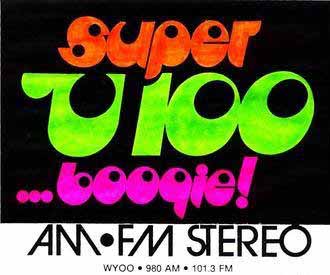
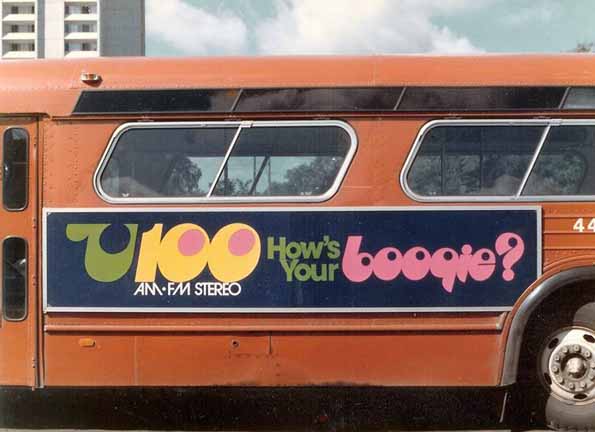
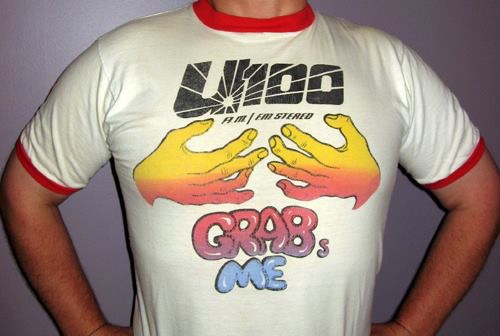
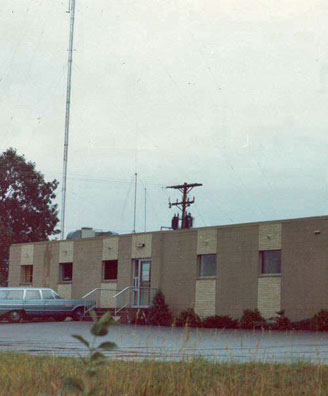
The station in Eagan, 1974
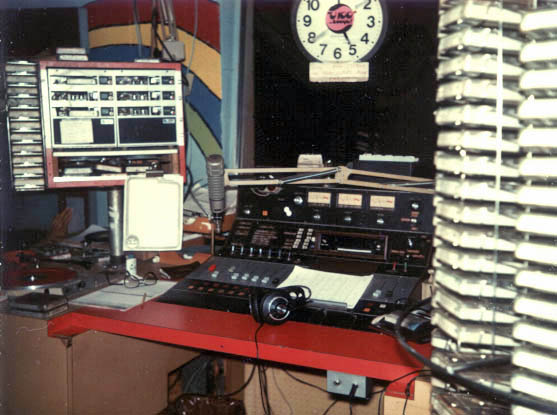
U100 Studio. Photo provided by Mark Vollmer to Radio Tapes
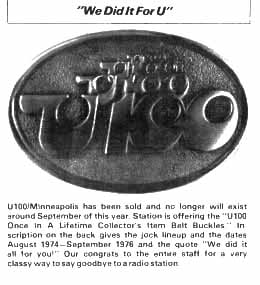
May 7, 1976, Courtesy Tim Brown
U100 signed off for the last time at midnight on Wednesday September 15, 1976. JoJo Gunne was the last jock.
KDWB morning personality True Don Bleu launched the new KDWB-FM simulcast the following morning at 6 AM, replacing WYOO-FM. The first song was Bad Blood by Neil Sedaka.
The following Monday, 980 AM (WYOO-AM) came back on the air as WAYL.
The story from Wikipedia: (Punctuation fixed by me)
After two years of wrangling and obtaining start-up funds, WPBC officially signed on the air on October 18, 1949. The station was owned by the People’s Broadcasting Company, founded by former WCCO announcer Bill Stewart and his wife Becky Ann. In contrast to WCCO and KSTP, WPBC carried no network programming, and were live and local all day. The station in the early years played a variety of middle of the road pop music and standards, and was even considered an innovator in the concept of singing jingles.
The Stewarts took a rather conservative approach in programming the station. They shied away from the likes of Elvis Presley and most early rock and roll music, which they described as “junky music with morally degrading lyrics.” Their philosophy extended to commercials as well, to the point that they rejected advertising from beer and tobacco companies. Allegedly, the Stewarts would go so far as to use the sharp end of a compass to scratch away the grooves of tracks on albums that didn’t meet their standards of “nice” music, in order to prevent rebellious D.J.s from playing them. As they were limited by their then-daytime only license at 980 AM, they started up WPBC-FM at 101.3 MHz in August 1959, simulcasting the AM station.
Advertising sales for the stations paled in comparison to the competition, and managing both stations became a burden for the couple, so the Stewarts sold the station in 1972 to Fairchild Industries for $1.5 million. Fairchild subsequently dismissed the entire staff and overhauled both stations.
Super WYOO
On November 3, 1972, the AM station was relaunched as WYOO, picking up an oldies format (with rock and roll included). A few days later, WPBC-FM became WRAH and programmed an automated album oriented rock format. When the oldies format of WYOO started to slide in the ratings, more MOR music was added, but ratings slid even further. Fairchild contemplated selling the station. The general manager (Mike Sigelman) and program director (Rob Sherwood) (1974), both hired from established Top 40 station KDWB, felt a major change needed to be made.
The decision was made to change to a Top 40/hard rock format, in contrast to what they saw as the rigid, bland presentation of other similar stations in town. They kept the WYOO call letters, to avoid the hassle and long process of changing call letters with the FCC. Mike Sigelman (General Manager) Rob Sherwood (program director), both hired from KDWB, hired Bill Hartman straight out of WMMR at the University of Minnesota to become a full-time promotion director. Rob and Bill would sit in the basement of the radio station playing air checks and other sources of radio information on disk. They both became enamored with an air check album that contained KFRC, the San Francisco “powerhouse.” It was a very high energy top 40 presentation featuring Dr. Don Rose and Ed O’Brien. It was on that day that Rob and Bill decided to emulate KFRC and use the phrase “powerhouse.” With Mike Siegelman’s OK, they decided to call the new station “Y100.”
Bill Hartman, as promotion director, convinced Rob and Mike that it was very important to launch the new station at the Minnesota State Fair, exposing the new format to 1.3 million people that attended the fair for 12 days at the end of August to Labor Day every year. Rob flew to Dallas to supervise cutting new jingles for Y100 at the media “jingle” production company “PAM’s.” Bill Hartman commandeered the U of Minnesota theater production company to help create an exterior façade that would cover a small trailer to remote broadcast from the State Fair. Everything was ready and in place on the first day of the Minnesota State Fair, and Rob had the format and jingles ready to go on the air.
Unfortunately, Mike Siegelman received a letter of “cease and desist” from Heftel communications in Miami, which owned “Y100 Miami.” Rob and Bill were in a state of shock, and the decision was made to not launch the station on the first day of the State Fair. In the meantime, Rob flew to Dallas to recut the jingles. Rob and Hartman decided to use “U100” because of the dial position on an FM tuner – you barely had to turn the dial to fine-tune between 980 AM and 101.3 FM – they were within a couple millimeters of being “in line” on a 1970s-style AM/FM stereo tuner. Consequently the launch of U100 was delayed three days. As Hartman and a crew worked 24 hours to changed all the logos and artwork on the broadcast trailer, it was a very hectic time for this brand-new, soon to be record-breaking FM station. The actual graphics and billboards were created by Sid Rich and his advertising agency at the time in 1974. People walking by the facility at the Minnesota State Fairgrounds would comment, “what is this?” U100 “the twin cites powerhouse” playing top 40 and album rock from the speakers with no one in the booth! A lot of people thought it was a broadcast training center like Brown Institute or something.
Finally, Rob Sherwood arrived back in Minnesota with new jingles for the Twin Cities powerhouse station U100. ..This is the true story of the birth of U100. The entire concept, advertising and promotion was headed and created by Mike Siegelman, Rob Sherwood, and Bill Hartman. “Super U100, the Twin Cities powerhouse” was the original catch phrase, used on-air and in promotion and advertising beginning on August 26, 1974.
The program director, Rob Sherwood, used this opportunity to abruptly change the format of both stations, debuting the AM and FM simulcast of “Super U100” with a Joe Cocker song and a two-minute montage of the new station’s new jingles. The new U100 quickly became the topic of conversation throughout the area with its rowdy, outrageous mix of Top 40 and hard rock. With a constant bombardment of loud jingles, the jocks would scream “YEEEEWWWW ONE HUNDRED!” and “BOOGIE!” when they weren’t giving the time, temperature (“it’s 72 degrees in Frriiidleeeeey!”) or bad jokes. “Right on Super U” became a catch phrase on the station and among its fans. The presentation was tight, fast-paced and very up-front.
During the next two years, U100 quickly became the most talked-about and Number one rated radio station in town. Competition was fierce with five rock radio stations at the time, and compared to U100, WDGY, KDWB and KSTP seemed a bit tame in their original on-air presentation.
Original staff consisted of Rob Sherwood, Jeff “Mother”Robins, Benny Blore (Bill Hartman) Jerry Brook, “U.S. Steele” (Steve Gibbons) Art Snow (The all night snowman) Scott Cannon, “the Tall” (Brother Bob) Robert Hall”, Doug McKinnon, (Captain Billy in the morning) Michael J. “Donuts” Douglas (news man)… Later on, the following talent also became a part of the station: Jerry St. James, Mesa Kincaid, Patrick M. “Cookin'” McKay, Chucker Morgan, and Jo Jo Gunne. As an added advantage, U100 was the first Twin Cities top 40 station to broadcast simulcast on the FM dial in stereo (in addition to 980 AM).
U100 sold and broken up
In early 1976, Fairchild Industries decided to put both stations on the market. The owner of easy listening FM station WAYL was interested in the AM operation, to simulcast WAYL’s signal and expand coverage in parts of the metro area. Since one company could not own more than one AM or more than one FM station in the same market at the time, they needed to find a buyer for the FM station, and sought out the owners of various AM stations in the area. Doubleday Broadcasting, owner of KDWB, wasn’t actively seeking an FM station at the time but offered to buy 101.3 FM in February 1976 after they were offered a rather generous deal for $750,000 that included WYOO-FM and the building in Eagan that housed both stations. KDWB’s general manager at the time, Gary Stevens, claimed that they did not buy WYOO-FM to shut down a competitor, but rather to take advantage of what they saw as a good deal.
WYOO today
The WYOO call sign has resided on an FM talk station in Panama City, Florida since 1993.
Save
WTCN – 1280 kc
Much of the following information about this ever-changing station comes from Jeff Lonto’s book Fiasco at 1280, The Rise and Hard Fall of a Twin Cities Radio Station, available through the Pavek Museum of Broadcasting.
WTCN Radio’s history goes back to September 1934, and even further back if you count its predecessors, but I’ll just start with the 1950s. At one time I was trying to find out who/what station started playing rock ‘n’ roll / R&B first, but I was told in no uncertain terms that there was no Alan Freed in Minneapolis. Well, there is an Alan Freed in Minneapolis, but he’s not the guy!
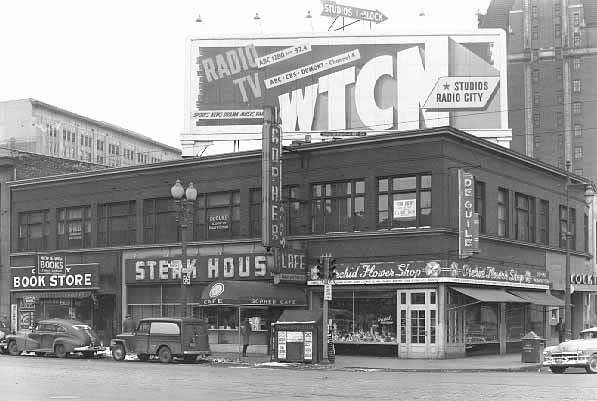
This billboard at 9th and Hennepin tells us that WTCN’s radio and TV studios were at Radio City. Photo dated February 23, 1950 courtesy Minnesota Historical Society
The ratings books from late 1953 to late 1955 identify programs by names of shows and names of DJs, and it’s a challenge to match them up. The names of the shows were pretty ambiguous:
- Knights of the Road
- 8 Steps Down
- Cloud Club
- Night Owls
- The Voice
- New Sounds For You
- Club Ten
- Club 1280
- Dancing Party
In most cases programs were identified by the names of the DJs:
- Jack Thayer was on three different times during the day
- Al Paulson
- Sev Widman
- Larry Fischer
- Don Doty
- Russ Kruse
- Frank Beutel – with a show called “Just Easy”
- Harry Zimmerman
- Jim Boysen
- John W. Vandercook
Personalities selling time in this 1953 broadcasting magazine were
- Jim Boysen
- Sev Widman
- Jimmy Delmont
- Jack Thayer
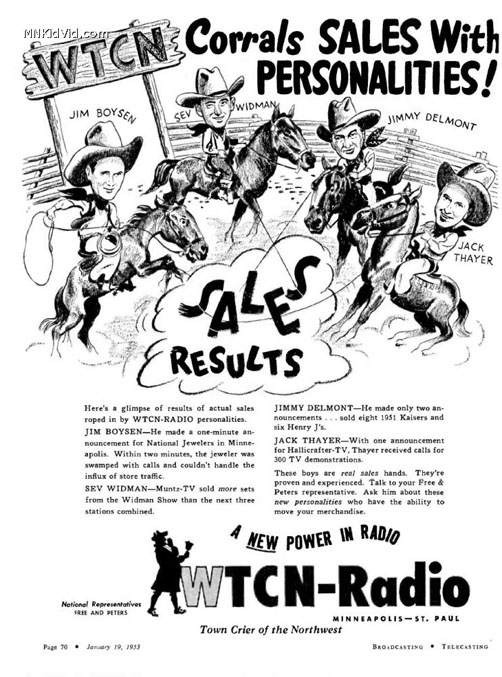
January 19, 1953 ad Courtesy mnkidvid.com
In 1956 the station was sold to the Crowell-Collier publishing firm.
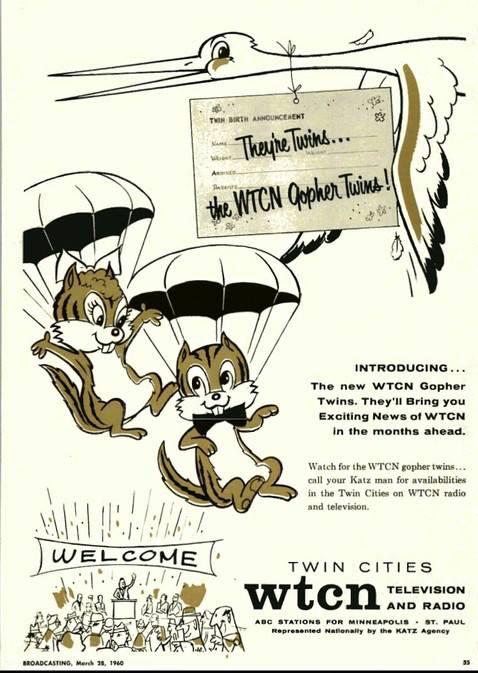
Broadcasting magazine, March 1960. Not sure what this is announcing.
In August 1962 the station was identifying itself as Time-Life Broadcasting Inc. At that time an ad appeared with the following text:
Now Coming in STRONG & CLEAR
What happened to wtcn 1280? Suddenly the voice of Metropolitan Radio is clear as a bell on the dial. Stronger, clearer than ever before. What happened makes a big diferencce to those who know and like good radio. Metropolitan Radio moved to a new site, and built a new and modern transmission facility (4-tower complex west of Highway 100 in St. Louis Park) – a broadcast service that brings it within clear signal range of thousands who could nevr before enjoy wtcn 1280 as easily as they wished. Try it yourself. Tune to the wtcn 1280 signal. When you hear it, you’ll find you’ve been missing enjoyable listening – Music, mature and distinguished, in distinctive settings and performance . . . Total information News, in-depth, authoritative, 1280’s programming for metropolitan listeners has long been one of radio’s finest. With the new sound of Metropolitan Radio coming in strong and clear, you’ll discover – perhaps for the first time – why so many more people are now enjoying wtcn 1280’s outstanding programs in the Twin Cities. Tune in, now . . . . Metropolitan Radio.
The station dropped its ABC affiliation on December 31, 1962 and began a format of light classical and easy listening, “The Sound of Beautiful Music” in March 1963.
The call letters of WTCN radio were changed to WWTC on October 2, 1964, after Time Life sold the station to Buckley-Jaeger Broadcasting. Because WTCN-TV was sold to a different company (Chris Craft Broadcast, Inc.), the two stations had to have different names. The TV station kept WTCN.
WRCR – 1010 kc
The Twin City a’ Go Go January 1966 issue mentioned this station and its DJs: Dean Alexander, Dave Charles, Will Grassman, Myrna Jean, Oliver Towne (nee Gareth Hebert), Don Riley, Bob Leonard, and Charles Conrad. A Billboard Magazine from July 9, 1966 shows that it was a 250-watt independent station operating 15 hours/day. The DJs chose the music, which was 80 percent “pop standard” and 20 percent “contemporary.” Donald Perry was the General Manager.
Jeff Lonto provides this info: “The station became WJSW “Polka Power” around 1969, and they picked up the WMIN call letters in November 1973 after being dropped a year earlier by 1400 AM. I actually have a WRCR pinback button that says ‘I’M A TEN-TEN TUNER WRCR 10-10 ST. PAUL, MINN.'”
WPBC – 980 kc
WPBC (People’s Broadcasting Co.) was owned and operated by Bill and Becky Ann Stewart and went on the air in October 1949. The Stewarts had worked at WCCO in various capacities since 1944. They built their studio on Stinson Blvd. in the Minneapolis northwest terminal district practically from scratch, and most of the personnel acted as stockholders, officers of the corporation, and on-air talent. The format on the 500 watt station was folksy to the point where it may have out-folksied WCCO.
I’ve been ignoring this station because I couldn’t believe that Bill and Becky Ann would ever broadcast anything resembling rock ‘n’ roll, but listen to this, from an article of the TV section of the Minneapolis Tribune, September 7, 1969:
Anybody who has heard WPBC in recent years might have found it ludicrous to have listed to founder-owner Bill Steward the other morning as he remembered the tough radio days of 1954 and 1955.
Radio was going through a fearful period in the face of the TV monster, and Stewart and his co-owner wife, Becky Ann, urgently called their staff together.
“We asked them what WPBC should be playing and it was almost unanimous that we should play the top 40, rock and roll,” Stewart recalled.
“I remember that the No. 1 tune was Ernie Ford singing ‘Mule Train,’ and can you imagine me calling from home on the phone that we weren’t playing ‘Mule Train’ often enough?” ….
“The turning point came one night around Christmas 1955 when we turned in the Tommy and Jimmy Dorsey Show on TV and they had on Elvis Presley,” Stewart remembered. “They predicted that he and his music would be the wave of the future, and when we heard what he sang and how he sang it, we began to be concerned. My wife and I had long discussions late into the evening.
“If we had to play junky music with morally degrading lyrics, we’d get out of the business.”
Well, they got out of the rock ‘n’ roll business but stayed in the radio business until November 1972, when the station was sold and became WYOO.
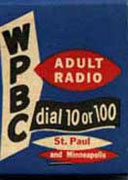
Save
WMIN – 1400kc
This venerable station was around for a long time, and occasionally tried on new names, including:
- WMNS
- KTWN
- KEEY
- KLBB (1981)
This page, like this website, sticks to pre-1975, and tries to focus on popular music.
The station began as WMIN in the summer of 1936, when St. Paul furniture retailer Edward Hoffman began broadcasting at 1370 kHz. In 1937 the station had a 15-minute program on Sundays featuring black singers that was advertised in the Minneapolis Spokesman. On December 9, 1938, Tom Coleman’s Famous Swing Trio, with Florence Ward, appeared at a dance at Pioneer Hall, 588 Rondo, advertised as being broadcast on WMIN’s Down Beat Program.
WMIN was reassigned to the 1400 kHz in 1941. Around that time, a young Leigh Kamman and his friend Sev Widman hosted “Studio Party Wham,” named after a Jimmie Lunceford tune, showcasing big bands, small combos, and jazz. Kamman produced live broadcasts from Mitch’s Roadhouse in Mendota and hung out at the Club Casino in the Hotel St. Paul where the big bands played. After the war, Kamman produced “We Call it Jazz” concerts at the Calhoun Beach Hotel and hosted “The Swing Club” on WLOL. Kamman left for New York in 1950.
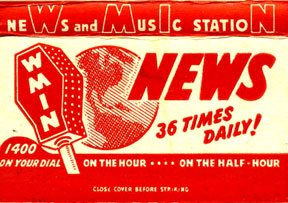
Matchbook images courtesy Pavek Museum of Broadcasting
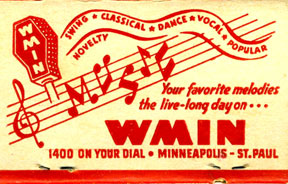
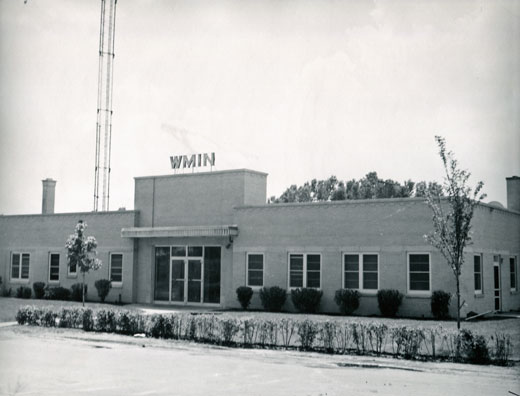
Courtesy Pavek Museum of Broadcasting
In July 1948, Chuck Mulkern had a fifteen-minute show called “Hillbilly Hits.”
From late 1953 to mid 1955 WMIN had tons of shows that might have included some jump tunes. While there were clearly some country/western shows – “Saturday Hoedown,” “Western Favorites” – and perhaps some old time songs – “Tin Pan Allan” was on a lot – there were others with intriguing names:
- Ralph (Smith) and His Records
- House of Records
- Top Tunes
- (Judy’s) Juke Box
- Your Rhythm Review
Most importantly, WMIN had three powerhouse disk jockeys:
-
Bill Diehl worked at WMIN from 1948-49 and from 1951-55. His shows were variously called “Diehl ‘n Music,” “Diehl’s Caravan,” and “It’s Your Diehl.”
-
Steve Cannon was at WMIN from 1949-54. Presumably the shows “Cannonball Express” and “Cannon Fodder” were his. In a column dated January 24, 1954, Will Jones of the Trib called Cannon a “Hep Talking radio disk jockey.”
-
Merle Edwards was at WMIN from 1949-55 and had shows like “Merle Edwards’ Caravan” and “Merle’s Mad House.” Bill Diehl tells the story that a car dealer called Slawik Motors wanted to sponsor a show, but it insisted that the DJ call himself “Hub Cap.” The station approached Diehl, but he thought the idea was ridiculous – he was a columnist for the St. Paul Pioneer Press, after all, and had a recognizable name. So they convinced Edwards to do it and he became Merle “Hub Cap” Edwards. David Hersk remembers that Edwards had a late night show where he called himself “Uncle Merle” and played plenty of rock ‘n’ roll in 1954-55. “I remember recording “Rock Around the Clock” from a WMIN broadcast on my Wilcox Gay recorder. Merle announced me when I called in, and gave me five seconds of dead air to start my home recorder at 78 rpm.” “Rock Around the Clock” was recorded in 1954 and became big news in 1955.
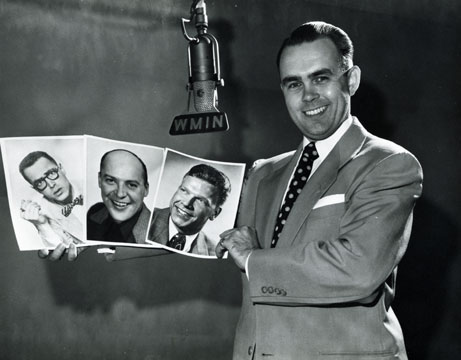
Stuart A. Lindman with photos of Steve Cannon, Merle “Hub Cap” Edwards, and Bill Diehl, 1949. Photo courtesy Pavek Museum of Broadcasting
WMNS
In 1954 the call sign for 1400 AM briefly changed to WMNS, reflecting a change to a full service format of music, news and sports. The call letters were changed back to WMIN later that year.
BACK TO WMIN
On November 8, 1954, WMIN hosted a four-hour remote from the new Melodee Record Shop at 704 Hennepin Ave., advertised in the Minneapolis Spokesman.
In September 1956 a Will Jones item in the Trib referred to WMIN as the anti-Presley station, with a DJ called “Alice Presley” playing Benny Goodman records.
By the end of 1956 WMIN was participating in the contest craze and calling itself “Music City.”
WMIN was still resisting the rock ‘n’ roll bandwagon in January 1957, when it was playing Easy Listening.
In April 1957 the station was owned by the Franklin Broadcasting Co., William F. Johns, Jr., Vice President and General Manager. Jack Hazlett was Station and Sales Manager, and Ralph R. Smith was Program Director. Studio and Transmitter were at 611 Frontenac Place, St. Paul. It had only 250 watts.
In 1957-58 WMIN put weekly ads in the Minneapolis Spokesman, the city’s black-owned newspaper, urging readers to listen to Lou House, possibly the only black DJ in the market. The “Lucky Lou” program was on Sundays and was described as “Jazz and Bits and Pieces of Music.”
We do know that the station was playing rock ‘n’ roll from the WMIN Top 40 dated August 4, 1958. The number 1 song that week was “When” by the Kalin Twins; Elvis had two songs, Ricky Nelson, Bobby Darin, and Duane Eddy were represented as well. But also Doris Day, Dean Martin, and Patti Page. The September 22, 1958 survey advertised “Down Beat,” the “Longest radio show in the Twin Cities.” It was also the “Twin Cities’ ONLY station with Future-Phonic Sound.” The disk jockeys were Ralf Smith, Jere Smith, Dan Allan, Jack Douglas, and Lou House.
NEWS
WMIN adopted an all news format in mid-July 1962. In September 1962 it was advertised as the only all news station in the country.
KTWN
In November 1962 the call letters were changed to KTWN. On December 10, 1962, the station launched one of those call-in shows where people argued with the host, who was called Norman Frederick. For his own protection, his real identity was kept secret. (Will Jones, Minneapolis Tribune)
In February 1963, familiar names Stanley Mack and Lou House were on the air.
Then this oddity shows up:
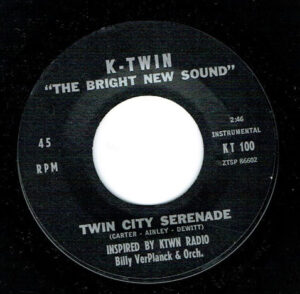
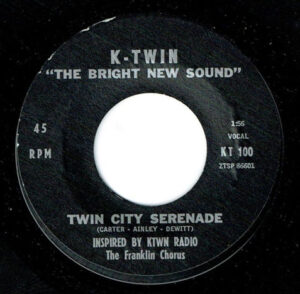
The photos of the 45 come from Discogs.com, which says that it was recorded in 1965, but that doesn’t compute with what’s below.
BACK TO WMIN
On June 3, 1963, KTWN began programming by its new owners, K-TWN, Inc., headed by Gene Posner, President of Cream City Broadcasting, Milwaukee. Cream City purchased the station from Franklin Broadcasting of New York. The daytimer station was authorized for 1,000 watts.
The new owners immediately requested permission from the FCC to change the call letters back to WMIN. Will Jones announced the change in his column on June 18, 1963, and said that the format would go to country/western, folk and ethnic programming.
Airchecks from 1964 indicate an emphasis on “news and prophesy.” Old Joe Clark played country music. “Yonny Yonson” played old time (polkas, waltzes and shoddiches) from 9 am to noon and 3-6 pm. The station’s address was 611 Frontenac Place in St. Paul.
In August, 1965, Texas Bill Strength went on the air at WMIN after being with KEYD/KEVE (1955 to 1958) and KTCR (1962 to 1965).
In 1967, WMIN went to full-time country.
KEEY
1400 AM changed its call letters again in January 1972 to KEEY AM, to match that of its FM sister station, and installed a soft rock format separate of the FM, which aired Beautiful Music.
KEEY seemed to specialize in handing out these FM radio station directories, which seem to me to advertise the competition more than anything else. I have a few examples, but don’t have the provenance – they probably came from Jeff Lonto. And although this page is about the AM station, what the heck. Also, they are not necessarily in the right order.
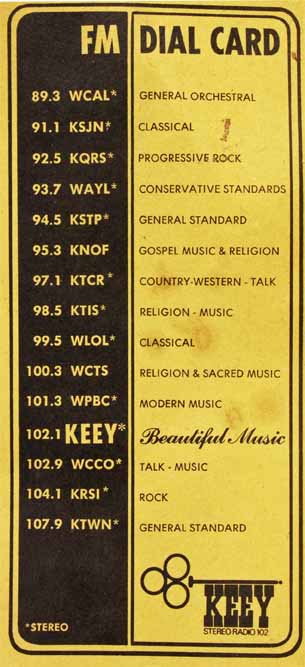
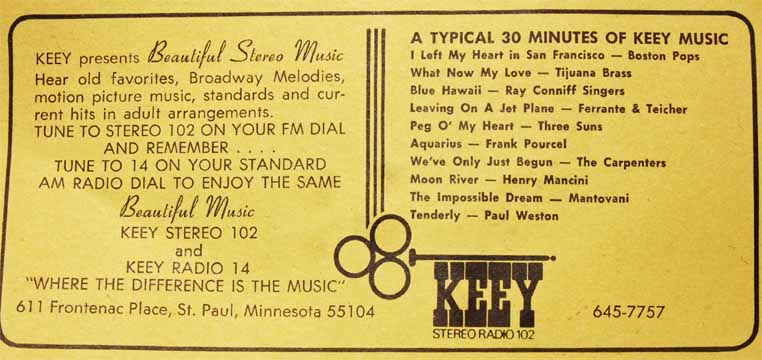
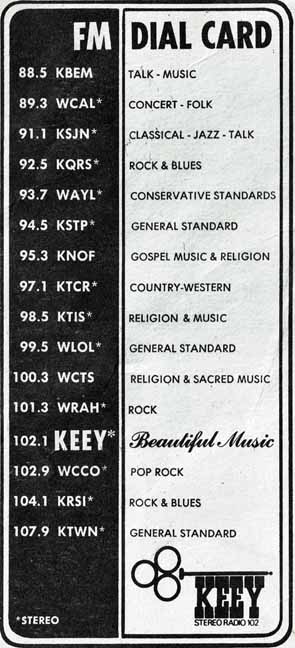
1973
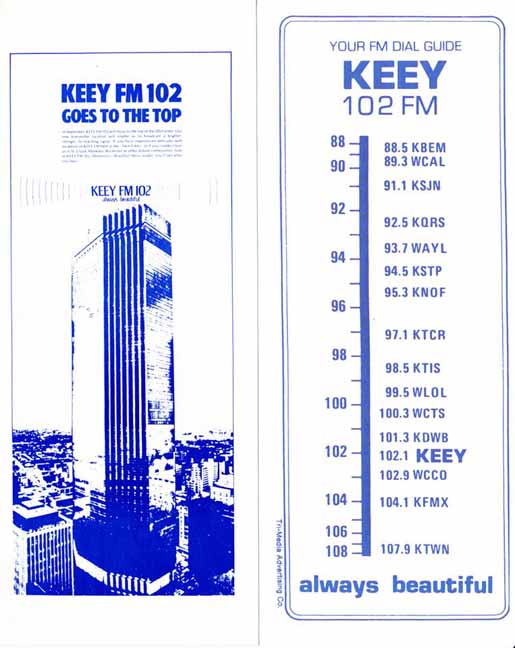
In about November 1973, the WMIN call letters moved to 1010kc (formerly polka and country station WJSW). The paper called the new WMIN’s format “variety.”
And fortunately I can stop at 1974, for there are greater minds than mine that can keep going past this Golden Age. Although I adored KLBB, which 1400AM took on in 1981.
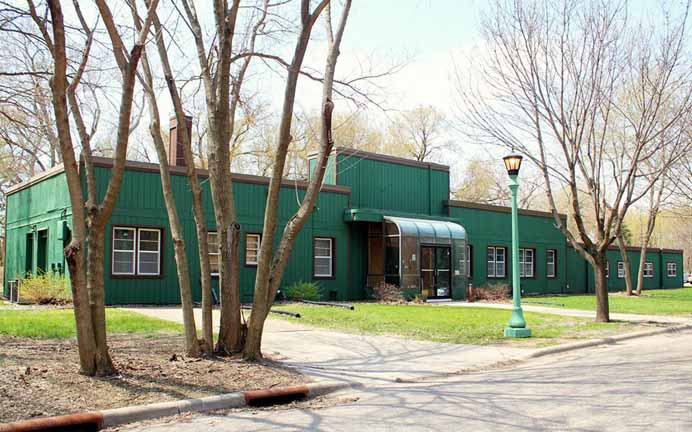
KLBB Building in 2014, courtesy Reed Hagen
For airchecks from WMIN, see http://twincitiesradioairchecks.com/wmin.html
Save
Save
WLOL – 1330 kc
WLOL first went on the air on June 6, 1940. Its first owners were John Devaney (Minnesota Supreme Court Justice?) and briefly Fred Osanna.

Early ad from December 1941.
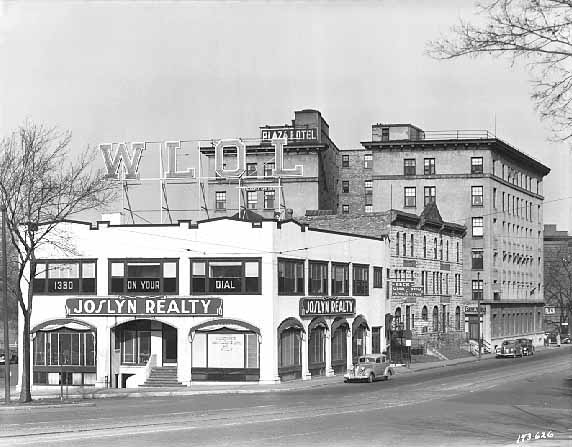
Hennepin Ave. looking towards Kenwood Pkwy. Photo dated November 6, 1942, courtesy Minnesota Historical Society
MUSIC GENRES
Apparently the station had a wide variety of programs.
One was the “Uncle Elmer Show.” A rural comedy production?
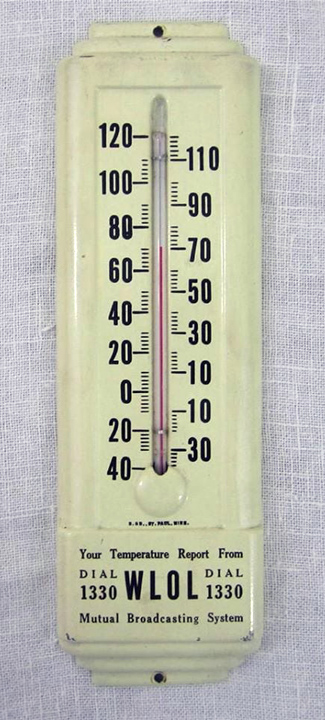
Thermometer posted on Facebook by Jay Arnold
R&B
Another genre could be nascent Rhythm & Blues. The photo below of broadcasters Kenneth Wilson (standing) and Albert Vant “Flash” Washington, dated to the 1940s, suggests that R&B was available at least part time to listeners in Minneapolis.
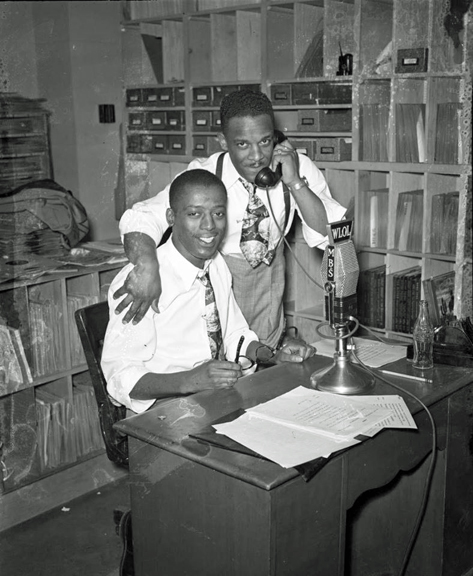
Photo by John Glanton, courtesy Hennepin County Library
JAZZ
From 1946-1950 Leigh Kamman and Bob Smith hosted the “We Call it Jazz” Program, featuring live performances from the Treasure Inn, Calhoun Beach Hotel, and Radisson Hotel downtown. Kamman also hosted the “Swing Club” Program. (Kamman left for New York in 1950 but came back to the station in 1956-58.)
CLASSICAL
In 1951 Ray Christenson was voted the “most popular classical and semi-classical disk jockey in the State of Minnesota.” At the time, Ray was also teaching diction to the students of Helen Stefan Model and Finishing School.
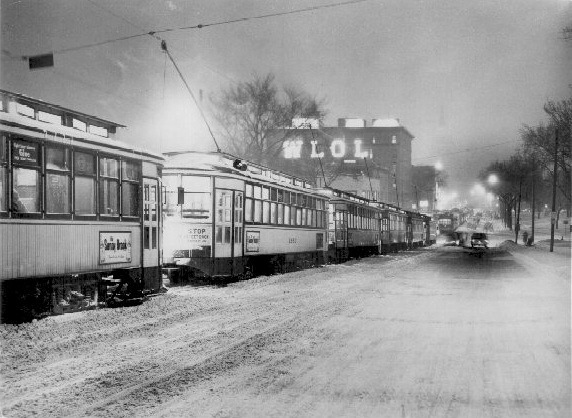
Hennepin Ave. at the Lyndale bottleneck looking north. Vineland Place and Oak Grove Street meet in front of WLOL with the Basilica of St. Mary visible in the background. 1951 Photo courtesy Minnesota Historical Society.
Although it’s unclear what WLOL was playing from late 1953 to mid 1955, the names of the shows are tantalizing:
- Top Tunes
- Tunes a Poppin’
- Parade of Hits
- Mr. Music
- Roy’s Record Shop
- Record Roundup
- Music Street
- Swing Club: David Hersk remembers Bob Bradley playing R&B in ’54 and ’55
- Melody Time
- Off the Record
- Today’s Hits
- Top Ten
- Hit Parade
- Avenue of Hits
- 18 Top Hits
1956: Rock ‘n’ Roll
A playlist from August 1956 shows that it was a major early rock ‘n’ roll station. The “Big 5” jocks were Bob Bradley, Leigh Kamman, Don Kelly, Steve Cannon, and Jerry Cunning. Jack Thayer had started his career here, from 1942-1951.
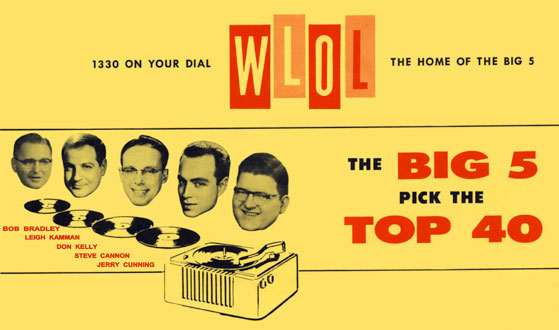
Top of a Top 40 from August 1956, courtesy of the Pavek Museum of Broadcasting
Radiotapes.com has airchecks from 1957 of Steve Cannon and Leigh Kamman doing what was billed as the Twin Cities first and only Double Disk Jockey Show.
The airchecks reflect a more middle-of-the-road format, but the Top 40 playlists from 1956-59 have a lot of rock ‘n’ roll (with a polka thrown in for good measure).
Jim Ramsburg says that in 1956 “we pulled our own music from the big record library with no rules or restrictions. Our studios were at the transmitter at [Seventh and] Davern Street in St. Paul and engineers played both records and commercials.”
In 1956 the station also participated in the big Contest Craze that hit most of the area’s radio stations.
In April 1957 the station was owned by the BFR Broadcasting Corp., N.L. “Larry” Bentson, President. Wayne “Red” Williams was Station Manager and Ray Christensen was Program Director. Ray left in June 1957 because he was too busy with baseball and was replaced by Jim Boysen.
In July 1957 Kamman was doing the noon to 2pm show from Southdale, just off the Garden Court. In November 1957 Jerry Cunning did Night Watch, “Twin Cities’ first all-night record party – Top 40 and then some” from 11 pm to 6 am. WLOL’s Swing Club had Dan Anderson on Saturdays from noon to 6 pm., also “Top 40 and then some.”
The WLOL Big 5 hosted the Royal Crown Cola Teen Roller Party at the Pastime Arena in St. Louis Park, Sundays from 2-5 pm, according to October and November 1957 music surveys.
In March 1958 WLOL hosted the Royal Crown Cola Bandstand at the Marigold Ballroom, with DJs Dan Anderson and Don Dahl, Sunday afternoons from 2 to 5pm. Admission was 50 cents and open to teens age 16 and over. “It’s the swinginest!”
In March 1958, WLOL’s catchphrases were “The Best Sound for Miles and Miles Around” and “Bigger, Better, Brighter than Ever.”
That spring the station presented Saints baseball with Ray Christensen.
A September 21, 1958 playlist shows jocks Bob Bradley, Tom Wynn, Jim Boysen, Dan Anderson, and Sandy Singer.
1964: UP Radio
The ad campaign for 1964 was UP radio (imagine an arrow on the UP). The text of the ad below, which comes courtesy of Jeff Lonto, reads:
WLOL’s catchy UP radio flavor has a way of titillating you with surprises. As an example when your unpredictable Carson Rennie of “6-10” spins a yarn about Aunt Julia’s first trip to the Twin Cities. Or when Bill Bennett “2-6” cuts in on Nancy Wilson’s “HOW GLAD I AM” to tell her about THE BOY FROM IMPANEMA. such tangy extras are part of ear-tickling, toe -tapping UP radio. Jerry Telser, “10-2” electrifying the afternoon airwaves…John Pete, “6-Midnight” seasoning your evening with top pop hits…wide-eyed George Murphy, holding sway with the “night people” from midnight to dawn. UP radio sparkles in Rod Trangard’s newscasts…in exclusive Mutual news “remotes” . . . in 1330’s exciting sportscasts and weather reports. That UP radio uplift – all the way. On WLOL.
Some notes about this copy. First, the typos are NOT mine this time. It’s Ipanema, not Impanema. Trongard, not Trangard. And if I were Nancy Wilson, I’d be a little ticked to have my song interrupted. Also, a fun fact is that in October 1964, “wide-eyed” George Murphy (something you can’t see on radio) became Dino Day and began hosting “A Date With Dino” on Channel 9 TV.
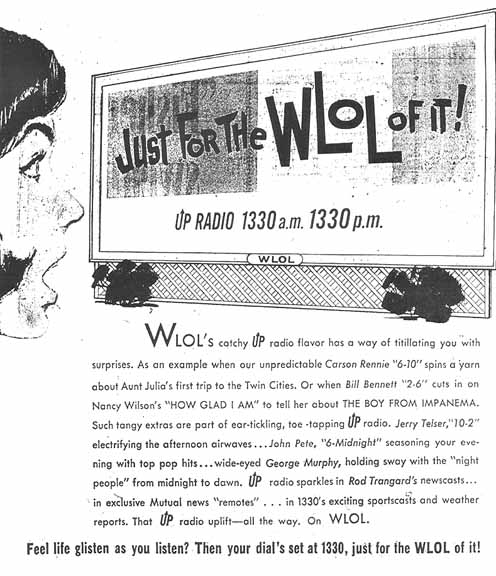
Minneapolis Star, August 28, 1964
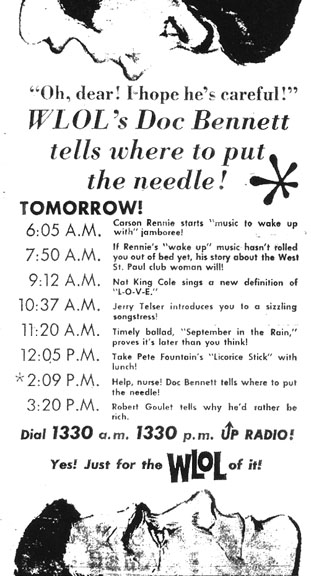
September 18, 1964. Ad courtesy Jeff Lonto
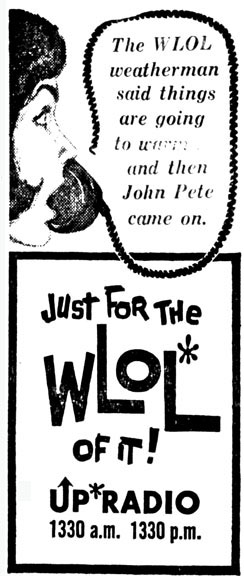
Minneapolis Star, December 21, 1964
1967: Talk Radio
WLOL-AM (“We Love Our Listeners”) was out of the rock ‘n’ roll market and became the Twin Cities’ first all-talk station in 1967.
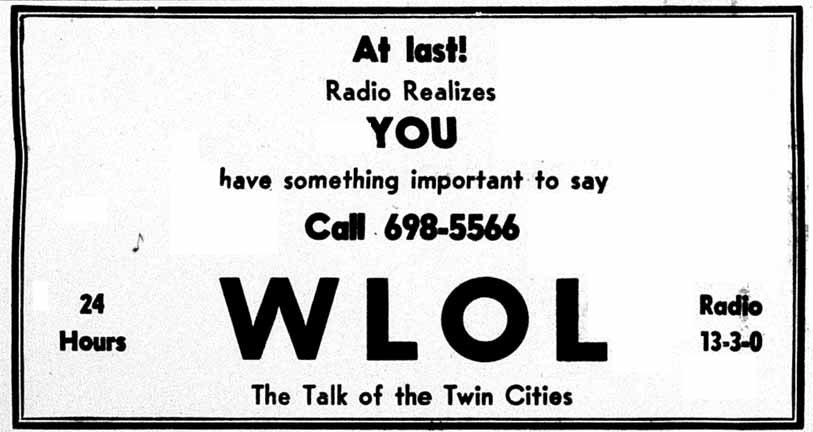
February 2, 1967
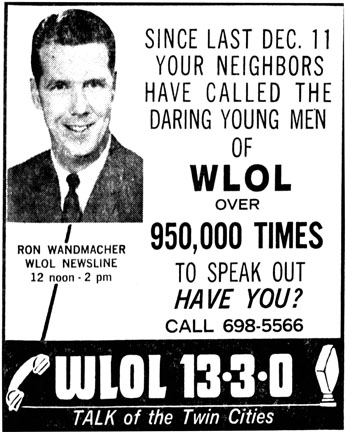
Minneapolis Tribune, April 24, 1968
1973: Country
From 1973 to 1976 it was strictly Country.
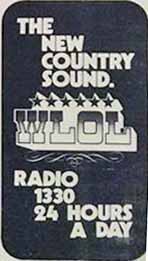
From a Program Log, courtesy Patrick Sweeney
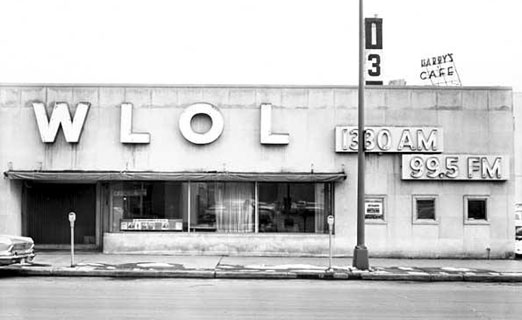
1021 LaSalle Ave., 1966. Photo courtesy Minnesota Historical Society
WLOL-FM
Although I don’t normally provide snapshots of FM stations, this one is pretty interesting.
WLOL-FM (99.5) (“Means Fine Music”) was up and running in 1956. Will Jones of the Trib noted on January 11, 1957, that the station suddenly decided to go to symphonic, opera and chamber music.
This is getting to be kind of a bandwagon, and a worthwhile one, even if it does come as a result of the desperate try-anything state of things in today’s radio business. When such a strictly-top-40 station as WLOL decides to go in for the classics, it smacks of chaos rather than culture. They promise “infrequent and low-tone commercial announcements.”
Music consultants included folks from the Minneapolis Symphony orchestra, Schmitt Music, and Leigh Kamman. Eight Miracle Mile merchants sponsored the program.
In a June 4, 1959, article in the St. Louis Park High School Echo, it was reported that the FM station would feature dance band music on Fridays and Saturdays. A spokesman for the station said:
We’re promoting a better brand of music because we believe that most teenagers are getting tired of rock ‘n’ roll. The music ranges from the swingtime of the late thirties to the jazz of today. It features the bands of Les Brown, Glenn Miller, Woody Herman, Sammy Kaye, Tommy and Jimmy Dorsey, Ray Anthony and Xavier Cugat. Although FM radio is not on many car radio dials, it is found on other radios and most of the new hi-fi and stereo sets. The WLOL staff believes that FM radio provides better reception and clearer tones than the AM frequencies.
A history of the station prepared much later explained that:
In 1956 the owners of WLOL AM added one of the first FM stations. The call letters were also WLOL. In November of 1957 WLOL brought stereophonic radio to the Twin Cities. WLOL FM and KUOM AM cooperated to create the stereophonic sound. A listener needed an FM radio tuned to WLOL and a “standard” radio tuned to KUOM for full stereophonic effect. The radios had to be placed at one end of a room 6-8 feet apart and the listener had to stand about 10-15 feet away. They used KUOM AM instead of WLOL AM because they did not want to scare away their AM Top 40 listeners by playing even only one hour of the FM’s classical music.
For a short-lived, rather obscure radio station, a lot of activity was logged. The studio and transmitter were located at 158 N. White Bear Ave., St. Paul. It had 5,000 watts, daytime only.
1956
WCOW was renamed WISK in May 1956, and affiliated with the Mutual network, late of WDGY.
The format changed from full-time Country & Western to a combination of Lombardo/Welk/etc. and an occasional Top 10 tune. This left KEYD (soon to become KEVE) as the only full time C&W station.
1957
A January 1957 ad touted “The Latest Platters with the Lightest Chatter” on Sam Sabean’s morning show “On the all new, brand new WISK.
Another January 1957 ad said “If You Dig Rhythm N’ Blues Mitchell’s the Most! Bob Mitchell’s show was on Saturdays from 1-5 PM.
In April 1957 the station was owned by BVM Broadcasting Co. and Victor Tedesco was General Manager, replacing Sam Sabean.
1958
After a year’s absence, Sam Sabean was hired back as a DJ and Station Manager, but he had to have a different name, so Sherwood was arbitrarily chosen. Jim Foster was the Program Director.
On October 10, 1958, the station was moved from 1590 to 630 kc (“Channel 63”). Mutual was dropped and the station adopted a “for women only” format. Jeff Lonto explains:
To plan a schedule of programming consisting of things women supposedly would like, the station hired male psychologist Dr. Jacob Berg, whom management said would provide “psychoanalyzed programming.” In addition, the new format included horoscopes, James Alden’s advice to the anguished and lovelorn, two-minute newscasts and editorials slanted toward the “woman’s point of view,” and 60-second lectures on sex, marriage and family problems. The station even gave trading stamps – three and a half million every week to listeners who called in at the right times. The “women’s” format bombed.

Ad courtesy Jeff Lonto
1959
In June 1959 the Tedescos sold the station to Crowell-Collier, owner of the legendary KFWB in Los Angeles. [In 1961, when the KFWB was having labor trouble, the owner shipped some Minnesota DJ’s to LA to cover.] Chuck Blore was Crowell-Collier’s national program director, and ran a disk jockey school that the DJs at KDWB attended.
WISK became KDWB
An invaluable source of information about the history of WDGY comes from a Masters Thesis written by Jerry Verne Haines in 1970.
1923 – 1926
DR. GEORGE YOUNG
Optometrist George W. Young started radio station KMFT in 1923; his first broadcast was on January 13, 1924 from his house at 2219 N. Bryant. The frequency was originally 1140 kc. After a couple of changes the call letters became WDGY (Dr. George Young) in 1926.
1927
In August 1927, WDGY’s transmitter was moved to Superior Blvd. and Falvey Cross Road [Wayzata Blvd. and Louisiana] in St. Louis Park. This was on the grounds of the U.S. Silver Fox Farm, at the very northern border of the Village.The document below is the application to move the transmitter in 1927.
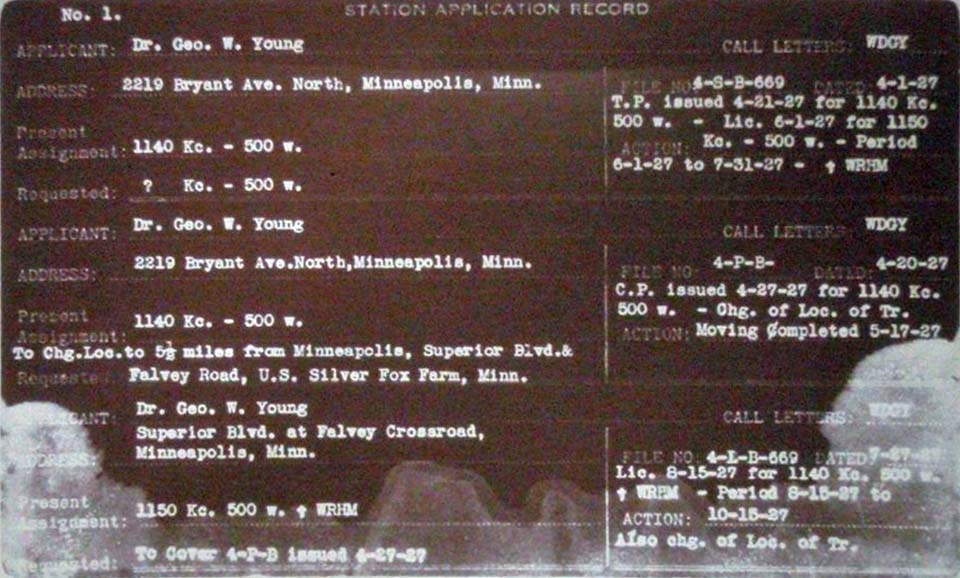
1929
In April 1929 the frequency apparently became 1180.
1933
The transmitter was destroyed by fire on February 23, 1933 and the station operated with WCCO’s old transmitter. In late 1935 a new non-directional 226 Truscan Steel Vertical Radiator (tower) was erected at the site.
1941
The station finally landed at the great 1130 on March 24, 1941, when all of the local stations were repositioned.
1945
Dr. Young died in 1945 and the station was transferred to the Twin City Broadcasting Corporation 1946. The station had a conglomeration of programs, ranging from waltzes, classical, show tunes, Tin Pan Alley, Hawaiian, religious, cowboy, and novelty.
1948
WDGY made remote broadcasts from Don Leary’s Record and Radio Store, 56 E. Hennepin (on Nicollet Island) in 1948. Bill Curtis (not Bill Kurtis of A&E) hosted “Don Leary’s Open House,” and an aircheck shows that they played a polka, country song, and jazz, and gave away an Ethel Waters record. The following photos, courtesy of the Pavek Museum of Broadcasting, show two of those appearances, although the years are unknown.
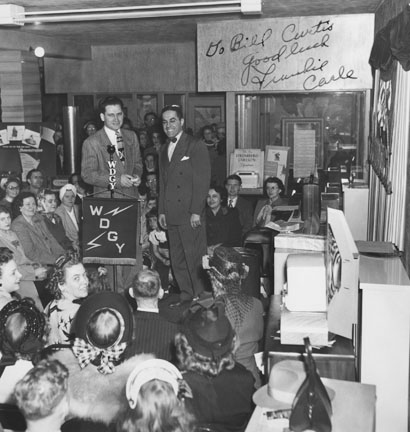
Don Leary and Frankie Carle
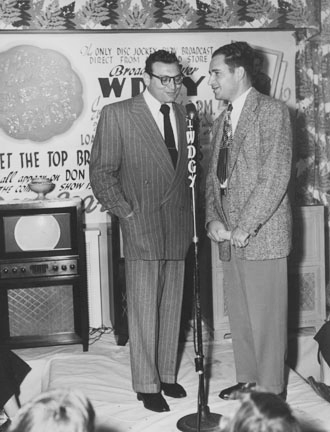
Frankie Laine and Bill Curtis
WDGY also had a “Sepia Serenade” program on Mondays and Wednesdays from 6:15-6:45 pm featuring “Negro recording stars.”
1949
An October 1949 ad in the Minneapolis Tribune called it “The Northwest Empire Station” and morning shows featured Irene and Lou, hillbilly favorites; Schuneman’s Red Rooster Hour; and Johnny Aarthun, popular singer of old-country songs.
MOVE TO BLOOMINGTON
In 1949 the station moved its transmitter and studio to a new multi-tower array described as at 102nd and Bloomington Freeway/Lyndale Freeway/35W. See the new transmitter here courtesy www.radiotapes.com
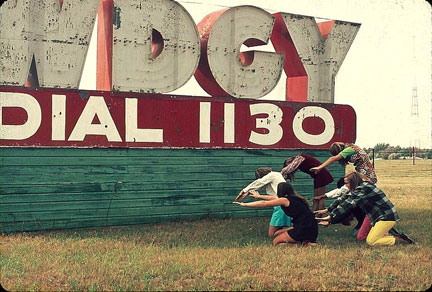
Photo by Zac Helmberger
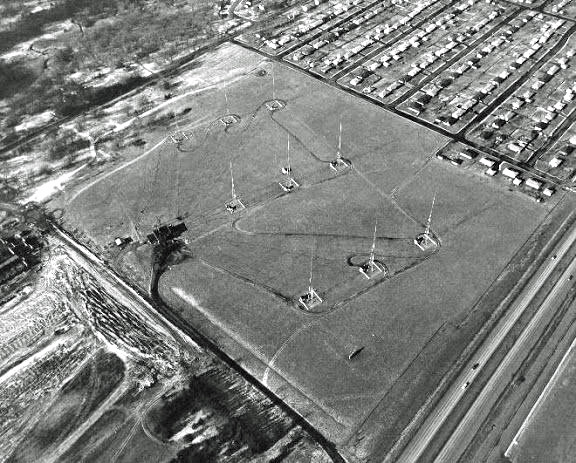
Aerial shot of the 9-tower array courtesy Tom Gavaras
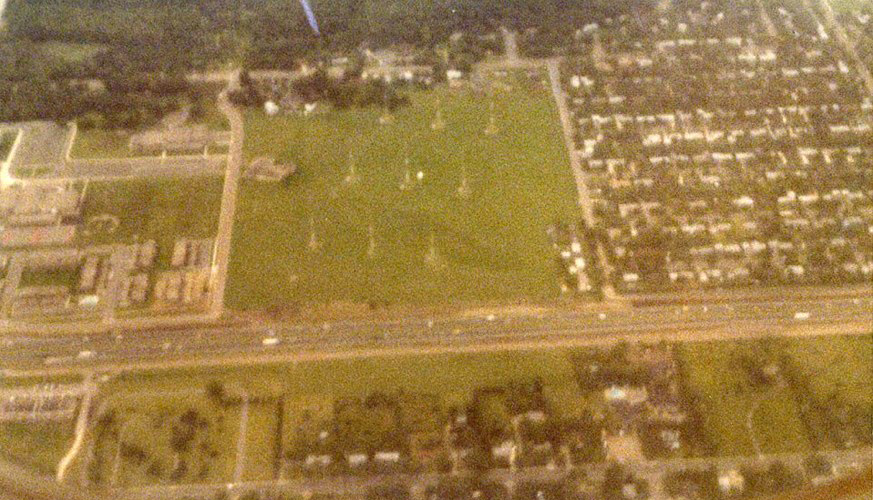
Courtesy Jay Philpott
Jay says:
This is a shot of the transmitter site of WDGY/1130AM radio, along 35W at about 102nd Street. I took this from a flight I took in 1977. The 9-tower array beaming 50,000 watts was used to produce one of the most restrictive signals in the USA. To protect stations also on 1130 to the south and east, most of the power was directed north. When constructed, a Bloomington transmitter location made sense as there was little development to the south at the time. At night (with 25,000 watts) you could hardly pick up the station 5 miles to the south of the site, but the signal had an effective radiated power of 300,000 watts to the north and went right over the North Pole into the Soviet Union. It was perhaps the only American commercial radio station the Russians had to jam to prevent their people from hearing all that decadent American Rock & Roll! Today, the station is KTLK, News/Talk 1130, and uses a transmitter site in Credit River Township.
Other Facebook stories of the strength of the transmission:
- One of the obstacles it ran into was resonating re-radiation from the Bloomington Water tower. The company engineers actually had to install coils to de-tune the water tower before the license could be approved for 50kw operation.
- Matt says: “I could get them on my Lloyd’s Transistor Six … when the batteries were dead.”
- Drew Durigan: “ I dated a girl who lived on Fremont Ave. between 101st & 102nd streets. They could hear WDGY all across the AM dial, at points on the FM dial, on their CB radio base station, on their telephone, on their electronic organ, and…(drum roll please)…on their TOASTER! No audio, but the wires would vibrate in time to the modulation. Never would have believed this if I hadn’t seen it with my own eyes!”
- Drew Durigan again: “ One more testament to the sheer effective radiated power in WDGY’s nighttime lobe. Our family cabin was located north of Park Rapids. At night, WDGY was very strong, but could never be received clearly. No matter what I did, the signal was always distorted. Years later, I learned the reason why. That beam was so strong that the GROUNDWAVE signal made it at night in addition to the skywave signal. Because the two signals arrived out of phase, they cancelled each other out. That’s what caused the severe distortion, despite registering a ‘4’ on my Wards Airline signal strength scale of 1 to 5.“
- Bruce Browning: “ Supposedly, a gentleman that lived within the main lobe of the pattern had decided to wind copper around his attic and, with an appropriate capacitor, made a tuned circuit at 1130 which allowed him to power his florescent lights. It was discovered during an antenna proof, when it was noticed there was a drop in signal strength in the main lobe and it was traced to this guy’s house. ”
1952
TWIN CITIES BROADCASTING CO.
In 1952 the station was sold to a group of four local businessmen, one of which was Clarence T. Hagman. Hagman had previously worked for WLOL, whose owner, Ralph Atlass, had adopted the “Top Forty” format during Hagman’s time there from 1947 to 1952. When Hagman moved to WDGY, he brought the Top Forty concept with him, as well as the Mutual Broadcasting System, which aired programs like “Queen for a Day” and “Sergeant Preston of the Yukon.”
1955
A schedule from April 1955 shows Eddie Cantor and a lot of “Springtime Serenade,” but also shows just identified by the DJ (Bill Rudd and Irv Smith put in a lot of time.). That November Ty Mack put in some hours, and it was now “Autumn Serenade.” Kash Box was apparently an advertising gimmick.
1956
TODD STORZ
Todd Storz was an heir to the Storz Beer Co. out of Omaha, Nebraska. 1936 ad below courtesy Jeff Lonto.
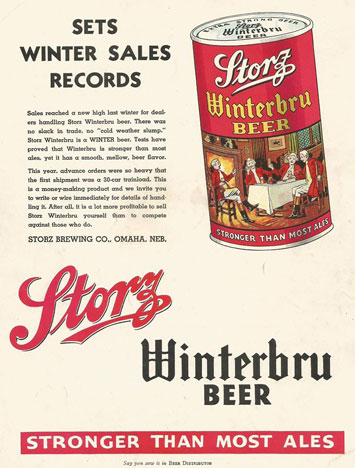
Storz’s company, Mid-Continent Broadcasting, purchased WDGY on February 6, 1956 for $212,000. It was Storz’s fourth station. The original WDGY DJs were Herb Oscar Anderson, Jack Thayer, Bill Bennett, Don Loughnane, Ralph Martin, and Len Bart. Storz also ended the affiliation with the Mutual network. (Storz died in 1964 at age 39.) Stephen B. Labunski was made General Manager. He left in July 1957 to become Vice President of ABC in New York and was replaced by Jack Thayer.
ROCK ‘N ‘ ROLL
Although we think of WDGY as the Twin Cities’ first rock ‘n’ roll station, it was not at all clear at the time. For his Master’s Thesis on the history of WDGY, Jerry Verne Haines interviewed WDGY announcer Leonard D. Bart on June 15, 1970. Haines wrote:
Rock and roll had a difficult entry into the Twin Cities market. The other stations had an unwritten agreement not to play “race music” because they assumed the Twin Cities audience would be outraged. When WDGY began to play it, WDGY salesmen found an amazing reluctance on the part of advertisers to buy time on a station that was rated number two in the market. The feeling seemed to be “we are not going to advertise on that station.”
Jim Ramsburg, an early WDGY jock, says “we were given strict orders never to utter the phrase, “Rock & Roll,” because it was black slang for sex. For that matter, we were discouraged from using the term “teenager” too. By that time Elvis had hit it big with “Heartbreak Hotel” and “Hound Dog” – a cover of a black record – followed. Covering black music was standard operating procedure in those days – Pat Boone made a fortune covering Fats Domino records. Finally, in the late 50s Sam Cooke broke the color barrier in the Midwest with “You Send Me” and black artists began to appear regularly on Top 40 charts. In summary, it was a conservative, white bread market with only a handful of stations in those days.”
TOP 40
Although many give Storz the credit for inventing the “Top 40” format, Haines asserts that it was already in place. What Storz did was apply the Top 40 concept to rock ‘n’ roll. Ramsburg says, “Let me put it this way – it was all show-biz. There’s a ton of stories circulating about Top 40 began – inspired by an Omaha tavern juke box, developed by a college statistical department, guided by BBDO’s Hit Parade formula for Lucky Strike – you name it. The fact of the matter is that 40 records plus a few extras (or extra commercials) conveniently fit into the three 55 minute periods that made up each afternoon’s Top 40 Show.” He also says that the concept of only playing 40 records was “blasphemy” in the business. He had to play the #1 song every hour, and the others at will. He’s still sick of “The Wayward Wind.”
As for where the lists came from, Ramsburg explains, “Juke box operators depended on Cash Box, which was a few weeks faster with sales figures than Billboard. Program directors like me used the more exclusive Gavin Report from Bill and Janet Gavin in San Francisco. The Gavins sold their mimeographed service to one station per market and it was kind of a co-op into which we all poured our tips. It made for a very fast, progressive Top 40 and far less corrupt than sales lists that could be influenced by cases of free product which is how payola really worked.” Even among Storz stations, Ramsburg says that each individual station made up its own Top 40. “The only coordination was (sometimes) the Pick Hit of The Week as a freebie to a record maker.”
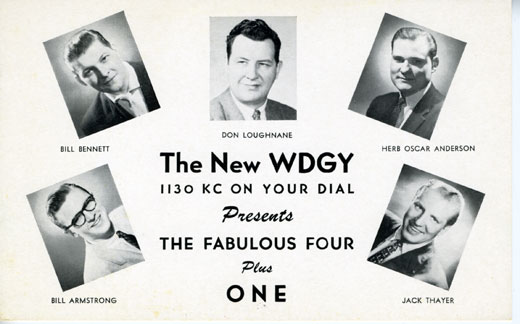
Airchecks from 1955 – ’57 on www.radiotapes.com seem to indicate that the music was pretty middle-of-the-road, but they did play “Hound Dog” on September 7, 1956 – “It’s #1!” The station was DJ-driven, with a July 2, 1956 ad touting the “Fabulous 4+1: Herb Oscar Anderson, Don Loughnane, Jack Thayer, Bill Armstrong, and Bill Bennett. At the time it was billed as “The New WDGY – Your Radioactive Station!” Top 40s available from July 21, 1956 on do show that the playlist was definitely rock ‘n’ roll, although they played a lot of cover versions and a lot of “schmaltz.” One song in ’57 looks suspiciously local: “Paddlin’ Ingabord Home” by “Ole” The Singing Janitor.
A memo to the staff from Todd Storz dated May 28, 1956, singles out the gang at WDGY for a job well done. “Minneapolis has been kind of a combination rat race and three ring circus since the “New WDGY” started, but the tremendous amount of work being done is paying off in increased ratings and business every month. In the first few months of operation, I would guess that WDGY probably lost as much money per month as any station in the history of radio. This month the losses should be fairly slight and we have every hope that June will see the station in the black for the first time in a long time. While a lot of money has gone down the drain, it looks like it has been well spent since the station is gaining solid acclaim in the Twin Cities, and some of the money should start to come back in over a period of the next few years.”
One fun item is from a Storz Stations Engineering Newsletter dated November 20, 1956. “All stations will soon be equipped with an echo chamber for ‘ON AIR’ use. A Hammond RK4 reverberation unit has been ordered… The echo unit will be .. controlled by push buttons installed at the news table and console. It is imperative that this unit be installed as soon as possible when received.”
An envelope dated October 1, 1956, is addressed to 10350 Fremont Ave. So., Minneapolis, 5, MN.
1957
In April 1957 the studio was in the Builders Exchange Building in downtown Minneapolis, and the transmitter was described as WDGY Transmitter Plant, Oxboro, Minn. It had 50,000 watts during the day and 25,000 at night.
1958
THE RADIO WONDERS
As a promotion, in November 1958 Jim Ramsburg cooked up the Radio Wonders basketball team. WDGY Jocks teamed up with professionals Ed Kalafat, Bobby Cox, Jim Springer, and Corky Devlin, possibly former Minneapolis Lakers. The team could not play high school and college teams, but would go out to small towns for exhibition games. Some not so happily as others, he admits. Proceeds would go to a charity mutually agreed upon by the two teams. The photo below, provided by Jim Ramsburg to the Pavek Museum of Broadcasting, shows Jack Thayer holding the ball. Clockwise from Jack are Bill Diehl, Don Kelly, Dan Daniel, Stanley Mack, and Ramsburg.
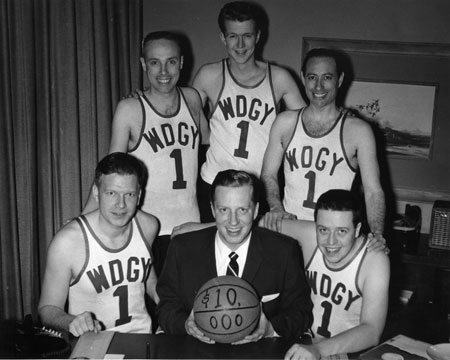
1961
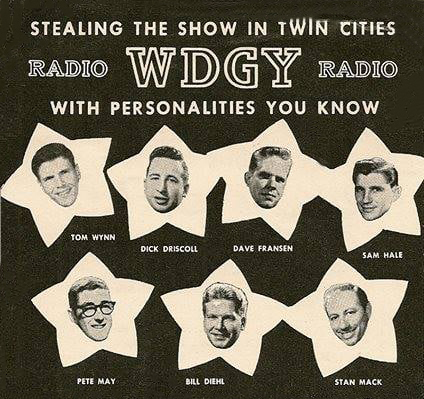
Top Jocks, 1961
“Wonderful WeeGee,” home of the “boss jocks” like Johnny Canton, hit its stride in the ‘60s, competing neck and neck with KDWB. WeeGee tended to be a little more conservative than KDWB – reportedly even their staff wore suits and ties, but that has been disputed. Seems to be half and half in the photo below, mid-1960s.
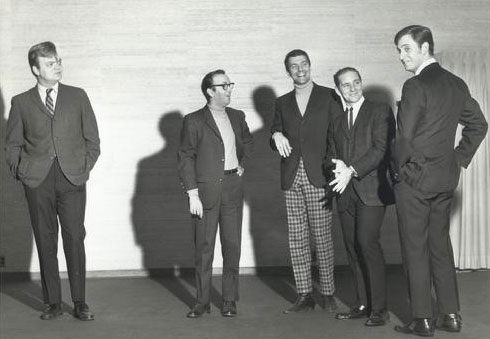
Jim Dandy, Perry St. John, Scott Burton, George Young, B. Mason Dean. Photo from Judy Dibble via Rick Burnett’s Twin Cities Radio Airchecks.
1962
In 1962 WDGY broadcast the Vikings games.
1966
See Top 30 and Top 40 countdowns from 1966 on Robb Henry’s blog.
From the “Yesterhits of Yesterday” compilation issued in 1967:
In June of 1966, WDGY began programming Much More Music for its listeners in the Twin City Area. Much More Music is simply that … WDGY played, and is playing, more music with the bright pace of the modern sound. To celebrate its first anniversary, WDGY is happy to present this album of … “YESTERHITS FROM YESTERDAY.” It includes a collection of twelve of the greatest hits from the last year. Each one of these selections was especially chosen by the WDGY All-Americans, and is performed by the original recording artists. We hope you will enjoy our first birthday edition … “YESTERHITS FROM YESTERDAY” … and join us in listening to the second year of Much More Music on 1130 Radio … WDGY.
As part of the anniversary celebration, listeners were urged to send the station a birthday card with a favorite song from the last year, and if it was drawn the listener could win the “Yesterhits” Souvenir Album and a chance of winning one of six Hondas. In 1967, winning a Honda might have meant just a motorbike.
THE PUT ON MOBILE
Somewhere there’s a story about how a station staffer would drive a dune buggy around town, and the listener who guessed closest to the number of miles driven at the end of the summer won the vehicle. I’ll tell it right when I find it again. Here’s one of the dune buggies.
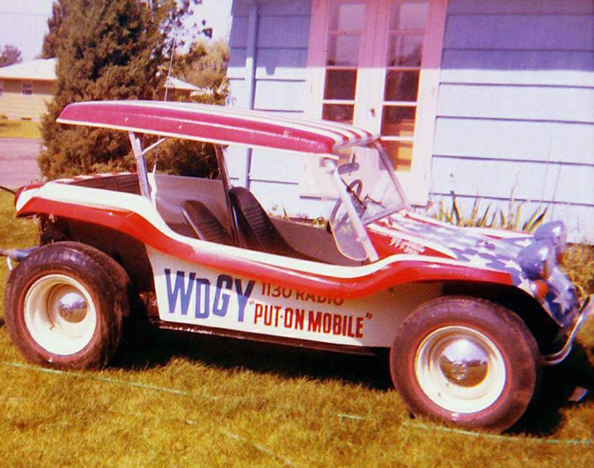
1970
From an ad from May 1970: “WDGY…A Touch of Taste.”
1972
A 1972 article in the St. Louis Park Echo opined that KDWB played new songs that were just released, while WDGY only played nationally-established music.
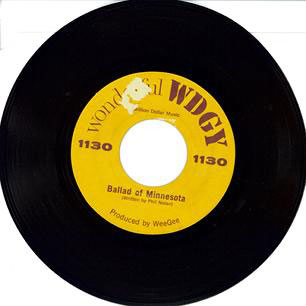
Found on Radiotapes.com: “Ballad of Minnesota!”
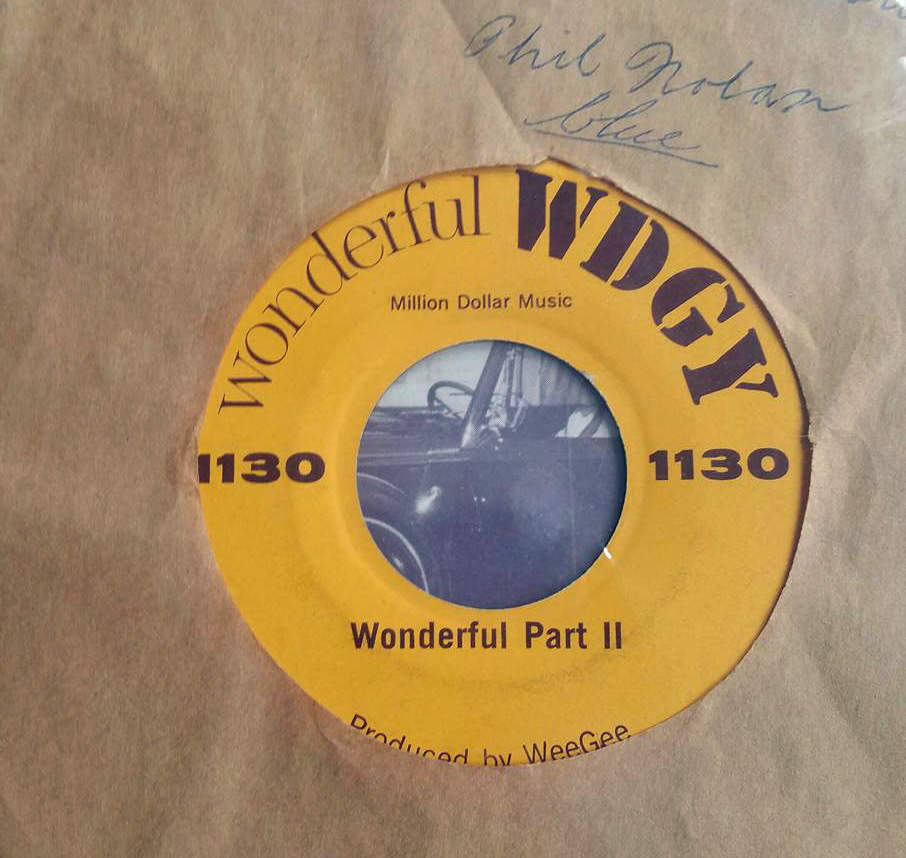
Side B
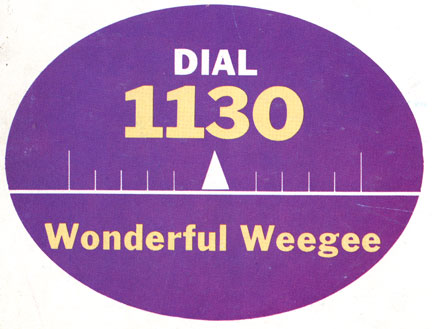
1976-1977
AOR – FOR A MOMENT: Y-11
In late 1976/early 1977, the station rebranded itself as Y-11 (never losing its WDGY call letters) and switched to a progressive rock, album-oriented format. The exact date of the change seems a little murky (unlike the very sharp change to country below), but experts say it was probably in January 1977. The music was tailored to a more mature (18-25) audience, such as Pablo Cruise.

Radio and Records magazine, March 18, 1977, courtesy Todd Mitchell
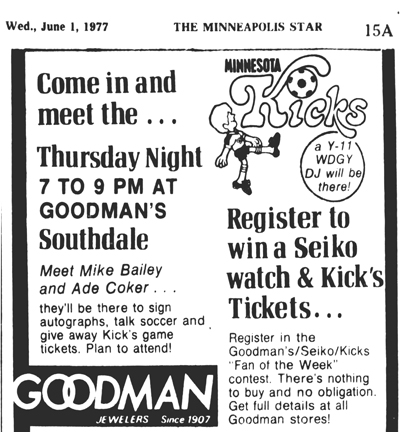
Only reference to Y-11 that came up in a search of the Strib
Todd Mitchell found this article in the March 18, 1977, issue of Radio and Records, an industry newspaper.
WDGY/Minneapolis Changes to AOR
WDGY/Minneapolis has modified its Top 40 format to an AOR-slanted approach. The station will feature top cuts from current albums along with a selection of singles, with no jingle package and segued sets. According to PD Chuck Roberts, the new format “is closer to AOR than Top 40 radio. The term we are using to describe this particular form of AOR is “Coloradio.” Our research and general observations indicate that this is the direction of AM Top 40 radio, so we may as well start now.”
The switch resulted in low ratings, according to an article in the Star Tribune on September 3, 1977.
Drew Durigan’s take:
Seriously, who thought progressive rock on AM was a good idea? I’m guessing that KAAY’s “Beaker Street” was influential here. But that was overnights (considered a throwaway daypart by management) on a 50,000 watt station that reached from Canada to Cuba.
By 1977, FM radio had arrived big-time in MSP. KDWB’s listeners were gradually migrating to the FM signal. KQRS was close to adopting the SuperStars format, making them a major player. KS95 was beginning to take hold. How could this format possibly be a winner on AM?
“The Future is Now (bbzztt) The Future is Y-11”
WDGY GOES COUNTRY
At 3 pm, September 2, 1977, the station changed its format again, this time to country. The switch was preceded by a five minute retrospective radio collage of the history of WDGY, and the first song played was John Denver’s “Thank God I’m a Country Boy.”
In a blurb in the Minneapolis Star (September 1, 1977), station manager Dale Webber was quoted as saying the reason for the change was “getting out of the ridiculous Top 40 market.” There were three other country stations on AM in the market at the time.

The photo below was posted on Facebook by Paul Strickland, who says,
Here’s a group shot of the Country WDGY airstaff from late 1978 or early 1979, taken at a Conway Twitty concert at the Minneapolis Auditorium. The most interesting thing about working there at the time was feeling the surge of relevance the station had regained on since taking on the Country format. Most Top 40 and Rock listening had migrated to the FM band (which had necessitated the Mighty 1130’s switch in the first place.) But the Country format was gaining acceptance among older baby-boomers and melding that growth with WDGY’s big 50,000-watt signal gave new purpose to the station – and validation to a growing, willing audience that perhaps Country music’s time was coming.
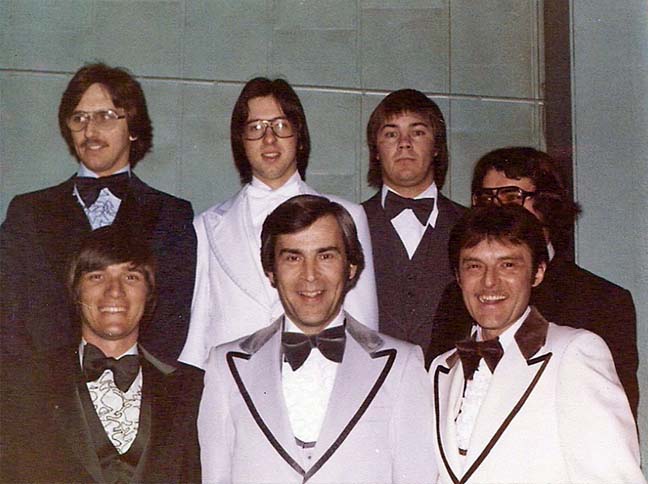
Bottom Row: Dan Halyburton, Larry E. Cummins, Jimmy Reed.
Top Row: Step Up Movie, Steve Highsmith, Gregg Lindahl, Paul Johnson.
See www.radiotapes.com/WDGY.html for airchecks and much more, including the very entertaining history of the station written by Haines.
More great stuff is on http://twincitiesradioairchecks.com/wdgy1130tapes.html
Save
Save
WCOW
The precursor to KDWB was founded in 1951 by Nick, Vic and Al Tedesco, sons of Italian immigrants from the province of Calabria. They were born in St. Paul’s Swede Hollow. From the early 1940s to the early ’70s the brothers owned and operated 11 radio stations throughout the Upper Midwest.
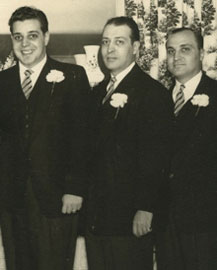
Al, Nick, and Vic Tedesco, photo courtesy Pavek Museum of Broadcasting
Reinhard Steinley became the first General Manager of WCOW on July 1, 1951. The station was located at 8th and Wabasha in South St. Paul, conveniently adjacent to the stockyards. Brother Al Tedesco wanted to call it WPIG or WHOG, but Vic protested the barnyard connotation. Nick came up with WCOW, which was deemed somehow “more dignified.” It was also appropriate: their records were labeled either O for Old Time or W for Western. Guy Lombardo records were used as a transition between the hillbilly songs and religious programs, reported Will Jones in the Trib on August 18, 1952. The station signed on with a cowbell.
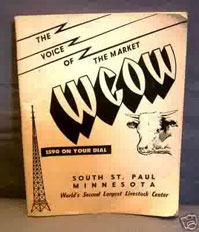
In 1952 everyone on the staff had a corny western name:
- Rodeo Ralf Smith
- Arizona Al Tedesco
- Valley City Vic Tedesco
- Nevada Nick Tedesco
- Denver Don Doty
- Buffalo Bob Montgomery
- Jolly Joe Zingale
- Sidesaddle Sore Sam Sabean
- Packhorse/Pecos Paul Denault -There was also a Packhorse Paul and/or a Pecos Paul – same guy?
Sam Sabean (aka Sam Sherwood) started out with the Sam Sabean Show in 1954, which became Hobo Sam and His Bum Program from about November 1954-March 1955. From there he went on to be Milkman Sam until about 1956.
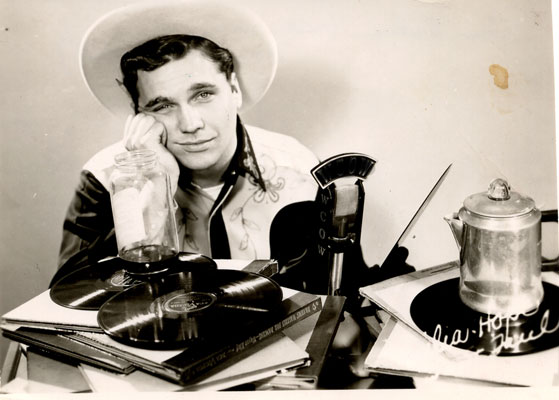
This one, courtesy Sam Sabean, is entitled “Hobo Sam and His Bum Program”
The early shows were pretty clearly just country/western affairs:
- Remotes from Schlief’s Little City
- A daily show dedicated to Whoopie John records
- Rhythm Roundup
- Radio Ranch
- Western Hit Parade
- Frankie Yankovic
- Cow’s Tail (wonder what that was?)
In 1955 there were some new shows:
- Grove Nite Club
- Serenade in Blue
- Beach Party
- Disc Derby
Most importantly, in March/April 1955 there appeared “Mr. Rhythm,” a/k/a Joe Zingale, who played an honest-to-goodness Rhythm & Blues show, according to Sam Sherwood. Read more about the show in 1955, and about Zingale under Twin Cities Disc Jockeys.

Here is a newspaper ad from Sam Sabean of the WCOW jocks from 1955.
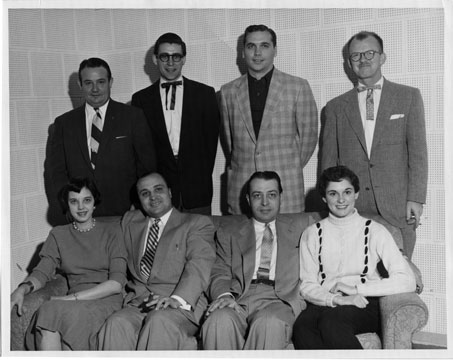
WCOW Staff @ 1953, courtesy Vic Tedesco. Top Row: Arnie Peterson (sports), Gene Taylor, Sam Sabean, Jack Douglas. Bottom Row: Jenny Rein (secretary), Vic, Nick, ?
WCOW became WISK
Save
KUXL – 1570 kc
Unlike most metropolitan areas, the Twin Cities did not have a black radio station in the 1940s or ’50s. Minneapolis’ black population had been consistently at or below 1 percent from 1870 to 1940. In 1950 it was 1.3 percent, and in 1960 it grew to 2.5 percent. It wasn’t until 1964 that the community could support a station that played music that was primarily by and for the black community, and by that time young white listeners were embracing black music as well.
MOST NEGRO OWNED RADIO STATIONS INSULT TO RACE IS CLAIM
What would a black station been like if we had had one in the 1950s? Interestingly enough, in my KUXL file I found an article from the Minneapolis Spokesman, the black community’s weekly newspaper, dated December 26, 1958. It discussed an article in the December 3, 1958 issue of Variety, in which Richard J. Miller, president of St. Louis radio station KXLW claimed that:
most Negro emphasis radio is a cheap insult to Negroes, a source of self-generated bigotry, religious quackery, charlatanism, and a wallow of ugly, primitive and harmful sounds. Any white man who lingers momentarily over a Negro emphasis station hears poor programming and crummy talk, he hears low down music, and is left with the strong impression that they are really different.
Miller estimated that there were an estimated 70 radio stations in the U.S. that programmed entirely for blacks, but felt that there weren’t more than a half-dozen of them that were sincere and tried to “program up” rather than “shoot down.” Announcers on white stations used their own names, while black DJ’s were given “the name of a clown, a name in keeping with the false and grotesque stereotype of the idiotic smiling Negro. He becomes Uncle Snuffy, Radio Daddy-O, The Cat Man.” He said that his stations was making a profit from its “enlightened” programming and others that followed are probably doing the same.
Food for thought.
THE LANPHIER ERA
Although Charles J. Lanphier of Milwaukee took out a construction permit for a new broadcast station on October 7, 1957, for some reason it took four years to be realized. The transmitter location was .3 miles north from the intersection of Sixth Ave. North and Highway 100 in Golden Valley, and the transmitter would be remotely controlled from the studio. The action was finally granted on July 19, 1961.
The new station would be broadcast at 1570 kilocycles, way at the top of the AM dial, at only 500 watts, daytime only. The address of the first transmitter and main studio was 7711 Sixth Ave. No. in Golden Valley, across from the Point Supper Club. This address doesn’t exist as Highway 55 was expanded.
On November 7, 1961, Will Jones reported in his entertainment column in the Minneapolis Tribune that the station was still awaiting its approval from the FCC to go on the air. It had hope to start broadcasting a week ago but was held up by equipment delays. Bad luck was cited, as it was the Twin Cities’ 13th radio station, and Lanphier pointed out that if you added up 1570 it came to 13. Jones explained that Lanphier was a former Milwaukee radio and TV man, and would act as the station manager as well as owner.
On the same day, Forrest Powers, TV and Radio reporter for the Minneapolis Star, indicated that the station would start broadcasting that weekend.
The station’s schedule wasn’t printed in the Tribune until December 10, 1961.
STAFF
The station’s initial staff included:
- Hugh Cardenas, formerly with KRSI, served as program director.
- Mort Garren
- John Sewall
- Jack Hyatt was brought in from Los Angeles
The promotional piece below pictures the station’s initial staff.
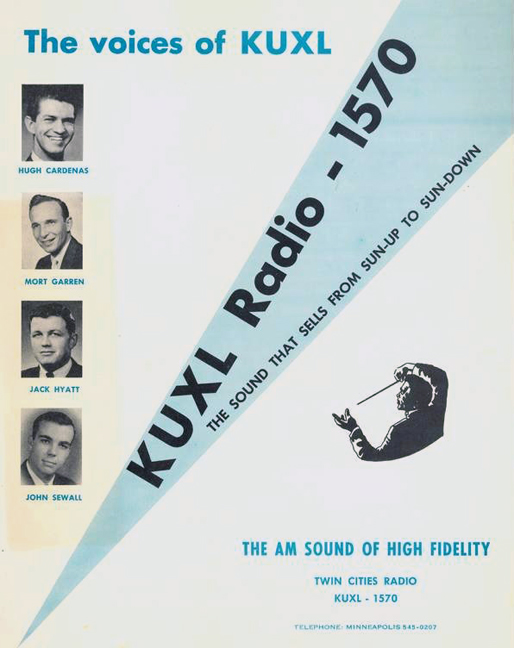
March 1, 1962
Below are the same four staff members that were pictured in the piece above, in a print ad.
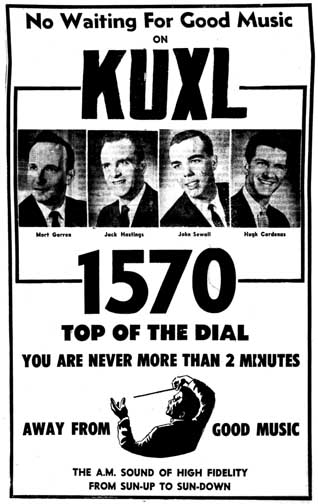
Minneapolis Herald, September 10, 1962
In April 1963, the listings showed Jerry Boyum on from 6 to 10 am, Mort Garren from 10 to 2 pm, and John Sewall from 2 to 7 pm. Long hours!
FORMAT
The music first played on KUXL was of the Percy Faith/David Rose/Henry Mancini/Peggy Lee/Bing Crosby/Lawrence Welk fare. Good music.
The format of the station is actually kind of ambiguous in this ad from the Minneapolis Daily Herald from September 13, 1962:
Radio is Sound!
KUXL Radio is a BETTER Sound
Hear it Yourself – Tune up to 1570 on your radio dial where you are never more than 2 minutes away from the Hi-Fi sound of good music, Associated Press news on the hour and half hour, latest in sports on the quarter hour.
You will enjoy tuning up to the quality sound of sound radio programming on KUXL. Top O’ The Radio Dial
Sun Up To Sun Down
The ad below was placed during the Cuban Missile Crisis:
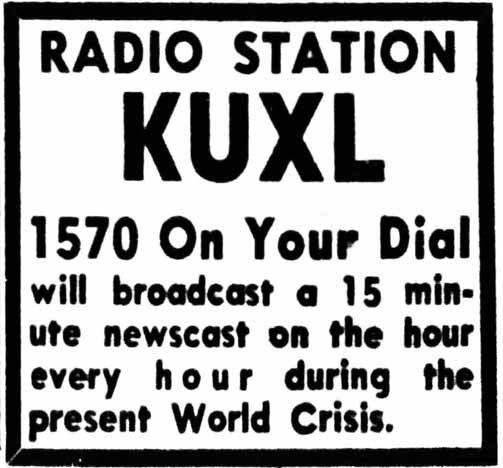
Minneapolis Tribune, October 24, 1962
AWARDS
The ad below is from the Minneapolis Herald, the replacement paper started when the Star and Tribune were on strike in 1962.
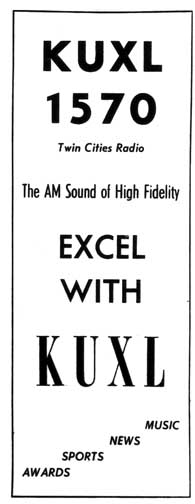
Minneapolis Herald, July 3, 1962
Note that one of the attributes of the station mentioned in the ad above is Awards.
The ad below boasts of their KUXL award for excellence in musical instruction.
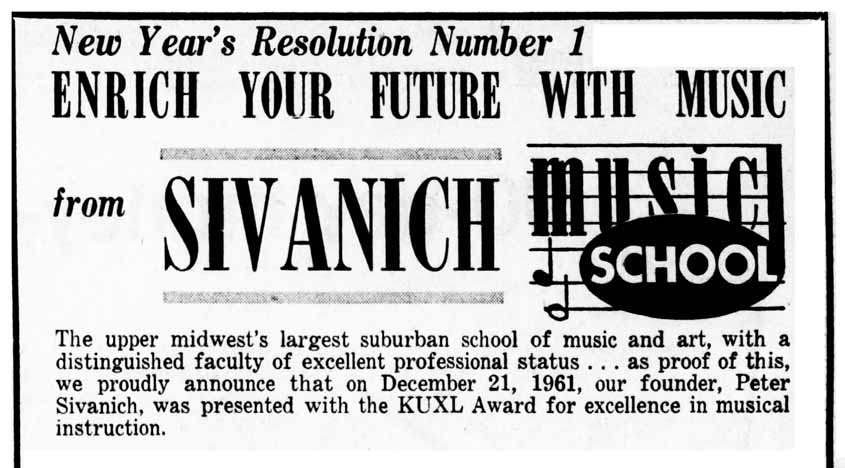
Minneapolis Tribune, January 7, 1962
Alan Freed found another award made by the station to the American Legion North Side Post on May 1, 1962, for Excellence in Community Service.
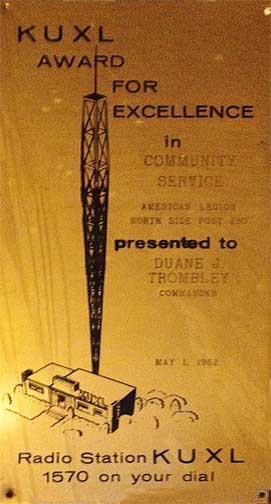
Image courtesy Alan Freed
1963
ED SKOTCH AND GREATER HAPPINESS
On August 19, 1963, the station’s license was voluntarily assigned to Edward D. Skotch.
On August 28, Will Jones published an extended interview with Skotch. Jones described him as a “mild-mannered, blond, pipe-smoking sort,” who grew up in Chicago and worked in radio as a writer, director, and producer on radio shows and in TV when that city was its center of the early days. Skotch was the highest-paid director-producer in Chicago, with as many as six shows he created, network and local, being aired in town every week.
“Big Time TV” left Chicago and so did Skotch, going out to the West Coast and working as a director until he decided to get out of the rat race and become his own boss. With a couple of partners he bought a radio station in Cincinnati and turned it around, selling it at a profit. This time he was planning to do the same with KUXL, only without partners, using his life savings. “If it doesn’t do, I’ll be back in the rat race.”
Skotch’s idea was to create something new. Now that TV had grabbed everyone’s attention, and radio was just background music, he wanted to reverse the process and create “The Nation’s Most Attention-Programmed Station.” The key was to provide entertainment, but not with comedy or drama, but with ideas and thoughts. There were going to be 27 separate short entertainment features every day, ranging from the supernatural to what makes raindrops round.
Part of the plan was to tape all of the features for syndication and he figured there were 200 stations that could make good use of the material. He was in the middle of hiring, and was looking for a deep, authoritative, network kind of voice; a sirupy, romantic voice; and a thrid, more youthful and jolly voice. He’d also done some research in music therapy, and planned to play records for what they did for the listener.
He didn’t plan to start his new programming until he got a power increase from 500kw to 1,000kw. And as soon as he got that he would file for full-time operation and still more power.
He expected to shock some people that first day! He was keeping the call letters – their full potential had never been fully utilized. “K – You Excel. And we’ll supply material so that listeners can excel in certain areas of conversation.”
Meanwhile, the old KUXL crew was plodding on. September 7, 1963’s listings showed:
- “Oh What a Beautiful Morning” with Jim Eckert, 6 to 11 am
- “Melody Hall” with Mort Garren, 11 to 3 pm
- “Album Parade” with Jack Hyatt, 3 to 8 pm
But things were moving along. A construction permit was granted to install a new transmitter and a permit was granted to increase power to 1kw on October 1, 1963.
STATION TO BEFRIEND LONELY HOUSEWIVES
On October 3, 1963, Forrest Powers reported in the Star that
We’ll soon be the happiest group of radio listeners in the country. Last week Ed Skotch of KUXL announced plans to introduce features designed to cheer up the lonely housewives, and now Bill Stewart of WPBC says he has started a new format of “happy music” and other features of “make people feel better.”
For those who prefer to look on the gloomy side of things, there are always the daytime soap operas on television.
KUXL’s broadcast license was voluntarily assigned from Edward D. Skotch to Greater Happiness, Inc. (presumably his company) on October 7, 1963.
Forrest Powers published his own interview with Ed Skotch on October 7, 1963, in the Star. It held some interesting insights not revealed in the one Will Jones did (on August 18, above). the second line is pretty shocking: Skotch’s research concluded that the suburban housewife was a lonely person was too busy to hear her troubles and who tied herself in knots over small problems. His programming was designed to help said housewife by becoming an intimate, informative close friend that will cloud out the things that bug her. Skotch felt that once radio became a juke box and all talk was eliminated, the heart of radio was lost as well.
As a promotional gimmick, Skotch planned to distribute 100,000 “happiness charts,” which supposedly predicts the days when a person will feel cheerful or grumpy. He planned to conduct on-the-air “happiness” experiments twice a day.
Other short subjects would include “Can You Explain It?” a feature dealing with supernatural occurrences, and “Curiosity Corner,” a show touching on nature and science. The music would continue to be in the pop album category, but each selection would contribute to the pattern of feature material.
THE NEW, HAPPY KUXL
The ad below from the October 12, 1963, TV Forecast promises 72 daily features. The names of the programs may give an indication of what the station was like, apparently dispensing a lot of wisdom and advice. Those shows included:
- Questions Women Ask
- A Beautiful Thought
- Curiosity Corner
- I’d Like to Know
- My Favorite Funny
- Whiz Kid
- Unbelievable – Yet it Happened
- Inspirations for Daily Living
- Your Key to Happiness
- A Positive Outlook
- According to the Record
- Looking at Life
- I was Just Thinking
- This is Interesting
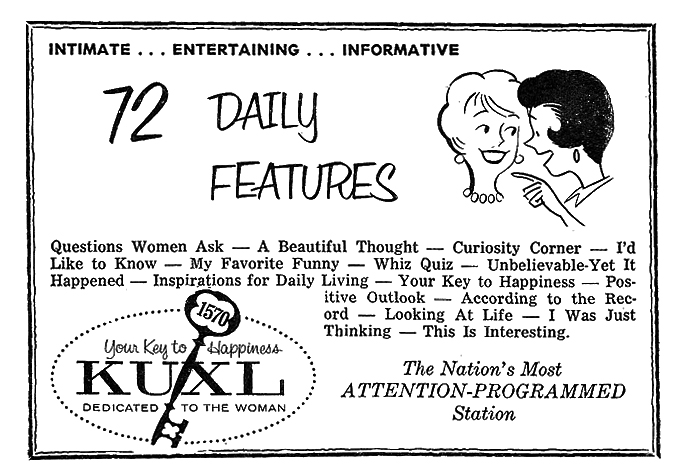
TV Forecast, October 12, 1963, courtesy Jeff Lonto
While newspaper listings are not 100 percent reliable, the Tribune’s listings of Monday, November 11, 1963, reflect the old format, with Jim Eckert from 6 to 11 am, Mort Garren from 11 to 3, and Jack Hyatt at 3.
Then, on Tuesday, November 12, 1963, we see a completely new kind of schedule – a Happiness Schedule!
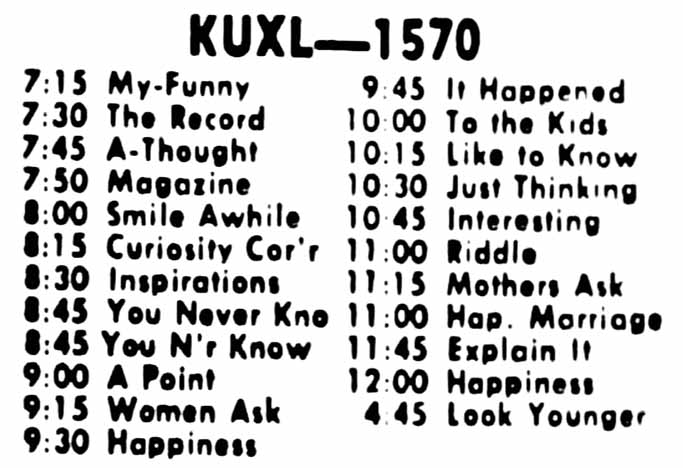
Minneapolis Tribune, November 12, 1963
GOLDEN VALLEY INN
The very next day, November 13, 1963, the station’s permit was approved to change its studio location and remote control point to the Golden Valley Inn, a motel at 4820 Olson Memorial Highway. That address does not compute, but below is a photo of the Holiday Motor Hotel, described as being taken in 1955. This may or may not be the building in another iteration.
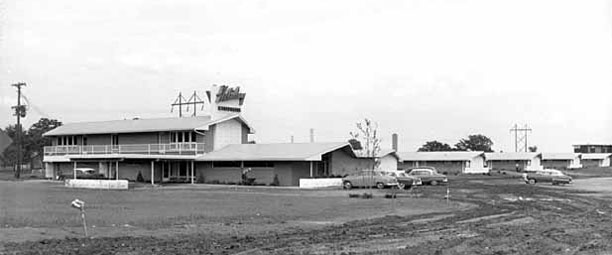
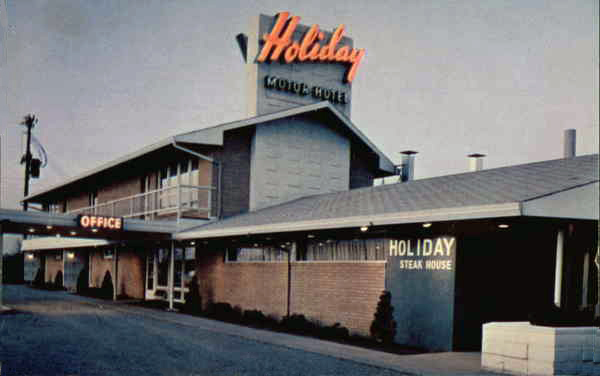
Another view of the Holiday Motor Hotel, Golden Valley
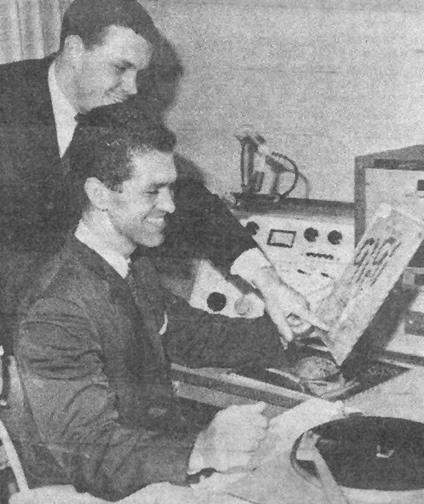
Jack Hyatt and Hugh Cardenas selecting records at the new studio in Golden Valley
POWER UP
Although the records say that KUXL was granted the license to increase its power to 1000 watts on October 1, 1963, Will Jones of the Tribune did not announce the approval until February 17, 1964.
On February 26, 1964, Randall Hobart of the Star reported that Ed Skotch credited his women-oriented programming for a 480 percent increase in business since he took over the station. Three “informative features” were broadcast every hour each day to draw attention to commercial messages. Tom G. Morris was promoted to station manager and Robert E. Bowdan was named sales supervisor. Hobart also announced the increase in power.
1964
This ad appeared in March 1964. Wonder what E.I.I. was?
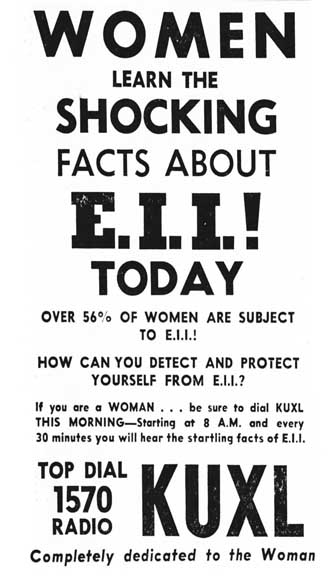
Minneapolis Tribune, March 2, 1964
Will Jones reported in his column on March 12, 1964:
Of all the new for-women-only features on KUXL, the station reports the ladies are most interested in a feature called “The Unbelievable, Yet it Happened.” It’s about the supernatural. (The station, planning to syndicate its features nationally, has been looking for a mature, friendly, relaxed male voice in these parts. So far, they say, they haven’t found one. Call them, not me…
Forrest Powers of the Star filed his report on March 17, 1964, explaining how Ed Skotch was doing market research with a group of 40 housewives.
Pleased by the response to a recent project on emotionally induced illness, Skotch said the station will devote another day to the subject in the near future. He also plans to start an on-the-air school dedicated to “enriching the personality of the housewife who finds herself bogged down by dishes and diapers.”
FINALLY, SOME JAZZ
The first we hear of programming that was not Percy Faith and not (by this 21st Century woman’s standards) patronizing, comes in mid 1964. The ever-blessed Will Jones announced on June 5, 1964:
KUXL is airing jazz. Engineer Herb Schoenbohm, a jazz buff, started by emceeing a nightly 7 – 7:30 pm spot. [made possible by the late summer daytime hours] Now he also does a Saturday afternoon session from 1 to 5. And the response has been so good that the weekday evening jazz time may be extended.
Don Morrison of the Star revealed even better news in his “2 Cents’ Worth” entertainment column on June 20, 1964. Leigh (pronounced Lay) Kamman had presented jazz shows for years, lately on KSTP radio until that station summarily fired him along with a number of longtime staff for some unknown reason. Kamman went to New York, but fortunately returned to present this gift to the Twin Cities. The music played was from Kamman’s own encyclopedic library of records, domestic and foreign. He promised:
One day it may be modern, the next day flavor of blues. It will be historical and contemporary, sweet, hot, lowdown, enlightened Chicago style or very cool.
Kamman’s show, called “KUXL Jazz Club,” began on Monday, June 22, and aired Monday through Friday 4 pm to sundown and at 5 pm on Saturdays following Herb Schoenbaum’s “Jazz Festival.”
A license to install a new transmitter was approved on June 29, 1964.
GOODBYE, LADIES
All we have are newspaper listings, but on Tuesday, July 7, 1964, there is a full day of Ed Skotch’s programming for women, from 6 am until 4 pm when jazz takes over. “Look Younger” is on twice.
Then on Wednesday, July 8, 1964, we’re back to the old KUXL! Paul Franklyn at 6 am, Jim Eckert at 9, Mort Garren at 11, Jim Eckert again at 1 pm, and Leigh Kamman at 4.
July 12, 1964, brought the advent of Arthur Hoehn, who would become Fat Daddy Washington as the station became more black oriented. On his first day found in the newspaper, he was on in front of the Polish Hour and the Methodist Church, both 90 minute shifts in the morning.
On October 16, 1964, Will Jones announced that:
Jazzman Rio Pardo has undertaken a new KUXL show, heard at 10:30 am each Saturday and Sunday, called “Flying Along With Rio.” He stresses soul-jazz and airs a bulletin-board feature for the Negro community.
The program was one half hour long and started on October 17, 1964.
It gets better: Will Jones reported on November 27, 1964, that Leigh Kamman and Herb Schoenbaum had turned KUXL into an all-jazz station and breathed new life into it.
Ed Skotch gave up the ghost on December 1, 1964, when he voluntarily assigned his license to Universal Broadcasting Co. of Minneapolis-St. Paul, Inc.
MARVIN KOSOFSKY
As usual, Will Jones spells it out for us in his column of December 10, 1964. The situation was very ironic when he talked about the “flash success” of KUXL in the jazz field.
One day the station was just there, offering gimmicky, women-slanted programs, not attracting much attention. [This was what Ed Skotch wanted to be “The Nation’s Most Attention-Programmed Station,” remember?] And then almost overnight, or so it seemed, the jazz folk around town were talking about their station.
Jones explained how Schoenbohm (whom he calls Dave for some reason) and Kamman had talked the management into limited hours for jazz, and then slowly increased. Meanwhile the station was being sold, and they moved over to KQRS (which was then KEVE) to continue playing jazz after dark fell and KUXL was off the air.
The new owner of KUXL, Universal Broadcasting, had its headquarters in Shreveport, Louisiana. Its president was Marvin Kosofsky, who said he was not going to change the jazz programming, which had been taken over by Art Hoehn and Paul Franklyn. But, neither was it going to be a full-time jazz station as some had hoped. Leigh Kamman left to join KEVE, which became KQRS. Mort Garren left but “stayed on at KMSP-TV,” so apparently he was working at both places.
Kosofsky owned several other stations that catered to listener minorities, and the company represented a string of 30 special-interest stations. He expressed his intent to present commercial religious shows in the morning [commercial meaning they pay for the time?]. He wanted ethnic shows in Polish, German, and Scandinavian.
In an interview given for the Rondo Oral History Project of the Minnesota Historical Society, Yusef Mgeni remembered that KUXL “was a strange hybrid type of station. They would play gospel, and they would play Rhythm and Blues. And they would play some jazz, depending on which of the announcers was on or what day of the week or what time of the day it was, you’d turn the radio on and hear something different.”
RHYTHM & BLUES
In Will Jones’s interview of December 10, 1964, station owner Kosofsky said that out of the first 65 or 75 top markets in the country, ours was the only one that didn’t have a rhythm & blues station. And he noted that it was difficult to even find R&B records in town.
We’re starting a couple of weekend rhythm-and-blues shows as soon as we can get the records. And they’re going to be handled by Rio Pardo, who’s been doing a jazz show for us, and who will be the only Negro disk jockey in town. We plan to have him on two hours Saturday and two hours Sunday.
On December 16, 1964, afternoons changed from jazz to Rhythm and Blues. Some took it hard. One letter to the editor mourned the “Death of Jazz,” praised Herb Schoenbaum and Leigh Kamman, who “gave much to the betterment of good music in the Twin Cities,” and directed particular admiration to Paul Franklyn, who “flew the jazz banner through the wildest change of station ownership and programming this city has ever seen.” (Minneapolis Star, December 28, 1964)
It does appear that Kamman was still on the air at 3pm during the month of January 1965.
Secret Stash, Volume 1, Issue 1 (September 25, 2012), says that Kosofsky was the Chairman of Universal Broadcasting, and that his brother-in-law, Howard Warshaw, was the President. Much later, in 1977, Kosofsky would transfer his shares to Miriam Warshaw.
WOLFMAN JACK AND THE NEW JOCKS
Secret Stash indicates that Bob Smith arrived in January 1965. Bob Smith had created his Wolfman Jack character in 1958 at the 250,000 watt “border blaster” station XERF in Mexico, just over the border from Del Rio, Texas. The antics of the Wolfman were documented in the 1974 film “American Graffiti,” and were punctuated with ads for baby chicks (100 for $4), glow-in-the-dark statues of Jesus, and oldies albums from Uncle George’s Record Shop, owned by George Garrett here in Minneapolis.
The station’s license was always in the name of Universal Broadcasting during these years, so it is difficult to know what role Smith played at KUXL. He may have been a part owner of the company for a time, or he may have just been the station manager. He was not an on-air personality, although Secret Stash tells us that he once did a commercial in his normal voice and it was taped by a friend of Preacher Paul’s who was learning how to run the board. And it is impossible to do a newspaper search on “Bob Smith.” He did continue to make Wolfman tapes in the Golden Valley studio and ship them to Mexico.
Wednesday, February 10, 1965, was the first day the newspaper schedule showed Paul Anthony‘s name. “Preacher Paul” (nee Ralph Hull) had come from KDWB and it appears that he was working at both stations until June 1965. See more about Preacher Paul on the Disc Jockeys page.
May 17, 1965, saw the introduction of Billy G to the announcing staff, when the sun stayed up long enough for another shift. I know nothing about Billy G! But stay tuned.
DANCES
KUXL sponsored dances at various venues, and brought in national acts. In addition to the ones listed below, Preacher Paul expressed an interest in booking act such as Chuck Jackson, Jimmy Reed, Junior Walker, Marv Johnson (he lost $20 on that show, he told Secret Stash), Al Green, Wilson Pickett (emceed by Lord Jeffrey), Fats Domino, the Supremes, Joe Hinton, and his “pride and joy” – the Righteous Brothers. We’ll hear more from Preacher Paul down below. Meanwhile, here are some of the dances the station sponsored.
Bobby “Blue” Bland might have been the first KUXL show, appearing on July 22, 1964.
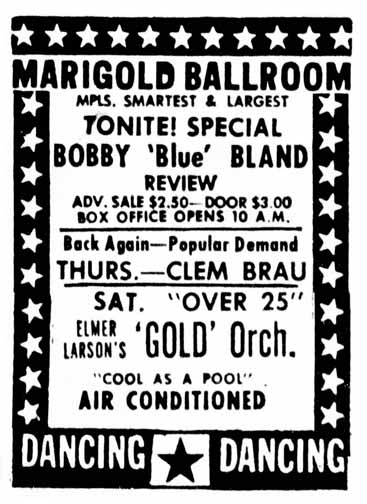
Minneapolis Star, July 22, 1964
Bo Diddley got the Marigold going on August 19, 1964. It was the same night Count Basie was at the Prom, and a conflict was feared, but Will Jones reported that Mr. Diddley drew 1,500 “sweating youngsters, ” and the Count drew 1,350 “oldsters.” (Minneapolis Tribune, August 21, 1964)
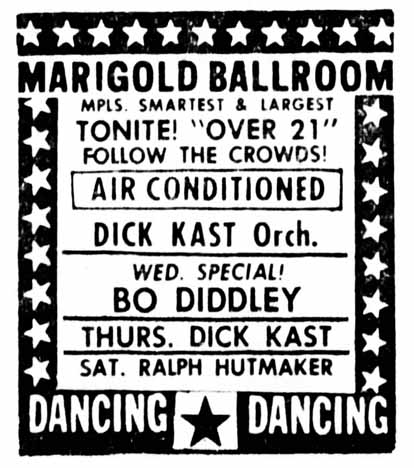
Minneapolis Star, Saturday, August 15, 1964
The Tams made an appearance on Sunday, August 23, 1964.
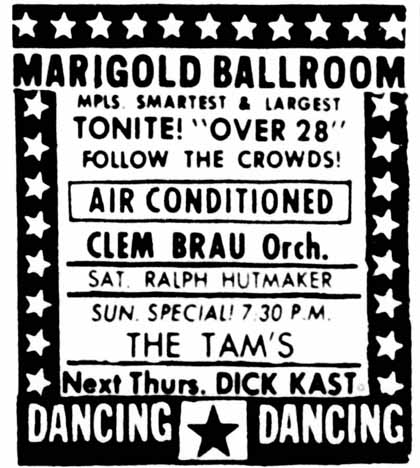
Minneapolis Star, Thursday, August 20, 1964
Bobby Freeman, who did “Let’s Do the Swim,” came to the Marigold on Sunday, September 27, 1964.

Minneapolis Star, Thursday, September 24, 1964
The epic blizzard of March 1965 prevented Bobby “Blue” Bland from making a KUXL-sponsored dance at the Marigold, but a local musician was found to substitute, admission price was lowered, and the event still drew 2,600 people.
The Impressions made an appearance at the Marigold on Sunday, April 11, 1965.
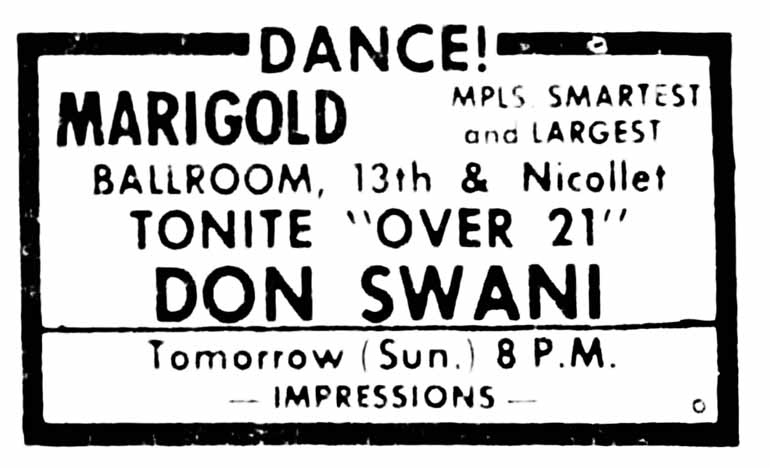
Minneapolis Star, Saturday, April 10, 1965
Solomon Burke performed on May 28, 1965. Two days before, Will Jones reported:
Solomon Burke, who has taken to wearing kingly robes and calling himself King Solomon, is booked for a Friday night bash at the Pick-Nicollet Hotel, promoted by a young married folks’ group called The Weekenders. Burke will proclaim KUXL’s Preacher Paul regional king of rhythm and blues at the event.
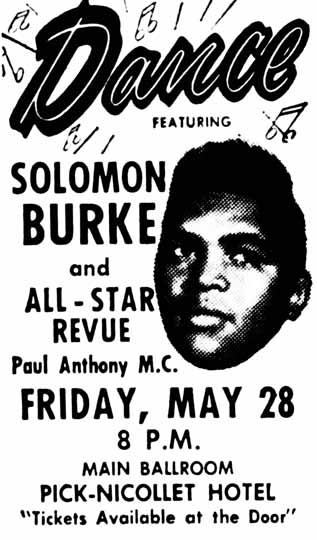
Minneapolis Star, May 1965
The Temptations were scheduled to perform at the St. Paul Auditorium on July 12, 1965, sponsored by Preacher Paul and KUXL. Will Jones reported that they would alternate with the local R&B group, the Amazers. I found no other advertising in the Minneapolis papers, but the St. Paul papers are not online.
Ike and Tina Turner appeared at the Minneapolis Auditorium under the auspices of Preacher Paul and KUXL on August 1, 1965. The show was not widely advertised. I love Will Jones, but this one is listed under “Weekend girlwatching tip.” MCP. July 30, 1965:
Talkative Tina Turner, who interrupts her love songs to give long, impassioned discourses on life and love in the middle of rhythm-and-blues records played mostly on KUXL, will be at Minneapolis Auditorium Sunday night. It’s billed as the Ike and Tina Turner Revue, complete with nine-piece band, singers Bobby John and Jimmy Thomas and a girl trio called the Ikettes. But it’s also a dance session. KUXL and Preacher Paul Anthony are the sponsors.
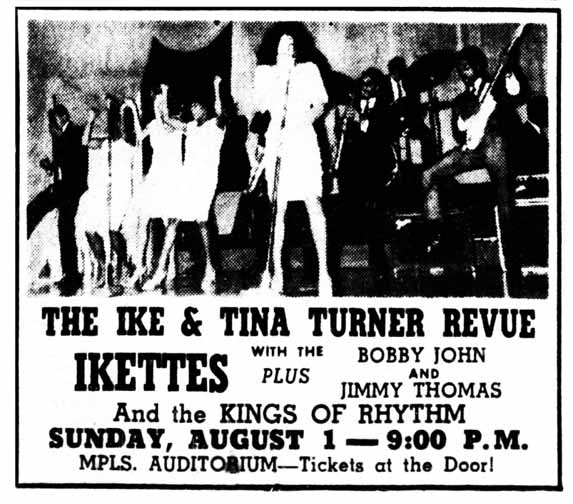
Minneapolis Star, July 1965
Preacher Paul reported that the show drew an audience of 5,000 people!
FOUR TOPS FRACAS?
Okay, here’s a puzzle. In the September 1965 issue of Twin City a-Go Go magazine, Preacher Paul had a column called “Here’s Hip Happenings.” At the end he talked about the concerts, and said that as he was writing the article, the most recent one was the Ike and Tina Turner concert on August 1. He also said that the Four Tops were two days away with an expected crowd of 2,000 or more at the Marigold Ballroom. And then he said that B.B. King was also coming to the same ballroom on September 12. Now. Not knowing when he was writing the article, one would suppose that the Four Tops was between Ike and Tina and B.B. King, right? Well, I found no evidence whatsoever of the Four Tops show, but I did find this:
On August 23, 1965, a fracas broke out involving 400-500 young people throwing eggs and rocks at cars, about a block from the Marigold Ballroom. Or so reported the Minneapolis Star the next day. Except that police reported that the incident only involved “several” youths. (And where would they get eggs?) One 20-year-old was arrested. Half an hour later, police were called to break up the crowd of 200 who had gathered outside the Ballroom when an “unidentified youth discharged a fountain pen tear gas gun. Police said they did not use tear gas to break up the crowd.” Or so reported the Minneapolis Tribune, the day after that. Efforts to find out who was playing that night were fruitless.
BB King performed at the Marigold on September 12, 1965.
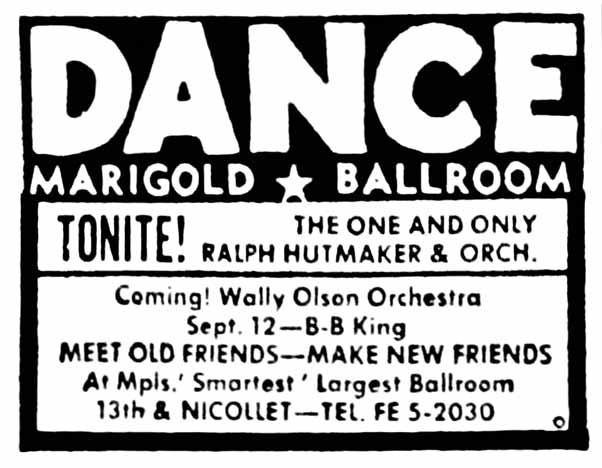
Minneapolis Star, September 1965
Jackie Wilson was scheduled to perform at the Marigold on January 14, 1966, but didn’t arrive until midnight, causing a “near-riot” at the ballroom when the 1,600 people in the audience “became annoyed.” Police were called and the City Council discussed the matter. (Minneapolis Tribune, January 27, 1966)
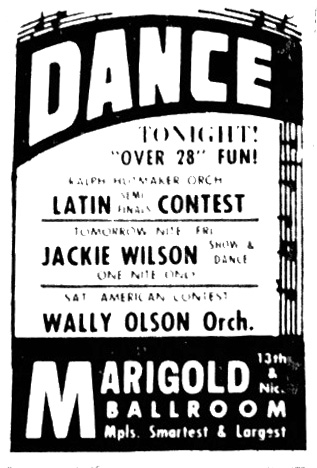
Minneapolis Star, January 1966
Rufus Thomas appeared with local group the Amazers on June 24, 1966.
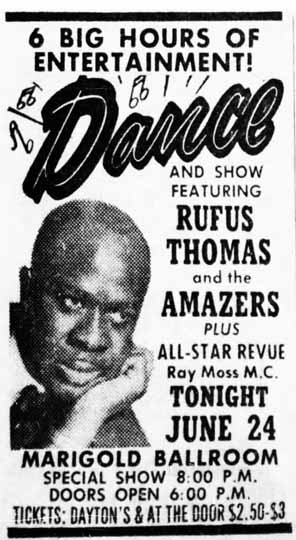
Minneapolis Star, June 24, 1966
The Temptations came to the Marigold on October 16, 1966, and police had to be called when 800 to 1,000 people on the sidewalk got impatient waiting to buy tickets at the one ticket booth. Police shut down Nicollet Ave. and were heckled by the crowd. The glass in the ticket booth was broken in two places, but Ballroom manager Elmer Larson insisted that there was no danger of the crowd getting out of hand and that the booth broke because it was “poorly constructed.” One person was sought for breach of the peace. (Minneapolis Star, October 18, 1966) Interestingly, the name of the act was never mentioned in the news reports.
KUXL hosted the Impressions at the Marigold Ballroom on January 22, 1967. Also appearing were the Amazers.
James Brown and His Revue appeared at the Minneapolis Auditorium on April 25, 1967. It was emceed by Jack with KUXL, and is believed to be the first appearance of Brown in the Twin Cities.
Checker recording star Little Milton, with local band Maurice McKinnis and His Fabulous Blazers, appeared at a dance at the Minneapolis Armory on Friday, April 12, 1968. The show was emceed by KUXL’s Jack Harris and Billy G. Little Milton’s hits were listed in an ad in the Insider as “We’re Going to Make It,” “Blind Man,” and “More and More.”
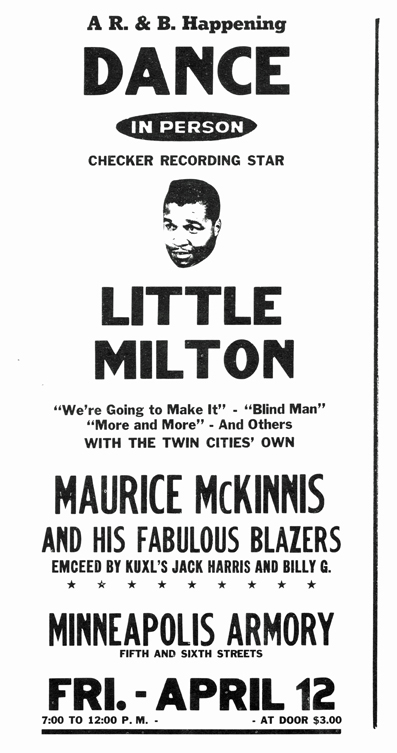
Ad from the Insider, April 1968
TRAGEDY AT STEM HALL
On August 30, 1968, a concert and dance was held at Stem Hall at the St. Paul Auditorium, emceed by Jack Harris, a/k/a KUXL disc jockey Daddy Soul. Performers included:
- Syl Johnson
- Maurice & Mac
- Willie Walker and the Exciters
- Maurice McKinnis and the Blazers
These groups were well known in clubs like King Solomon’s Mines where Soul music was a staple.
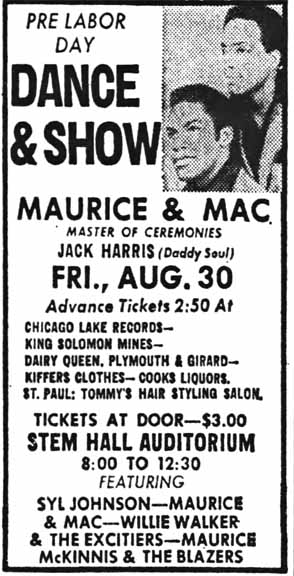
1968
What should have been a fun night turned into two nights of fear, anger, and violence – not only because of a situation handled poorly but because of underlying conditions that faced black communities all across the country.
The facts, as reported in the newspapers and in investigative reports approximate these. About 350 young people, mostly black (I’ll use that word instead of the word Negro used at that time) were in attendance. One young man was in a rest room with some others who were drinking, and he flashed a gun. It was never clear whether he used it or even who he was. Two off-duty policemen who were hired for the event came on the scene and took the gun away from him and tried to arrest him. They were attacked by about 20 men who tried to retrieve the gun. The policemen called for backup and the melee started. A gunshot was heard and a policeman was hit in the arm or hand. The shooter was never identified.
At that point, having lost the opportunity to peacefully arrest the young man, the police decided to use nightsticks to bar the door to the hall, keeping the people in. They broke through one of the doors, and then the police decided to keep them back by lobbing teargas into the crowd. Thus incited, the crowd began yelling invectives at the police and throwing furniture at them. Once outside the missiles became rocks. Mob violence ensued and the car of KSTP-TV newsman Dave Margeson was smashed by rocks and a piece of wood; he was treated and released from the hospital. The crowd moved west down 4th Street, smashing store windows, until they got to the Selby-Dale neighborhood, where many of the City’s 10,000 black people lived in what could only be described as a ghetto. The disturbance was considered contained by 2:30 am.
Seven people were arrested the first night. Two of them, a married couple, were from Minneapolis, and they had a loaded submachine gun in the trunk of their car and a .45 pistol under the seat. Whether this was related to the disturbance was not quite clear.
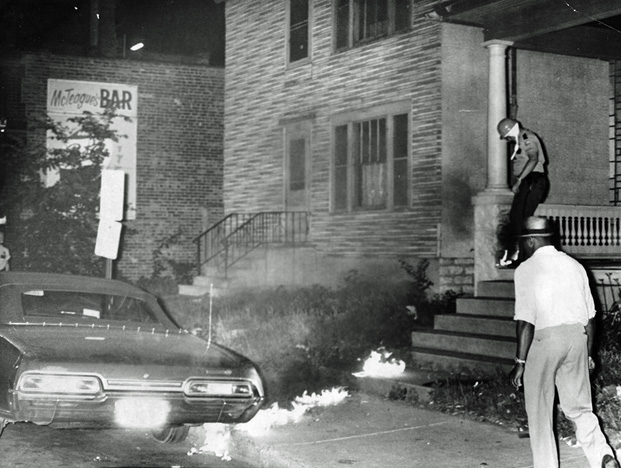
636 Selby Ave. Photo courtesy Jeff Neuberger
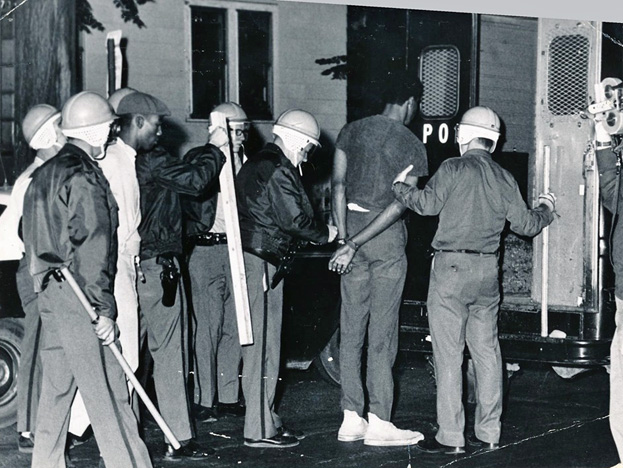
Selby and Avon Streets. Photo courtesy Jeff Neuberger.
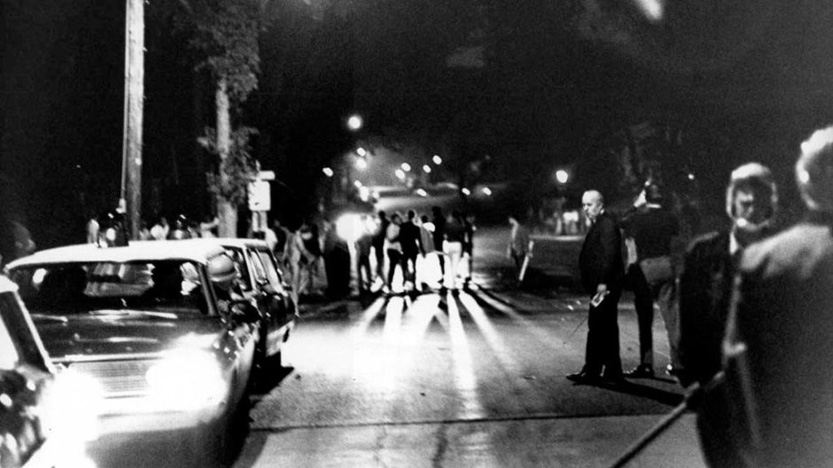
Photo courtesy St. Paul Police Historical Society
The next night, violence continued on its own momentum. At about 9:30 pm, someone with a shotgun wounded three police officers who, with about 20 others, were trying to break up a crowd of about 200 who had gathered at the site of a firebombing. A police command post was set up at the St. Paul Cathedral, and two-man tear gas units were sent around, with police at every intersection. Cars were prevented from coming into the area from Interstate 94 at the Dale Street exit. Four businesses were fire-bombed and fire trucks were met with sniper fire but no one was injured. Ten people were arrested, most for carrying firearms. Two white youths from upstate Minnesota were arrested in a house when spotted brandishing a shotgun on a balcony.
In the wake of the incidents, a committee was formed by the St. Paul Urban Coalition to investigate them. Sixteen pastors gathered to support this action and expressed their concern that the investigation be impartial and representative. The St. Paul Urban League and the St. Paul Human Rights Department also launched their own investigations. Meanwhile, the Mayor and others defended the actions of the police and laid the blame squarely on the “mob.”
The report by the St. Paul Human Rights Department, released in February 1969, placed the blame for the disturbances mainly on how the police handled it. While their job was to arrest one man with a gun, they instead barricaded the door of the hall with their night sticks and used tear gas to subdue the crowd. An underlying cause was said to be the overall condition of the Selby-Dale area.
The report of the St. Paul Urban Coalition, headed by Arthur S. Fleming, President of Macalester College, was released in March 1969 and echoed the first but was much more detailed and damning. The decision of the police to bar the door and throw teargas into the hall was roundly criticized. A policeman knocked down pregnant woman, pulled her hair, and threw her into a wall. A 15-year-old polio victim was smashed, face-first, into the pavement and sent home bleeding. The biggest troublemakers appeared to be a group of about 30 from Minneapolis, dressed in boots, Levi jackets, blue jeans, and cowboy or Australian “digger” hats.
And although much of the 96-page report centered on the disturbances themselves, the committee had plenty to say about “discrimination patterns in housing, education, recreation, employment, welfare, and police-community relations, and includes recommendations for improvement in those areas.”
Sources:
- Minneapolis Tribune, August 31 to September 2, 1968
- Minneapolis Star, August 31, 1968
- Minneapolis Tribune, February 2, 1969
- Minneapolis Star, February 6, 1969
- Minneapolis Tribune, February 9, 1969
- Minneapolis Tribune, February 12, 1969
- Minneapolis Tribune, March 19, 1969
- Minneapolis Star, May 7, 1969
I’m going to jump back a little into the chronology of events at the station after listing all of the concerts I could find. We were kind of in the middle of 1965. Remember that this website only goes up to 1974, and I did do a thorough search on Newspapers.com for KUXL and other offshoots.
1965
DIAL AWAY YOUR WORRIES
Will Jones dedicated most of his April 22, 1965, column to the station, saying, “Life is simpler on KUXL.” He declared that hip teenagers were abandoning the standard rock ‘n’ roll stations late in the afternoon to tune in to Preacher Paul Anthony.
Preacher Paul is no preacher. (KUXL is loaded with preachers earlier in the day, but most of them are called Brother or Doctor.) Preacher Paul is a disc jockey. He plays what the station management calls race music, and what is perpetrators call soul music.
One of the big sponsors was the Celebrity Lounge, where you could hang out with the owners, Minnesota Twin Earl Battey and former Gopher quarterback Sandy Stephens. “And when you’re there, you’re a celebrity.” The Twins management “got riled at the implications that its star catcher and other players were hanging around a saloon, and protested,” so the Preacher toned it down.
REMOTES
Billy G, the Prime Minister, started doing daily remotes from the Cassius Bar and Cafe on May 4, 1965, from 6 to 7 pm. The show was called Rhythm ‘n’ Blues Time. On May 27, 1965, Will Jones noted that with Daylight Savings Time and sundown getting later Billy G would be able to “wail with the records” from Cassius’ Bar until 9 pm.
On June 6, 1965, Jones dedicated a long, three-column article to the concept of “Soul Food,” saying that while Billy G made it sound good, it was hard to come by. The problem was that by the time he got to a place that had soul food, it was all gone. They made a big pot of it at noon, and when it was gone, it was gone, seldom lasting past 5pm. He finally had some blackeyed peas on New Year’s Eve, and other successes after that.
Meanwhile, Preacher Paul was bugged at being in a hot studio from 2 to 6, so starting in mid-June he was going out in a mobile trailer to broadcast from various outdoor locations around the Twin Cities.
The mother of all remotes was when several people from the station took over the Ebony Lounge, which was located in St. Paul over Roadbuddy’s Barbeque. Preacher Paul was there three nights a week as a host, and on Saturday afternoons he broadcast from the place. Both Will Jones (Tribune, November 2, 1965) and Preacher Paul (Twin City a Go Go, Holiday 1965) wrote about the place, and how they installed 14 of the finest foxes you’d ever want to see, a sound system that’ll knock the buckle right off your belt, some of those sweet, gone, pine-toppin’ KUXL sounds, and crowds of out-a-sight swingers. (Guess who said that?) Five or six foxes shake and gyrate on the stage each night to KUXL records, and Jones assures us they are the liveliest of them all.
CHANGES
Schedules and staff were changing that winter of 1965, with Preacher Paul slipping into semi-retirement, working only Saturdays from 1 to 5:30, remotely from the Ebony Lounge. He said Ronn the Rajah would broadcast from 1 to 2pm Monday through Friday, and then Ronn and Billy G the Prime Minister would alternate every half hour. I wonder how long this crazy schedule lasted! My DJ page tells me that Ronn the Rajah of Rhythm & Blues’s real name was Ron Samuels – the one who married Wonder Woman? On November 16, 1965, the 2:00 listing in the newspaper for KUXL simply read “R&B Express.”
Apparently the scene with the Fourteen Foxes didn’t last too long. A note in the Minneapolis Tribune dated December 10, 1965, said that “The discotheque scene at St. Paul’s Ebony Lounge which disappeared a couple of weeks ago, is back in action, with much the same cast, at Big Al’s in Minneapolis. KUXL’s Preacher Paul is promoting it once more.”
1966
POLICE END SWING THING
Oh Oh. Dateline Minneapolis, March 13, 1966. Labor Temple, third floor. “Charlie Smith and Preacher Paul Sunday swing thing. Take the elevator,” said the sign. So two cops from the morals squad took the elevator and found 150 men and women, a four-piece band, 36 tables and a 15-foot liquor bar with 54 quarts of liquor, 21 bottles of beer. They also reported that people were buying tickets for 50 cents entitling them to buy drinks. Oh so many levels. The cops busted four men and three women for selling liquor without a license (and on a Sunday!). Those seven people included Mr. and Mrs. Preacher Paul. Interestingly, he was listed as age 29, she 24. In fact, all were in their 20s. And, those cops took $350 in cash. (Minneapolis Star, March 14, 1966)
STATS FROM BILLBOARD
Here in my file is a page out of the July 9, 1966, issue of Billboard magazine, where the information about KUXL lives. Let’s do bullets:
Music Format:
- Rhythm & Blues: 60 percent
- Jazz: 25 percent
- German, Polish, Country, Old-Time: 15 percent
Special Programming:
- R&B Dedication Line
- B’nai Shalom Program
- German Hour
- Polish Hour
- Comedy LPs on Art-Art’s Dedication Line
- Maury Bernstein and Folk Music
Douglas Rice, Director of 3-man news department
General Manager: Robert W. Smith (Wolfman Jack)
Program Director: Arthur A Hoehn
MORE CHANGES
In July 1966 (Smith sold out to Kosofsky?) and went back to Mexico, this time to XERB, a 50,000 watt station in Tijuana. Art Hoehn and Ralph Hull left with Wolfman, either to Mexico or Southern California. In 1974 the Wolfman was into many projects, including a weekly syndicated show that was broadcast here on KDWB. The Wolfman died on July 1, 1995.
November 1966’s In-Beat magazine included an interview with the station’s new DJ and Program Manager, Ray Moss. He came with no radio training at all – in fact, he was a bartender – but the station executives were impressed with his verbal fluency and vast knowledge of music. He was hired to do the jazz show, but moved to take over the R&B show when that opened up. He did his own programming, and said he loved his job. “After all, it’s a thing to be able to sit down and listen to sides all day.”
There was also a Richard Nelson, who Connie Hechter at the Insider called Dick, but he actually was known as “Admiral Richard E,” and was on the air from 1966 to 1968, according to Curt Lundgren (who says he would cringe at the name “Dick.”)
Lord Jeffrey, (Jeff Diamond) came to work at KUXL in 1967, when he was about 15 years old. Dan Pothier (pronounced Poh-SHAY) worked at the station around this time as well.
1967
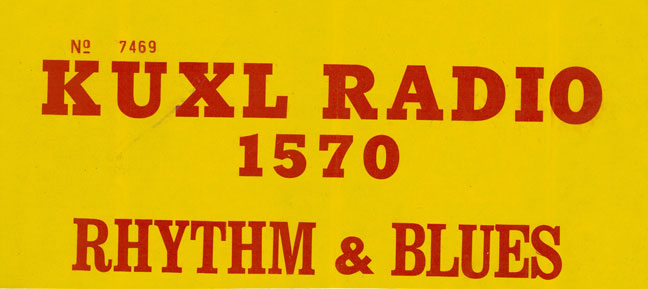
1967 bumper sticker courtesy Curt Lundgren
On June 12, 1967, the station’s application to change its studio location to 5728 Wayzata Blvd. in Golden Valley was approved. Curt Lundgren, who would go on the air as Evan Curfew, tells us that the studio was in the basement of the South Side Lumberyard Building, right behind McCarthy’s Restaurant on what is now 394. In the photo below, the KUXL trailer is in the parking area behind the building. “Luxurious digs, no?” says Curt.
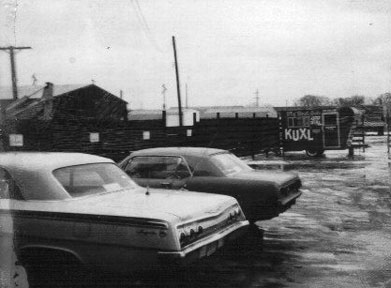
Photo courtesy Curt Lundgren a/k/a Evan Curfew
From the Insider, September 30, 1967:
Good New Show on KUXL: Saturday at 5:00 pm is the time to listen to all the old hits on “Bill Blast Hits of the Past.” The show, hosted by Al Collins of Music City, downtown Minneapolis, received good response from listeners. Al, by the way, happens to be a very knowledgeable fella, record wise. He truly loves the business.
1968
The Insider reported that Evan Curfew was playing a Solid Gold Oldies All Request show on Saturdays from 1 – 5 (am or pm?) in February 1968.
On April 13, 1968, Billboard reported that Ray Moss had gone to California for a job with XERB, but returned quickly and with a new name: “Daddy Soul.” The Insider reported that Moss became the new music director in April 1968, and was on-air from 3 to 7, Monday through Friday.
According to the April 13, 1968, issue of Billboard, “Chess Records artist Jack Harris is now doing a show on the R&B station…” Jack Harris, the proprietor of Black & Proud records, became “Daddy Soul.” The Insider said that he was on-air just an hour a day during the week and from 1 to 3:30 on Saturdays. He was program director from 1968-1971. See more about Harris under his listing on the Disc Jockey page.
1969
On January 15, 1969, Minnesota Human Rights Commissioner Frank C. Kent announced that Ray Moss, who had charged KUXL with discriminatory practice in employment when it discharged him, had been been restored to his position. (Minneapolis Tribune, January 16, 1969)
The station’s request to change the location of the studio to 5730 Duluth Street in Golden Valley was approved on October 14, 1969.
1971
In the September 1971 Insider, reviewer Will Shapira profiled W. Amos Johnson, who did a two-hour jazz show on KUXL each Sunday. Shapira wrote about how difficult it was to sustain a jazz show in Minneapolis, and how Johnson, first hired early in 1971 to do the news, wanted to give it a try. Johnson mostly played what was termed easy-listening jazz: Isaac Hayes, Shirley Bassey, George Benson, Herbie Mann, Herbie Hancock, etc. He didn’t want to scare people away, and he wanted to lure sponsors to the program. As it stood, it was then peppered with public service announcements rather than the preferred commercials.
The schedule on December 30, 1971, shows Rhythm & Blues programming from 1pm until dark and 6 am until 6:45 am.
1972
A Super Soul Thirty countdown dated July 1, 1972, pictures DJ Thomas Love and Music Director Jimmy Smith (
A newspaper schedule dated December 19, 1972, shows the same “preacher tapes,” as Ray Moss called them, from 6 am to 1 pm. Then there was alternating R&B and Rap at various intervals.
On December 29, 1972, KUXL announced that it was abandoning rhythm & blues in favor of a telephone talk show. Station manager Jim Peterson said the change, effective January 1, 1973, will involve afternoon programming only, with religious programs to stay on the station’s schedule until 1 pm daily. The station’s R&B programming had averaged about two hours daily during recent months when the station’s sign-off time – local sunset – had been late afternoon. Peterson cited economic factors as the reason for this change.
1973
In January 1973, KUXL officially went out of the R&B business – at least for a while – and began a talk show format. Jim Peterson, station manager for the last year, said no matter how much sense it made, nobody would buy commercials for a little 1,000 watt, AM daytimer station. Peterson gave the example of Hamm’s and Grain Belt beer – highly patronized by the black community, but refused to buy time on the station.
Yusef Mgeni, a radio-television program supervisor for U of M station KUOM and member of the Malcom X Pan Afrikan Institute, found the argument lacking, going so far as to accuse program director Mike Cunningham of having “racist and oppressive views.”
Disc Jockey Fat Daddy (a/k/a Jimmy Smith) cited statistics that out of 32,000 blacks in the potential audience, between 10,000 and 15,000 listened to the station. Unfortunately, the American Research Bureau came in at fewer than 1,000 listeners at 3 pm on a week day.
The new schedule kept the morning religious shows, which did have sponsors and paid the bills. Peterson said R&B “never even paid salaries.” From 1 to 3, Mike Cunningham would be on the air, and then from 3 to 5, Paul Helm, the man people loved to hate. It was Helm that people petitioned to have on the station more than anything, after trying him out on a trial basis starting in the middle of 1972. (Minneapolis Tribune, January 2, 1973)
1975
For the first time since 1973, black music was again on the radio, with a new disc jockey named Pharoah Black (nee Thornton Jones). The show, “Pharoah Black’s Soul ‘Til Sundown,” began on May 1, 1975, and ran from 7 pm until sundown. It provided music and information “for and about black people in this city and around the world.” Black, age 28, was a graduate of Brown Institute, and had been working at WCCO. He actually bought the time from KUXL himself and sold commercials to pay for it. (Minneapolis Star, April 30, 1975)
During the show, black broadcast community news, and an educational series called “Red, White and Blue in Black.” The program also kept in touch with other black media programs like the black TV show, “Harambee.” He started the black show because whatever black programming there was was scattered – a half hour on one station and 15 minutes on another. “I thought if we could get somewhat organized on a daily continuous basis that it would be a step in the right direction. “I’m going to try Minnesota to the bust before I try and move on someplace, because I feel that black programming is needed here more than anyplace else.” (Minneapolis Star, August 3, 1976)
1976
The Centennial Rhythm & Blues Show was the brainchild of Lamar Adams, who shared his collection of more than 4,000 recordings starting in May 1976. It was started through his Minneapolis Brokers Association, which bought the two-hour Sunday time slot from KUXL after Adams and his associates sold enough advertising.
The music spanned the black musical spectrum, from bebop to pop, delta blues to Motown, Dixieland to the Philadelphia disco sound, said Adams. Staff included Gary (The Deacon) Johnson, a blind disc jockey. Despite the station’s weak signal, the show received over 1,500 letters in four months.
Unfortunately, by September 1976, the program’s two advertising contracts had expired, and Adams was unable to find new sponsors. Once again, the small black population in Minneapolis was cited as a reason not to sponsor the program, although white people were clearly listening as well. (Minneapolis Tribune, September 7, 1976)
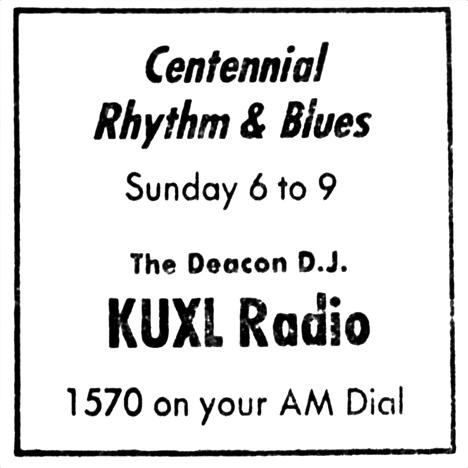
Minneapolis Tribune, June 19, 1976
Pharoah Black introduced Earth Wind and Fire, with the Emotions and Wild Cherry at their October 7, 1976, concert at the Met Center. At the time he was operating two mobile discos called “Soul on the Roll Disco Rendezvous.”
1977
Apparently all this time, the station was still owned by Universal Broadcasting, which, when it was purchased, was controlled by Marvin Kosofsky. On April 28, 1977, there was a voluntary relinquishment of positive control of Universal from Kosofsky to Miriam Warshaw, if I’m reading this right.
On December 20, 1977, a permit was approved to change the tower location to 5650 St. Croix Ave. in Golden Valley. The old tower was removed and a new tower erected.
1978
In 1978, promoter Tom Tipton noted that KUXL played only 11 hours of soul music per week. (Minneapolis Star, March 17, 1978)
On August 22, 1978, a construction permit was approved to increase the station’s power to 2.5 kw.
1988
The call letters of KUXL changed to KYCR on May 19, 1988.
KYCR changed to KDIZ on December 24, 2015.
KTCR signed on on April 5, 1962, as a Country station. The transmitter and three-tower antenna array are located in New Hope on Winnetka Avenue north of 36th Avenue. This has been the only transmitter location for the station since it signed on the air.
Al Tedesco purchased the station in 1968.
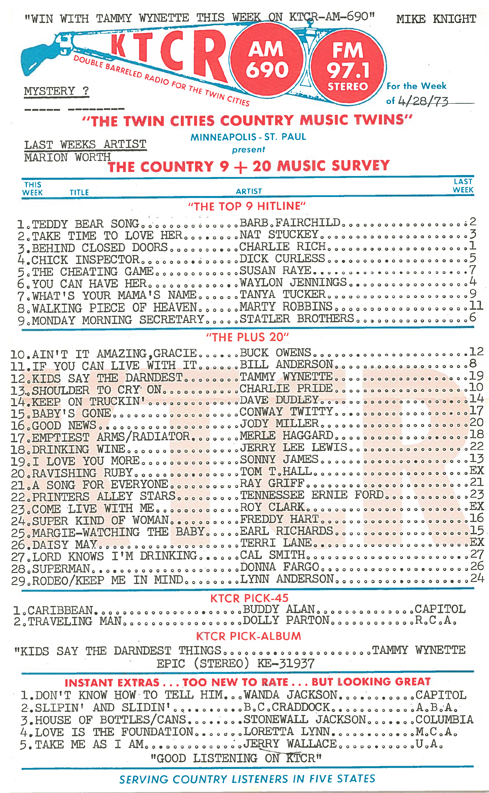
Courtesy RadioTapes.com
In 1983 the station was sold to John and Kathleen Parker.
For some country airchecks from 1963 and for two Music Surveys from 1974, see http://twincitiesradioairchecks.com/ktcrfmtapes.html
For several Music Surveys from the early 1970s, see http://www.radiotapes.com/surveys.html
KSTP- AM – 1500 kc
1953
It’s unclear when KSTP started playing rock ‘n’ roll. In late 1953 there were shows called “Saturday Date” and “Rhythm at Random,” but what they played is anyone’s guess.
1954
Shows in 1954 include:
- Saturday Juke Box
- Jack Horner’s Corner
- Record Rack
- Shows with Don Hawkins, Johnny Morris, and Jimmy Valentine
- Clubtime
1955
New shows in 1955 include:
- Young Ideas
- Melody Fair
- Radio Fan Club
- Shows with Henry J. Taylor, Bill Ingram, and Don Riley
The station was also still playing “Fibber McGee and Molly” and “The Lone Ranger.”
On October 3, 1955, an ad boasted that the station would play more music and had a new record library. The shows were identified by the name of the DJs, which included Morris, Rodger Kent, Riley, Valentine, and Ingram.
1956
In July 1956 the station stopped playing all night country & western, with Harry Zimmerman playing an hour of jazz, and hour of show tunes, and two hours of country.
1957
In January 1957 Will Jones of the Trib said that the station claimed that classical music has doubled its nighttime ratings in a matter of a few weeks. At that time the station was also playing show tunes, Lawrence Welk, and shows like “Dragnet,” Bob Hope, “The Great Gildersleeve,” and biographies. Harry Zimmerman was playing the “Sweetest Music in Town.”
Something happened on January 14, 1957, but the ads weren’t clear. “It’s a NEW concept in news coverage!” “Scientifically Designed Entertainment” “$100,000 worth of better listening” “Big Big Big 40,000!” “All on the Northwest’s QUALITY station”
In August 1957 the station claimed to be “first with Twin Cities Housewives” based on a telephone poll of 388 people.
In September/October 1957 it announced “new programming,” with “more music, more news, more often.” By October it was a big-time rock ‘n’ roll station, at least until that December, with DJs Rog Kent, Don Hawkins and Harry Zimmerman. The station’s music survey was Top 15 Teen Tunes, and included 5 Top “Comers” selected by a High School Panel of Experts. Those songs were not rock ‘n’ roll.
There was apparently a change of heart; ads from the mid ’50s asked:
-
“tired of one-note guitar players and hiccup singers?”
-
“like to crawl in a hole when you hear rock and roll?”
-
“you don’t have to listen to rock and roll! Just tune to 1500 on your dial!
Jeff Lonto says that they became a “middle-of-the-road” music station for years, also carrying NBC news and NBC’s “Monitor” on weekends.
1958
One highlight of the station’s programming from about 1958 to 1973 was Leigh Kamman, whose jazz programs emanated from Freddy’s night club in Minneapolis and featured performances by Count Basie, Ramsey Lewis, Errol Garner, and Ella Fitzgerald.
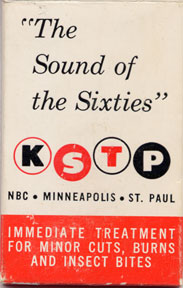
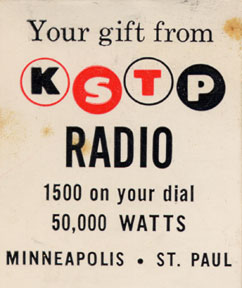
1970
In about 1970 there was a shake-up of personnel.
1973
In the summer of 1973 KSTP entered the top-40 competition “with rapid-fire disk jockeys playing records in uninterrupted clusters. The jocks shouted, snarled and chanted the KSTP slogan that was spilling from billboards and buses all over town,” according to a 1977 Strib article.
Jack Nugent said they went from 13th in the market to 2nd in 105 days. The competition clobbered WDGY, which succumbed in 1977. In 1973-75 Chuck Knapp and Charlie Bush in the morning, Machine Gun Kelly and others livened things up. The slogan was “15 KSTP–THE MUSIC STATION.”
The Insider made note of the change to a rock format, “playing a mix of current and older top 40. Their playlist is appealing, though their disk jockeys are somewhat obnoxious.”
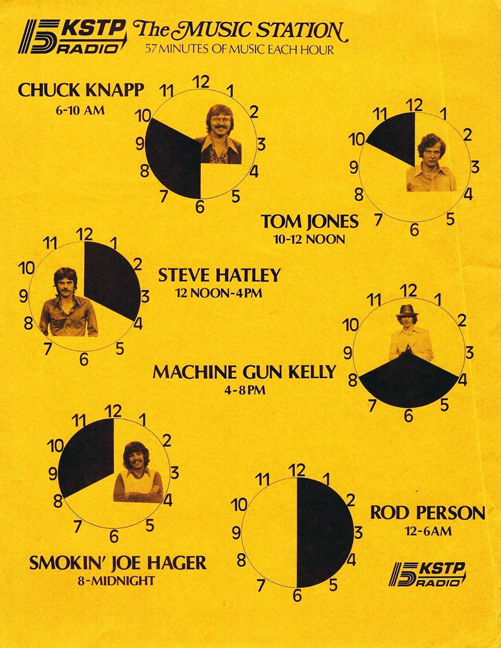
Spring 1973 ad courtesy Jeff Lonto
1975
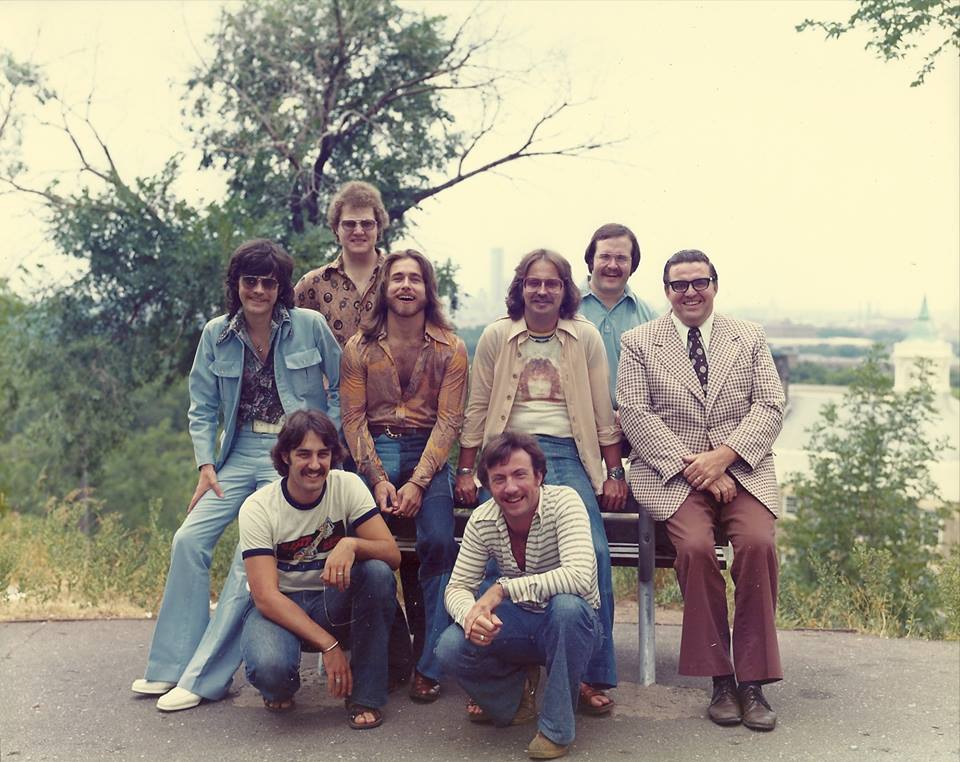
Chuck Knapp: “Fun times is rock & roll with the very talented 15/KSTP The Music Station staff in 1975. Standing from left to right: Steve Shannon and Ed O’Brien. Ed replaced Machine Gun Kelly when he split for KHJ. Middle row: Steve Hatley, Cosmic Cowboy a/k/a Terry Roberts, Chuck Knapp & Charlie Bush. Front row John Hines and Larry Carolla. ‘Hubbard’s Hundred Days’ was the headline in late 1973.”
John Hines replaced Knapp in about 1975, and Rob Sherwood arrived in 1976, after U100 was sold. He stayed until February 1978.
1977
In November 1977 the Insider reported that the station was “working around to the album rock format from Top 40.”
1979
Around the fall of 1979 it went to “adult contemporary, and they also picked up Bob Allard’s and Larry King’s talk shows in the late evening. Soon they added Monday Night Sports Talk with Reusse and Soucheray.
1981
The station continued to play music until news and talk completely took over in August 1981. The switch to talk was gradual over two years.
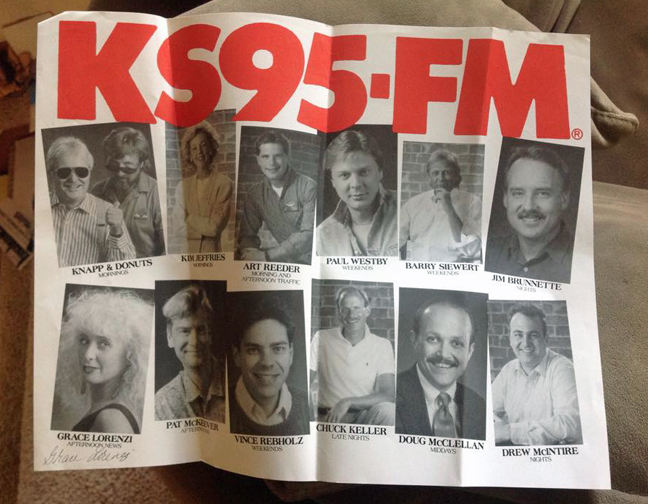
For great airchecks and pictures, see:
http://radiotapes.com/KSTP.html and
http://twincitiesradioairchecks.com/kstpam70s.html
Return to Twin Cities Radio
Save
KRSI – 950 kc
For airchecks and photos, a great site is:
http://twincitiesradioairchecks.com/krsiandkfmx.html
KRSI Radio was located at 4500 Excelsior Blvd. in St. Louis Park from May 16, 1958 (at 7am) to October 1972. The station was five years in construction, delayed when its two towers in Eden Prairie fell.
From the start the station played “Memory Music” – “the kind of music everyone likes to hear,” according to an article in the St. Louis Park High Echo from June 5, 1958: “No long commercials, soap operas, kiddie shows, rock ‘n’ roll, ‘top 40,’ or ‘over-enthusiastic’ disk jockeys… This is the radio station that puts the ‘mellow’ back into music.” The owner and president was William E. Schons, and the program director was Marvin Schulz. They conducted a “Music Poll” via a coupon in the papers where people could indicate their music preferences and help the station select what it would play on the air. “Keep your spirits high with KRSI, 950 on your radio dial, finest in hi-fi.”
In May 1961 it was purchased by Red Owl Stores, Inc. which was seeking diversified subsidiaries. J. Warren Burke was brought in as general manager to revamp the station. The memory music format was enlarged, a jingle by Herb Pilhofer was created, and talk shows were produced.
On about September 1, 1962, the AM station expanded to 24 hours. At the same time, “the station will be entering the background music field, supplying a separate channel of music to supermarkets, offices, plants, and other installations,” reported the Minneapolis Daily Herald on August 8, 1962. Here’s the story from Jim Stokes:
KRSI originated Red Owl Stores “storecast” from their transmitter on what is called “subcarrier.” You can look it up. It’s complex. So they had to have an engineer on duty at the KRSI transmitter to change the store announcements that interrupted the music. The music ran a slow speed on gigantic tape reels. The music was my kind of music, actually—other than classical music. It was Percy Faith type music. So if you went into a Red Owl store to shop, there would be a voice saying something like, “Want to perk up family meals. Try some Red Owl green beans.” (blah blah)
Other new features in 1962 included:
- “Suburban Editorial,” with editors of 12 suburban newspapers editorializing on the air throughout the week
- “Suburban Bulletin Board”
- “Business Briefs”
- Sports features
- A two-hour show featuring audience calls discussing some controversial or current issue
- Play-by-play sportscasts
In January 1965 it was reported that staff had increased from 19 to 27 since Red Owl purchased the station in 1961.
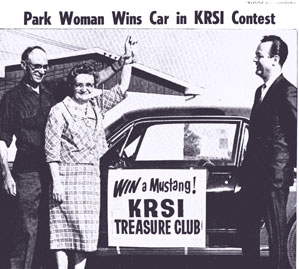
LOL wins Mustang, 1966
ALL REQUEST RADIO
In 1968 Red Owl changed the station policy from middle of the road to all request oldies to try for a high enough rating to at least make the property salable. It was sold to Park Broadcasting [Roy H. Park].
The request line was started in February 1968, with oldies – and not just the same old ones – being their mainstay. Every sixth song was current. This station was pretty freewheeling and one could hear Jimmy Dean in the same breath as the Supremes. In the first year they logged over a million calls to the Request Line: 920-9999. Most of them were from me.
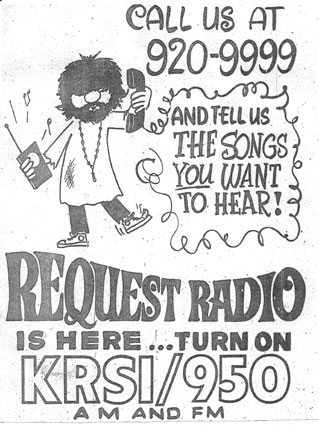
Ad from the Hopkins Sun, May 2, 1968, courtesy Jeff Lonto; also in Minnetonka Herald, February 22, 1968
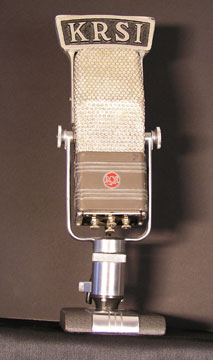
Image courtesy Pavek Museum of Broadcasting
In 1969 KRSI issued a two-record compilation of oldies called the “KRSI Request Album.” The photo below is from the album. (Thanks to David Hersk!)
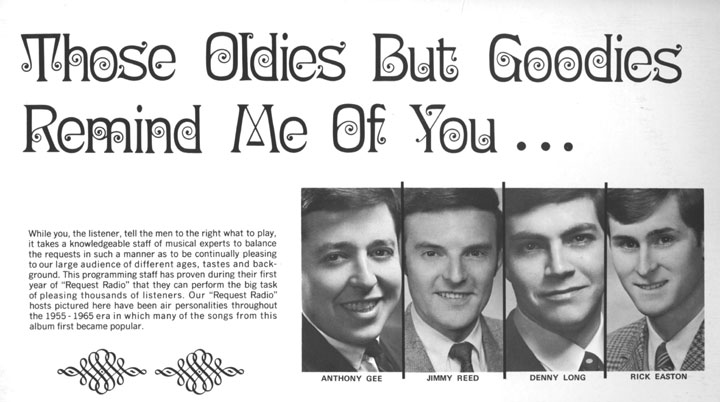
UNDERGROUND ROCK
In ad in the June 14, 1969, TV Digest pictures Tac Hammer, Rick Easton, Anthony Gee, Jim Reed, and Don Shore. They look really young. Hammer and Reed had come over from KDWB in 1968. In July 1969 the two were doing an “underground” show.
By 1972/1973, KRSI and KQRS had almost identical Progressive Rock shows. They would play pranks like play the identical songs for an hour and see if anyone noticed. John Fineberg was at both stations during those years and described a “KQRSI” (KQRS and KRSI) family. Below is a photo of at least part of the family and shows how close the staffs of the two competitors were.
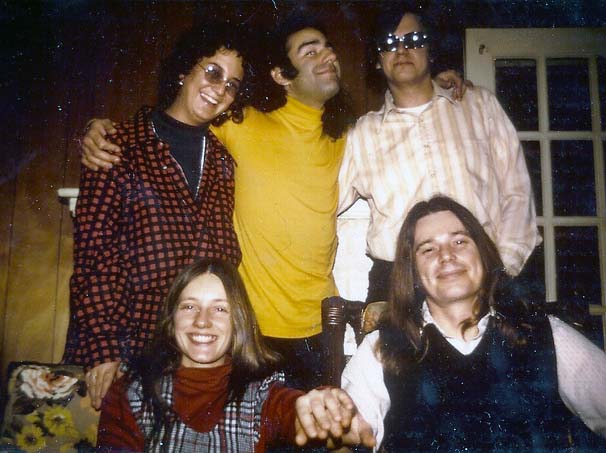
Photo courtesy John Fineberg
John Fineberg:
Front row: Susan Bradley and John Pete (KRSI). Back row: Randi Kirshbaum (KQ), John Fineberg and Richard E. Nelson (who was KQ’s production studio wizard). I really don’t remember which station I was on then.
We kept professional secrets from each other, but otherwise we were just one big, happy family. Well, at least with the “progressive” announcers on KRSI. (The “top 40” announcers were a different breed, and we had little to do with each other off-the-air.)
John Fine was also part of this tight social group. Though our names are nearly identical, we were two different people. Glad you got that right, as our listeners just couldn’t figure it out. John was a dear, dear friend who died way too young.
In January 1971 the station started to gradually move away from the oldies and gradually more toward album cuts.
In a 1972 article the Insider noted the leaky roof and yellowed wallpaper at the aging studio in St. Louis Park.
Ads to rent out the St. Louis Park studio appear in January 1973 and sometime between then and March 1973 the studio moved to Valley View Road in Eden Prairie.
AUTOMATED COUNTRY
An interesting headline in the March 11, 1973, Minneapolis Tribune was “Automated Radio: Nobody is there” by Irv Letofsky. In his usual wry style, Irv describes how KRSI’s General Manager, John Enoch, was testing Control Unit Model 901, which generated automated programming. KRSI’s owner, Park Broadcasting, which owned 18 radio and TV stations in 11 cities, asked Drake-Chenault Enterprises of Los Angeles to install one of its systems. The station was the first to put in the company’s prepackaged “Great American Country” service.
The station played four categories of Country:
- “The all-time, sock, dynamite hits,” on 15 reels of tape, 32 or 33 songs to a reel. “The reels are changed by an actual human person.”
- “Oldies, the all-timers but not whammo smashes, not instantly recognizable but they sold a lot.”
- Top country hits – new reels sent in weekly
- Older recurring hits
Drake-Chenault’s sales manager explained that if a station tried to duplicate the format live, “you’d have to get supertalented country jocks, a top-notch country producer and all the other things. Our service costs about the same if you brought in that supertalented program director.” Plus you eliminate “the stuck records, scratchy music, the jarring jock. They want smooth, slick, uncluttered radio.”
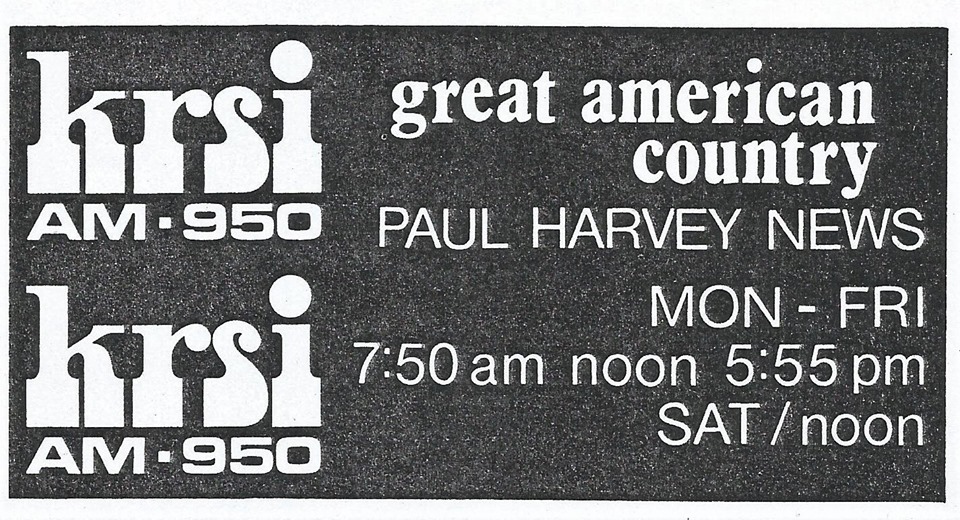
Ad from Minneapolis/St. Paul Magazine, August 1978, courtesy Jeff Lonto
I-95
In September 1979 the station became known as Musicradio I-95, playing Album Oriented Rock/New Wave.
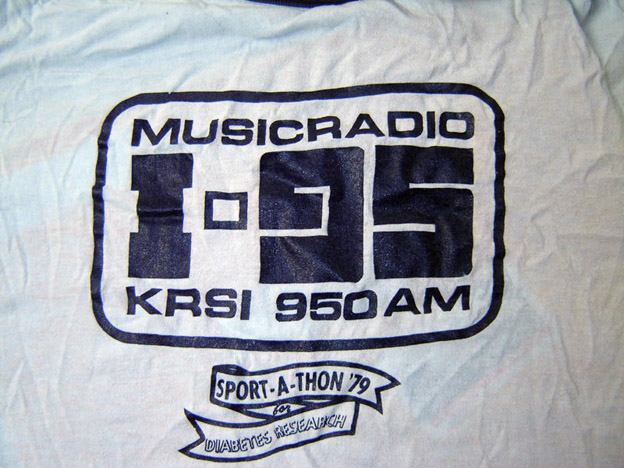
Jay Philpott’s I-95 T-Shirt
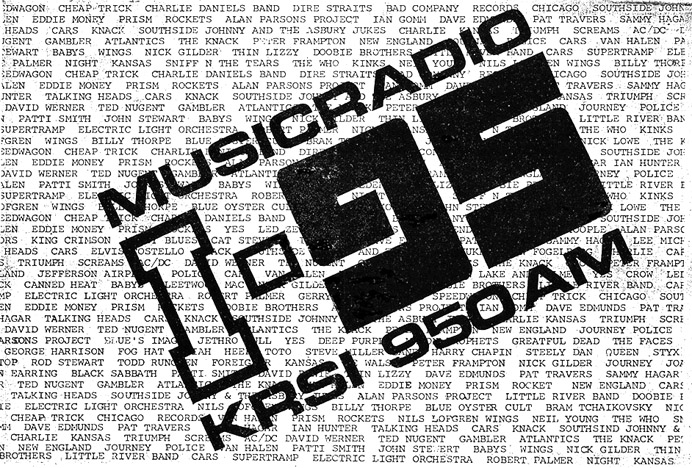
Sweet Potato, September 1979. Image courtesy Jeff Lonto
With the assistance of Wikipedia:
MUSIC OF YOUR LIFE
Adult Standards, February 1980 to 1982. Despite the high hopes for I-95, it only lasted until February 2, 1980. The station then bought the syndicated program “Music of Your Life” from Al Ham. Both KFMX 104.1 and KRSI 950 am flipped to Music of Your Life as KRSI AM-FM that day, with Don Shore as the Program Director and morning host. Jay Philpott was the only holdover from the old format – “they had me doing 7 to Midnight until I left for WLOL in July 1980.”
Country music (SMN “County Coast To Coast”) (1982-1984)
Contemporary Hit Radio – (SMN “Rock America”) “Hot Rock 950 KRSI” (1984-1985)
Request Radio, 1985 to January 1986.
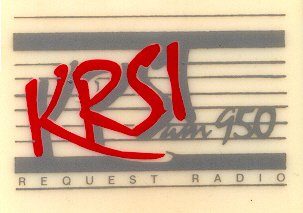
The last KRSI logo, 1985, courtesy Jeff Lonto
Simulcast with KRSI-FM as KJJO (1986-1988). Jeff Lonto: “The ratings started to go up and so ownership and management had the bright idea of pulling the plug on the whole thing, changing the calls to KJJO-AM, and simulcasting FM sister station KJJO-FM (104.1). KRSI personalities in this second Request Radio stint included Don Thompson, Jerry Anderson, Mike Records Ryan, Ray Walby and Bill Hutchinson.”
Urban Adult Contemporary (SMN “Heart and Soul”) 1988
Hard Rock (Satellite Music Network’s “Z-Rock) as KZOW (1988-1990)
Business Radio Network (as KJJO), 1990-1992
Simulcast with FM (KJJO/KMJZ), 1992-1995
R&B Oldies as KSGS (“ABC Solid Gold Soul”) with local AM Drive) (“9-5-0 Solid Gold Soul”), 1995-1999
Urban Adult Contemporary (ABC “The Touch”) with local AM Drive), 1999-2001
Business Radio as KDOW, then KCCO (“Business 9-5-0”), 2001-2004
Talk, as KSNB, 2004
KRSI-FM (104.1) went on the air for the first time on about September 1, 1962. It was to be “a program format, readily identifiable concentrating on jazz, according to Burke. The programming would be “segmentized,” appealing to the “sophisticated audiophile with no verbal interpretation heard during the program “We will be one of the few FM stations in the country doing all music programming in stereophonic sound.” The FM station would also offer comedy albums, folk music, and spoken word segments. (Minneapolis Daily Herald, August 8, 1962)
Jeff Lonto offers this information:
FM station (104.1) was KRSI-FM until 1974.
It was KFMX from 1974 to 1979. During the KFMX days, one of the frequent sponsors was the Leaning Post.
KRSI-FM again from 1980-1981
KJJO-FM from January 1981 until May 1995
“After that they’ve changed calls as often as formats and that’s pretty frequent.”
The rest is exhausting – please see Wikipedia for further/better history!
Save
Save
KQRS
KQRS 92.5 FM started out as KEVE-AM on September 1, 1963. For awhile they called the AM station KEVE and the FM station KADM – “Adam and Eve in the Valley.” The two stations were simulcasting classical music when they both went to KQRS.
On December 1, 1964, KEVE was changed to KQRS “Quality Radio Station,” still playing classical music.
Within a couple of years, KQRS-AM switched to a mix of jazz, Broadway tunes, public affairs, and talk shows, including one by the controversial host Joe Pine. Pine was known for making people mad, and Dick Driscoll tells of coming on the air after Pine and having people call to yell at him for things Pine said.
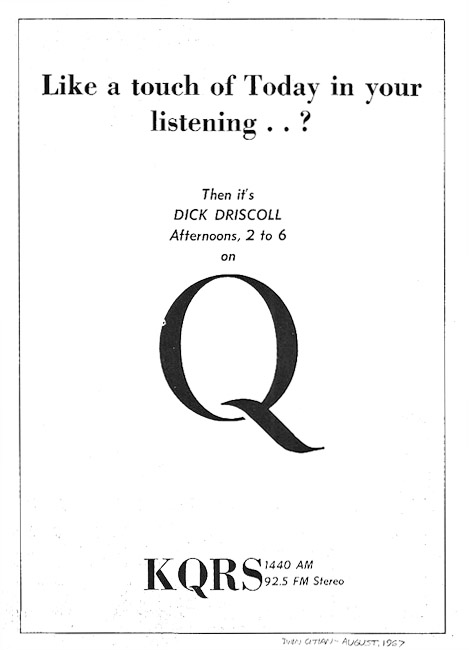
Image courtesy Jeff Lonto
PROGRESSIVE ROCK
In 1967 KQ-FM made its first foray into album rock with its “Night Watch” program, broadcasting from midnight to 5 am. George Donaldson Fisher describes the transformation:
I began the Progressive (I referred to it as “Underground”) rock on KQRS in early 1967. The station had signed off the air at 11 p.m. when I did evenings until I was offered the overnight slot with Musicland as a sponsor. Then I was given stacks of albums of rock, bands from primarily the West Coast, to audition and play once my show began that Spring. I developed a “format” of album rock, blues, soul, some jazz, a bit of folk, classical, spoken word and anything I could find that interested listeners. The reaction to the music I played overnights was very favorable and the “format” expanded to evening hours and then into days and [by 1968] KQ became full time rock.
For more on Progressive/Underground Rock, see KRSI.
A 1973 ad featured a hippie smoking a pipe on a bed of nails reading a book called Happiness Through Yogurt. The ad pointed out that the station’s news came not only from AP and UPI but also from Zodiac and Earth News, and provided exclusive perspectives on ecology, abortion, drug use, and consumer protection. It also provided local-oriented public service information on groups like Y.E.S., Pharm House, Red Door, Women’s Counseling Service, and more.
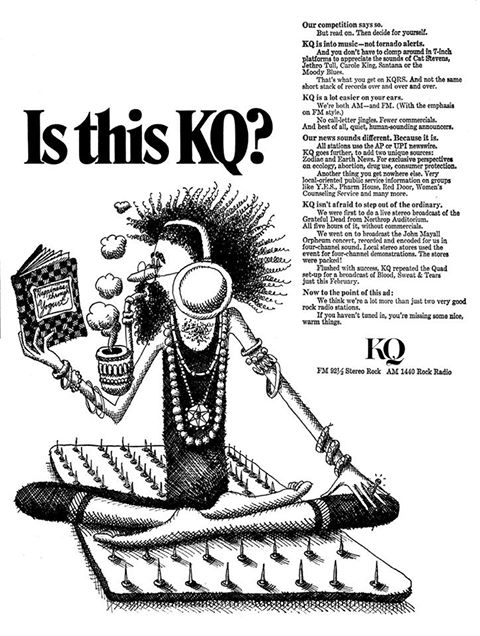
April 17, 1973, ad image courtesy Mark Luebker
On November 18, 1973, KQ AM and FM began airing “The National Lampoon Comedy Hour,” a comedy show created specifically for radio by Michael O’Donoghue, editor of The National Lampoon magazine. An article in the Star said the show included “skits, blackouts, parodies on talk and telephone shows, and interviews.” Although the show was an hour long, KQ began by airing a half-hour version at 10 pm on Sundays. Listeners remember taping the show and playing it the next day for friends.
An ad from October 1976 describes the playlist as “Folk, Jazz, Blues, Totally Album-Oriented – The Fine Rock Station.” DJs could play anything they liked and anything that pleased the station’s audience.
On July 1, 1977, the station went from “free-form” to “album rock.” In an article in the Star dated August 3, 1977, Jon Bream called the new format “commercial, superstar rock.” DJs were restricted to playing a list of songs chosen by a consulting firm in Atlanta. Bream’s article explained:
KQRS made the format change, explains Dick Poe, station vice-president and general manager, because of impending competition from four FM stations that will be increasing their signal power and potential audience this winter with new antennas atop the IDS Center.
Protests of the new format came in the form of resignations of staff, pickets, “KQ Sucks” t-shirts, loss of advertisers, and the formation of an organization called People for Progressive Radio, which strove to bring the free-form format back, either at KQ or otherwise.
In the fall of 1985, KQ adopted the Classic Rock format.
Airchecks and other cool things are available at:
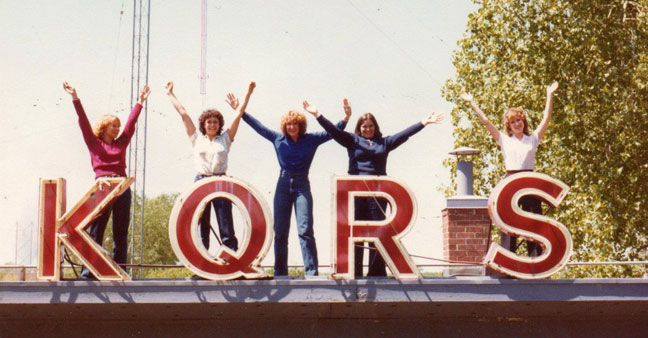
At the studio at 917 Lilac Drive
Save
Save
Save
Save
Save
Save
KEYD
KQRS-AM first signed on as KEYD, billed as Family Broadcasting, 1948. A huge booklet issued in 1949 provides pictures of everyone involved in the station and all the reasons why America is better than any other country. On September 2, 1951, the station sponsored a concert by the Blind Boys, advertised in the Minneapolis Spokesman. There was a live broadcast at 9:15 a.m. and a performance at Graham Temple at 3 p.m. A December 1951 ad said [Cassius’s] Bamboo Room is KEYED for your enjoyment, which may or may not mean that there was a tie-in.
In 1953-55 announcers included Howard Viken, Don Riley, Harry Zimmerman, Slim Jim Iverson, and Slim Jim’s brother the Vagabond Kid. The Record Rodeo show featured western, folk, and other typical American music on Saturday afternoon. No doubt the “Random Ranch” show was similar. Shows like “Record Reville,” “Melody Mart,” Platter Previews,” “The TNT Club,” and mid-1955’s “Hot Corner” don’t give us much to go on as to their format. People could come and watch Slim Jim’s show at the studios on 9th Street.
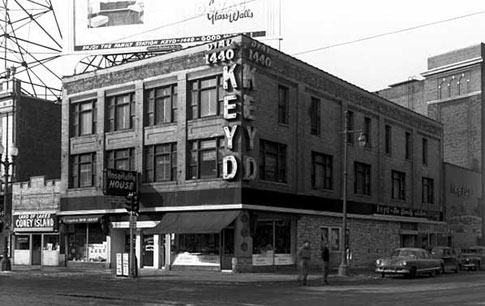
KEYD, 1953. 9th and Hennepin
One mainstay was the “Key Room,” broadcast on Saturday mornings. Photos from the Minnesota Historical Society show the Augie Garcia Quintet performing at the River Road Club in Mendota in front of a banner that says they were featured on the “Key Room Show” on KEYD-AM. The banner gives the show’s host as Dave Reau, and the time slot as 11-11:15 am. Unfortunately the photos aren’t dated, but we do know that the band formed in 1954 when Augie returned from Korea.
A December 1, 1955, ad says “Now All Day” and announces DJs “Texas” Bill Strength and Johnny “T” from Tennessee, and Slim Jim.
In January 1956 Will Jones of the Trib talks about “KEYD radio’s new staff of imported hillbillies,” Texas Bill Strength and Johnny T. from Tennessee. The song list included such gems as “You Clobbered Me,” “Ink Dries Quicker Than Tears,” “Lie Detector,” and Take Your Cotton-Pickin’ Hands Off My Girl.” The station had been playing some Top-10, Classical, semi-classical, some religious, etc. The owners brought in Robert Purcell to inject life in the station, and a friend who booked Country & Western touring shows told him that the area was one of the top in the country. This is borne out by the number of Grand Ole Opry touring shows that came through in those days.
KEYD became KEVE before becoming KQRS.
Save
Save
KEVE
In June 1956 KEYD was sold, changed its call letters to KEVE, and played full time Country and Western – one of the first in the country to do so.
In 1959 it had a monthly newspaper called Big K News.
In 1959-1960 KEVE had a Sunday remote broadcast from the Fireside in Fridley.
An undated report says KEVE did a remote broadcast from the Flame on Saturday nights from 10:30 to 11:30 pm.
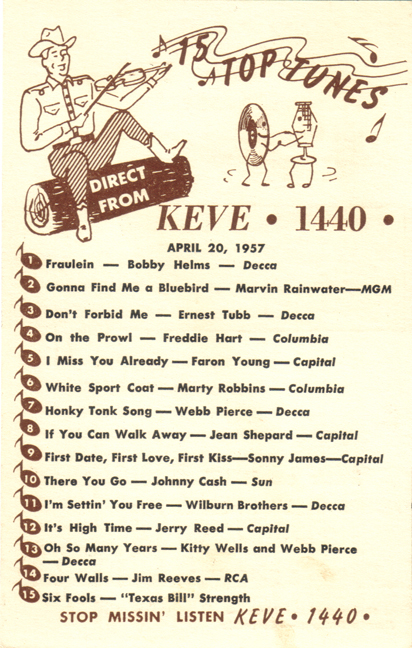
The format changed to classical music in 1961. In November 1963 the Program Director was Jerry Cunning and the General Manager was Robert J. Rock.
The station became KQRS
Return to Twin Cities Radio
Save
Save
KDWB was the former WISK.
1959
KDWB went on the air on September 16, 1959, as a top 40 station. (The name change from WISK was reflected in the radio listings in the newspaper on September 19.) To get us in the mood for another rock ‘n’ roll station, they played “Charlie Brown” by the Coasters – in French – non-stop for several days.
THE GOOD GUYS
Don French was the first Program Director. The first lineup of DJs was Hall Murray, Phil Page, Sam Sherwood, Bob Chasteen, Bob Friend, Randy Cook, and Dick Halvorson John McCrae was the first General Manager, and Sam Sherwood held that position throughout the ’60s. The FCC required that the station identify itself as “KDWB – Lake Elmo, also occasionally serving Minneapolis and St. Paul.” The station provided immediate competition to leading rock ‘n’ roll station WDGY: See a good piece on the KDWB/WDGY rivalry from KARE-11 News.
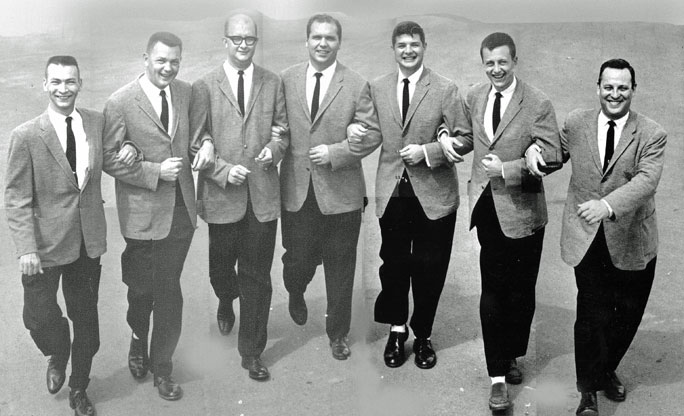
The KDWB Seven Swingin’ Gentlemen, 1960: Randy Cook, Dick Halverson, Bobby Dale, Sam Sherwood, Bob Friend, Lou Riegert, Hal Murray. Photo courtesy Pavek Museum of Broadcasting.
FORMULA 63
The following is from an email dated September 19, 2007, from Chuck Blore to Rick Burnett describing the Formula 63 and “63 – That’s Easy to Remember” promotions that Blore devised when KDWB first went on the air. The material was from the then-unpublished autobiography that appeared as Okay, Okay, I Wrote the Book in 2012.
I will cut in on occasion with additional/alternate information from Will Jones of the Minneapolis Tribune.
The Twin City stations were all on the upper part of the dial at 1070, 1130, 1490, etc., but nothing below 1000. WISK, soon to be known as KDWB, was at 630, a spot no one in the listening area had ever heard, or even heard of. So, our problem was not only to be the best station on the air there, we first had to let them know there was a ‘there’ there. There, at 63, where no Minnesotan had gone before.
With that in mind I had Charles Arlington record, as only he could, a theme line: “Sixty Three. That’s easy to remember.” Of course, we could say that sixty three times an hour, and if no one was listening, it wouldn’t be that ‘easy to remember.’ So, we had to do something to let people know we were there … there.
Thinking about how to tell the good people of the Twin Cities there was some good radio on the South end of the dial was pretty much all I was thinking about. Billboards? I guess. But in Minneapolis-St. Paul a good part of the year was snowbound and it was really hard to see the billboards through all that sleet. Newspapers? Yeah, but I hated newspaper advertising. It’s dead, it just sits there. Whatever the approach, it had to be as different as was our position on the dial.
I had hired Don French to be the KDWB PD. Don and I had both been part of the KTSA deejay team in San Antonio a couple of years earlier. I always respected his unusually creative approach to all things radio. We were thinking about this ‘positioning’ problem when Don remembered something which had been a national marketing phenomenon a few years earlier.
A fellow out of Texas, after first commissioning himself a Colonel, was bottling what was essentially sweet prune juice, calling it Serutan, and telling the great American radio audience over and over again, day after day, Serutan is ‘Natures’ spelled backwards. And, as we all know, anything that is ‘natures own’ is good for what ails you. Almost everybody in the country who had anything at all ‘ailing’ them, bought into the pitch. The Colonel became famous and very rich. Everyone agreed that this guy could sell anybody anything. Don reminded me about the Colonel and his pitch prowess. We ought to get him to tell people about how good things are when you reach 63.
Will Jones reported that the ads were recorded by Dudley LeBlanc, the former Louisiana politician who sold Hadacol years ago.
Oh, sure, was my response. What are we gonna do? Buy spots on the other stations?? We looked at each other for a long time. A moment later we were both rolling on the floor, rocking with laughter. Rocking and rolling and repeating over and over….We’ll advertise on the other stations. Ha Ha Ha Ha Ha!!!
We dug up the Colonel, I called and told him what we had in mind. We thought you could come up with a new product called Formula 63. Guaranteed to make life more fun. The Colonel loved the whole idea and agreed to do it.
We did it. We hired an advertising agency which represented a large local chain of drug stores where free samples of Formula 63 where to be made available. The agency negotiated non-cancellable contracts with all eight of the Twin City Stations. (Only eight stations in Minneapolis-St. Paul. Talk about a time frame, eh?) And there was one other important requirement. They were to buy only where they could get exactly the same ‘guaranteed times’ on all stations at one time. The result of this was that our spot was on every radio station at the same time. At least 48 times a day, if you happened to be tuning across the dial at that exact time … all you could hear was the Colonel saying, You remember me? A couple years back I brought you Serutan, the product guaranteed to cure what ails you. Now I’m back to tell you about a product, guaranteed to cure an even bigger problem. It’s called, Formula 63. And it’s guaranteed to relieve ennui!
He spoke about the dangers of ennui, tedium and boredom and how these things could absolutely dull your life.
Formula 63, will relieve ennui …he promised… right from the first moment you try it. And you can try it today. A free sample is waiting for you at any Provident Drug Store. A touch of Formula 63 is the perfect way to brighten up your mundane day. 63 … that’s easy to remember.
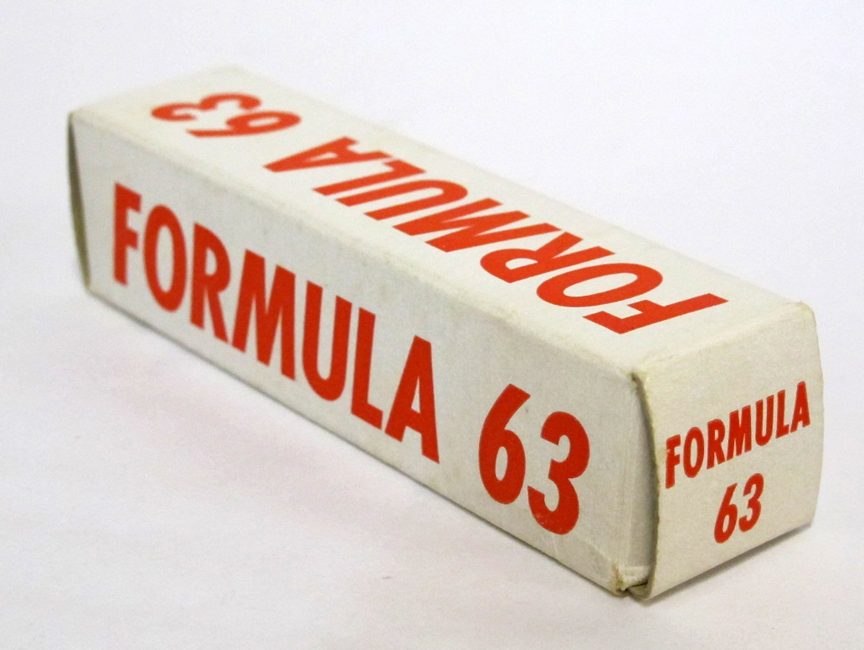
Formula 63 box, courtesy Sam Sherwood. Photo by Steve Raymer.
Will Jones tells us that security was so tight that the 120,000 packages were stuffed at the Society for the Blind. Even the disk jockeys weren’t let in on it until that morning. And it was Snyder Drug Stores.
At every Provident Drug Store (not the real name) was a giant stack of tiny boxes beneath a huge sign saying, “Free Samples of Formula 63. Relieve Ennui today!” Inside the box was a piece of paper on which there was a beautiful color picture of the Twin-Cities Radio Dial with a large arrow pointing to the left end of it and an invitation to…Come on down.
‘If you suffer from lusterless, uninteresting radio, etc., etc., come on down and put a little color in your life.’
Then, the station logo and the words:
’63. That’s easy to remember.’
See actual photos of the insert below.
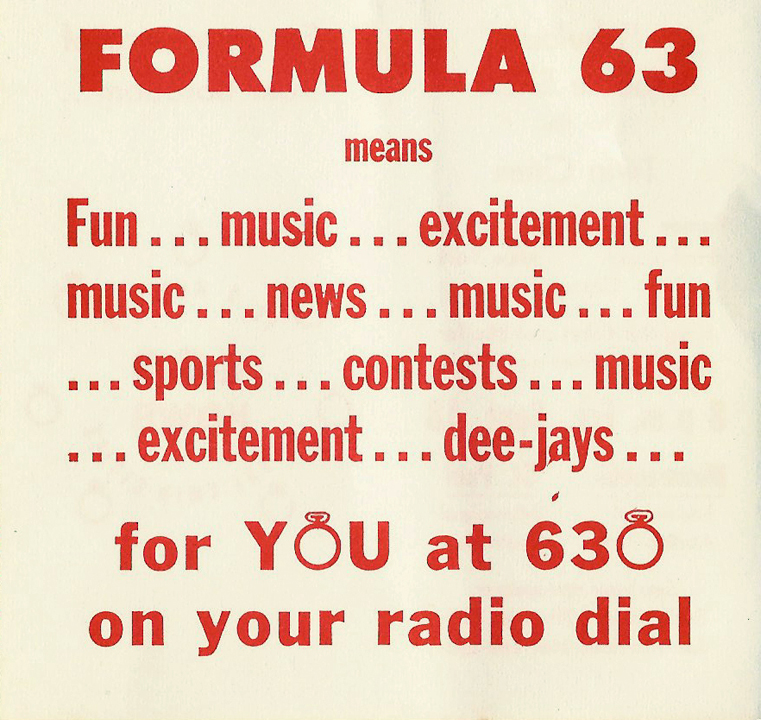
Inside of Formula 63 package, courtesy Sam Sherwood.
It wasn’t long before the radio stations heard about the fact that they were advertising a competing radio station. Matter of fact, the spots started at 6 AM and by 10 seven of the eight stations had called the ad agency making all kinds of threats.
The stations were reminded that they had a non-cancelable contract. They all said the same thing, essentially: screw your non-cancelable contract. And, I’m sure it was after checking with their attorney, one by one they dropped our little campaign. All except for a little country station called K-COW. As a courtesy, once we had been exposed, the agency called them apologetically offering to rescind the non-cancelable clause. K-COW said, Uh uh! We have a contract and you’ll be billed for 2 spots an hour for 2 days. They continued to run the spots.
WCOW was a precursor to KDWB, so it must have been another station.
WCCO, by far the Twin Cities most powerful station, called us to express their outrage and to let us know, We’re taking this whole fraudulent farce to the FCC. That kind of ended when Mr. Purcell reminded them that WCCO, like every station, is required by FCC rules to know who their advertisers are.
We thought Formula 63 with the Colonel was really a good way to introduce our station. What we didn’t realize was how much unexpected publicity we would get in the Twin City newspapers and on TV. Suddenly it was true, 63 … that’s easy to remember.
THE CONCERT
Blore doesn’t mention that on the other side of the insert was an ad for a big, star-studded show that was to take place in both Minneapolis and St. Paul on the same night, September 18, 1959.
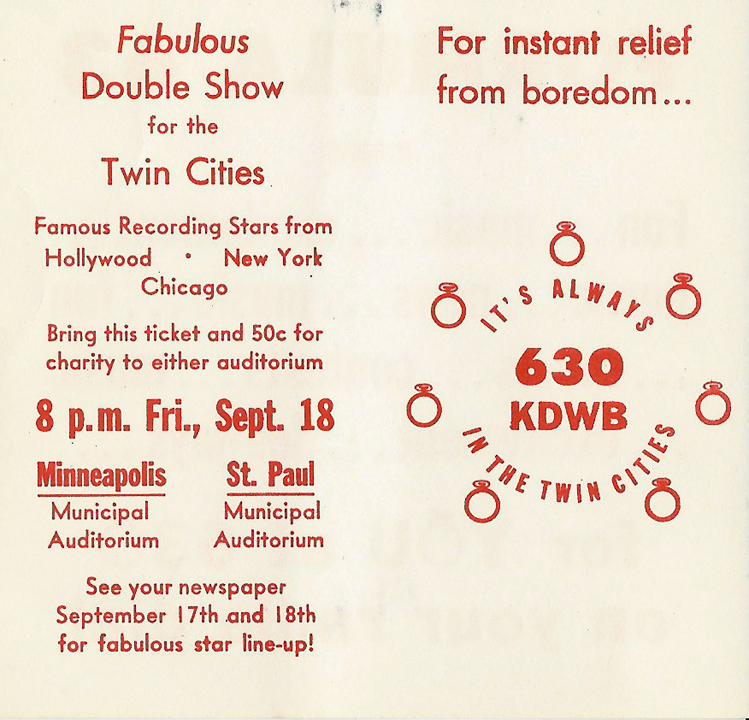
The brochure inside the box was a ticket to a huge rock ‘n’ roll show that would kick off the station.
The show was to start at 8 pm and take place at both the Minneapolis and St. Paul Auditoriums at the same time, with the stars “shuttled” by helicopter between them. (Helicopters had to be replaced by limos when things got too dangerous.) Proceeds were to be divided between the Minneapolis and St. Paul Community Chests. Advertised performers were:
- Dodie Stevens
- Carl Dobkins, Jr.
- Billy Vaughan
- The Four Preps
- Randy Sparks
- Ed Townsend
- Jan & Dean
- Jerry Fuller
- Sandy Nelson
- Jimmy Haskell
- Ernie Fields
- Bobby Vee
Unfortunately, the staff was so busy working out the show and the logistics that they forgot to promote the concerts, and they were poorly attended, Sherwood reported.
OTHER PROMOTIONS
One early promotion involved a sticker that said “KDWB is Everywhere.” $630 would be awarded to the person who placed the sticker in the most unusual place, which turned out to be on the St. Paul Cathedral dome! To promote the contest the jocks would ride around on a float in rush hour handing out stickers, hopelessly tying up traffic.
CATCHPHRASES
The first of the station’s catchphrases was “My Mommy Listens to KDWB.”
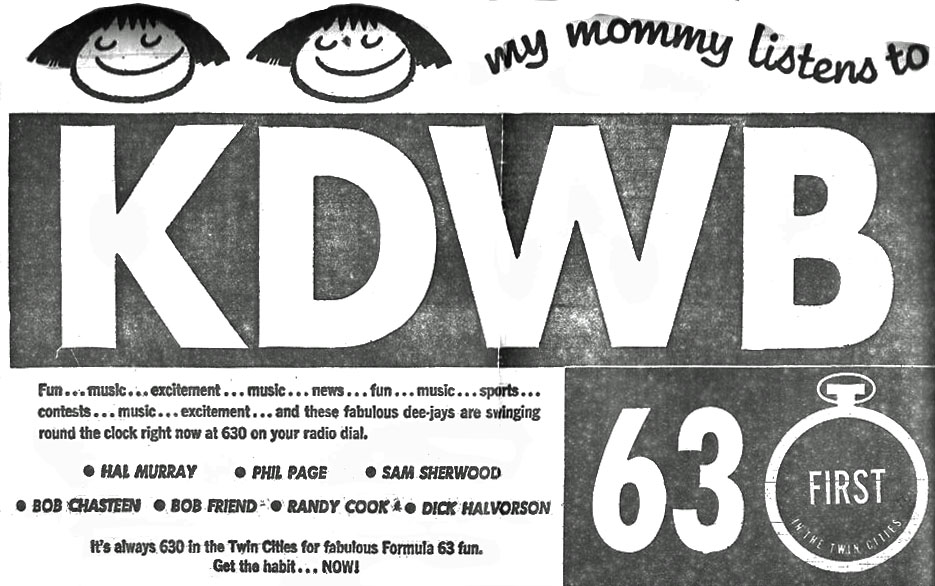
Ad from September 19, 1959 courtesy Jeff Lonto
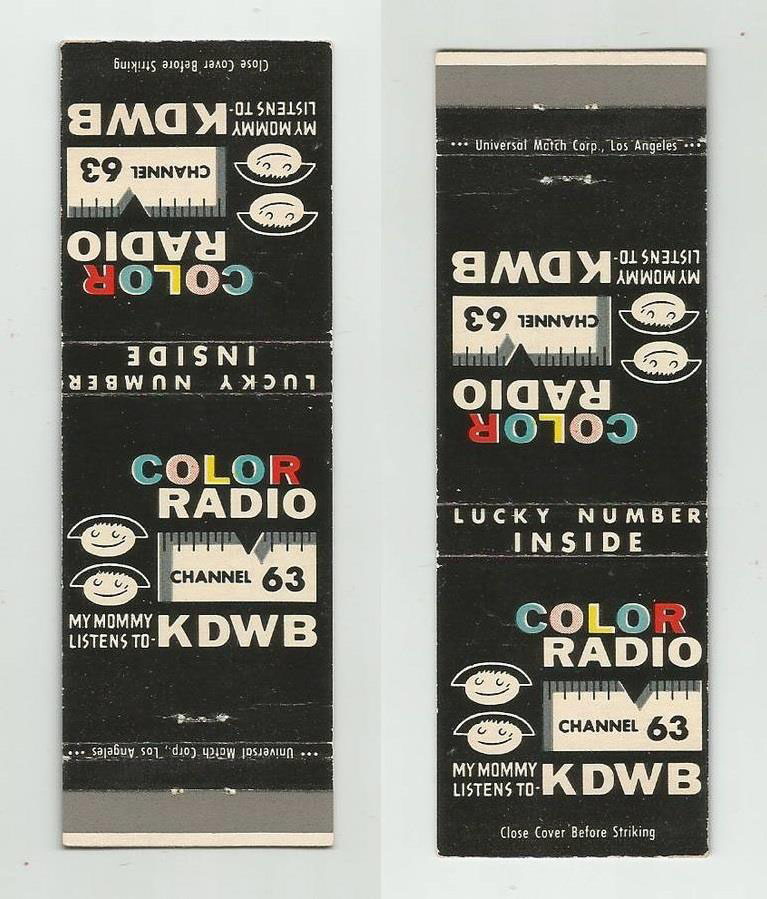
1961
KDWB IN TROUBLE
Congress amended the FCC Act in September 1960 to provide penalties short of license revocation for violations of FCC rules. The first station in the country to receive disciplinary action was KDWB. The station was fined $10,000 in March 1961 for exceeding its authorized power in nighttime operations. Although authorized for only 500 watts from midnight to 4am, it had been broadcasting at full 5,000 watt strength since Crowell-Collier Broadcasting bought the station in late 1959. Whether it actually had to pony up the $10,000 is unknown.
1963
THE COOKIE INCIDENT
One contest in 1963 was a challenge to bake the world’s biggest Christmas Cookie. At first the prize was proposed at 63 cents per pound, but Station Manager Don French decided that a bigger incentive might be $6.30 per pound. They never expected the gigantic turnout, and the ultra-gigantic cookie that won the contest! Below is a photo that’s not too great, but hopefully shows how big the winning monster was. It was delivered in the back of a pickup truck and weighed 2,300 pounds, made with 1,010 pounds of cookie mix, 725 pounds of powdered sugar, and 172 pounds of shortening. It was made by a student named Goodman, who financed the venture by selling $1 shares to his friends with a double-your-money guarantee. It was baked in five pound slabs in a church basement and delivered just an hour before the deadline.
Program Director Sam Sherwood: “I so remember how Don French was on the hot seat for getting hit by such a large prize…he and I argued: ‘I’ll take the hit…no I will…no no, I will’ and that’s the way it went until the cookie picture hit the front pages of news papers across the country….THEN….we became heroes, both Don and I. After becoming VP and General Manager, I made sales calls in all the major markets and it never failed….’Sam Sherwood?!!! Oh the Cookie Station KDWB!!!!’ …and the association never quit from New York to LA…It was the most visible thing we ever did…..!!!!” Sam also remembered that the President of station owner Crowell-Collier was pretty mad, and annoyed when the guys on the golf course started calling him “Cookie,” but when he got to become a celebrity as the story went national, everyone’ job was safe.
The cookie was displayed in the lobby of the Foshay Tower, where viewers filched pieces of it until French dispatched a guard. What to do next? “‘We may drop it from the top of Foshay,’ said Sherwood, Chuckling at the prospect of the world’s biggest pile of crumbs.” Sam says that what actually happened to it was “the cookie was picked by cargo plane at Twin Cities Airport and flown to the ‘I’ve Got A Secret’ Show in New York, MC’d by the late Gary Moore and after that it was just disposed of…not sure how … but that was it…!!”
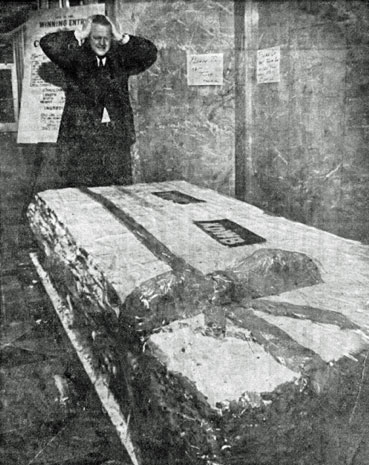
The bow is a nice touch!
Another crazy promotion was the time Charlee Brown styled himself as the Emperor and threatened to take over the State of Wisconsin.
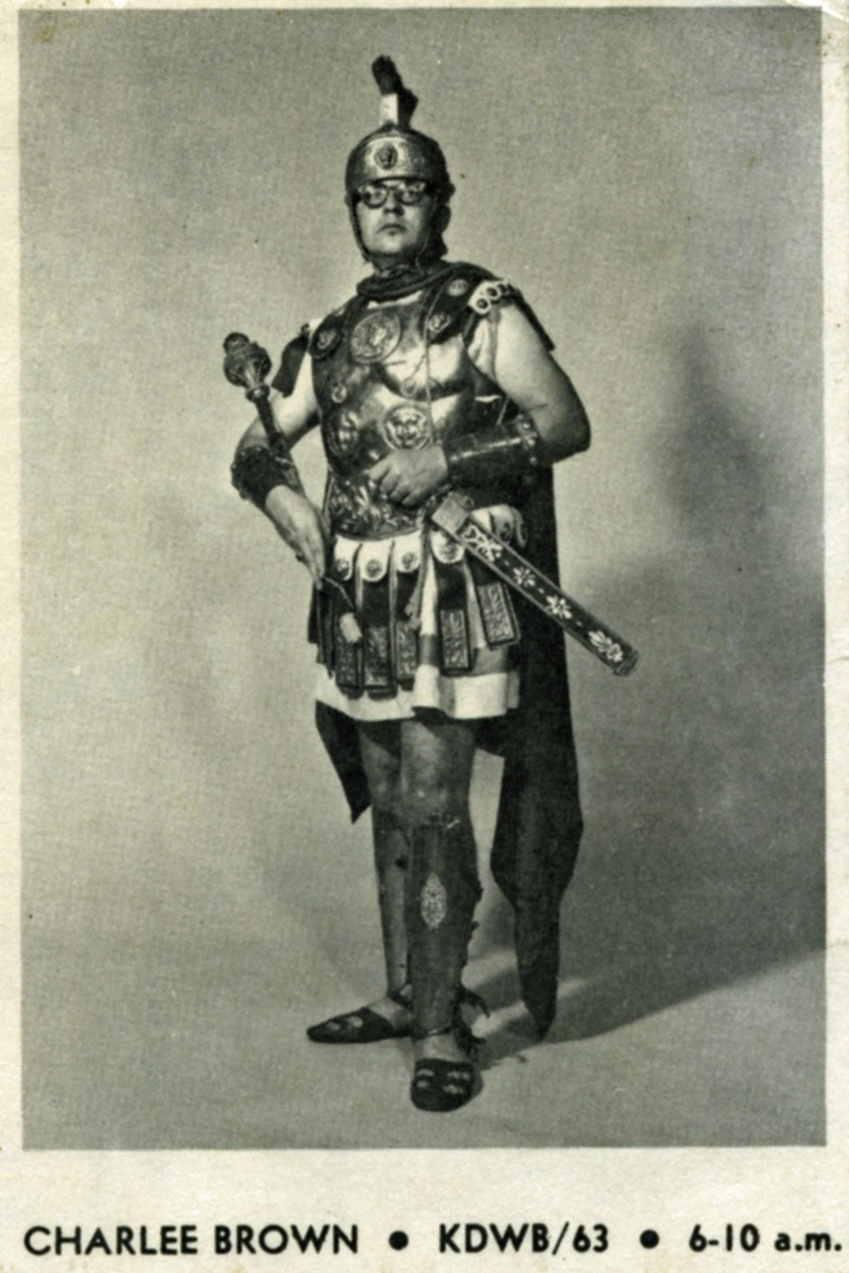
1966
FLAG POLE SITTING REED
In conjunction with the 1966 Aquatennial, disc jockey Jimmy Reed spent (a reported 21 days) on top of a flagpole in downtown Minneapolis starting on July 5, 1966. Don Betzold recalled, “It wasn’t really a flagpole. It was a small shack hoisted on a small tower on the corner of 9th and Nicollet. I stopped and visited him one morning, and he lowered a Bob Dylan album for me. Although he broadcast his morning show from there, there were reports that he went inside the adjacent Young-Quinlan-Rothschild building at night. I don’t recall if he spent 21 days up there, but it was a while.” A KDWB “Fabulous Forty” survey that Don donated to the Pavek Museum of Broadcasting called the shack a “four-story-high flag pole playhouse.” John Pratt saved an article from the Minneapolis Star reporting that four hoodlums set the crepe-paper wrapping on the 40-ft. pole on fire. “Police said the wood snow fence frame beneath the paper had ignited at several points.. The whole tower and Reed’s escape rope would have burned had the wood had a chance to get a good start.” Reed slept through the whole thing.
1967
THE AMOEBA INCIDENT
In the July 2, 1967, edition of the TMC Insider, we learn that “KDWB went off the air last Friday when a 50-foot tower was blown down and fell on top of the station’s studios. As the tower hit, a light fixture fell and narrowly missed Bob Morgan, who was on the air talking about the weather.”
1968
CORNELIUS AND THE TEEN MACHINE
Click here for the story of a strange radio show that was sponsored by Dayton’s and aired on KDWB for four months in 1968.
UNDERGROUND MUSIC
On August 13, 1968, KDWB started programming “underground music” from midnight to 5 am. However, they were not playing records by local groups – Earl Trout III told the Insider that the station “was on a tighter playlist.”
1969
TONY GLOVER
From 1969 to mid 1970, Tony Glover held down the midnight to 6 am shift. In an article in the February 1972 Insider, Tom Murtha noted that Glover was the “prime mover in bringing more diversified programming to local radio.” Glover was not the first to present underground music in the Twin Cities – when he took on the overnight shift in 1969, George Fisher at KQRS had already been playing a diverse selection of underground rock, jazz, blues and comedy (Firesign Theatre, Cheech and Chong) for a couple of years. But Glover was probably the most popular and well-known.
Glover did most of his programming from his own record collection. His wry, understated wit, carefully studied word choice, and RELAXED delivery won him a following unheard of since the days of “Murray-go-round” on KDWB and “Throckmorton” at WLOL. … Glover finally finally took two weeks vacation in New York City and never came back.” [He became a freelance writer and contributing editor for Circus, a music magazine.]
FIRE!
On November 30, 1969, fire spread through the KDWB studio, destroying two transmitters and shutting it down for two days. The following account was taken from Rob Sherwood’s blog:
I was listening to WLOL, a smallish AM’er that at that time was doing Talk Radio. (Were they ahead of their time?) I was driving my yellow Toronado through the spaghetti part of I-94 in St. Paul. Swinging through the Heights area the freeway ended and became Highway 12. Soon, it was possible to see the lights on the six KDWB towers. The fact that there were no lights did not compute until I heard the news guy on WLOL say, “The radio station studios of KDWB burst into flame this afternoon. Fire trucks are on the scene and we’ll up-date you as additional details come in.”
Out of reflex, I punched the 63 button and – silence. Then I noticed the missing tower lights. No signal. No lights. No Top Forty. No KDWB!
Like an acid-etching, the events of that day in early December 1969 are sharp as cut crystal. I may get the dates wrong, but the devil is in the details and I am loaded with details. I didn’t exit at McKnight drive. I continued on Highway 12 to Radio Drive. There were fire trucks everywhere. I had to park on the highway and walk up the hill to the studios. More fire trucks. The building itself was very dark. There was the terrible smell of burnt paper and charred wood. There were a bunch of people but no real activity. Everyone seemed to be just milling about.
The fire was out.
Here is what had happened. The old transmitters produced a lot of heat. This heat siphoned off through ductwork that eventually combined with ductwork from the furnace and heating system. There were baffles designed to permit travel only in one direction, so a fire in the vent-work should have just traveled out. The baffles failed. The fire from the furnace traveled to the transmitters and out the intake vents. The DJ on the air, Ron Block, noticed the pall of smoke in the hallway and left the building. Then, thinking he may have over-reacted, returned to the studio to start the next song. He tried to use the phones, but the wires all came into the building through the furnace room and they were already toast. He broadcast over the radio that there was a fire at KDWB, no joke, and that someone should call the fire department. (Phones at fire departments all across the vast Twin Cities area rang causing a ton of confusion as to just exactly where there was a fire.) Ironically, he then started the next record, “Na Na Kiss Him Goodbye” by Steam and once again left the building.
Meanwhile, the engineer, who had been in the tower field, returned to the building and was just seconds from opening the back door. If he had opened that door, the back draft would have engulfed the engineer in flame. Fortunately, the door blew open before he got there. Nobody died.
As disasters go, this one wasn’t even on the radar screen. So what if a top forty am radio station in Minneapolis/St. Paul caught on fire and was off the air? You think that WDGY wasn’t figuratively licking its chops? Think of all the bad karma we collected every time we played “Puppy Love” by Donny Osmond. It was payback time. When even a little pimple of a disaster like this strikes, people rise to the occasion. We are a resilient species aren’t we?
KDWB went off the air at 5:21 PM, Sunday Afternoon, and was back on the air on Tuesday.
The rest of that Sunday night, people continued to mill about. So stunned were most of us, the gravity of situation was difficult to grasp. Eventually we had to accept the reality of what had happened. The transmitters were destroyed, as was the entire engineering area and furnace room. The roof hadn’t collapsed, but the rafters were charred black. The hallway down the middle of the building acted as a firebreak and the hardcore damage was on one side and just water and smoke damage on the other side. In the main studio, there was a sticky sap-like residue on everything. The control board, counters, carts, walls, microphone, everything.
The fire department didn’t want us beginning the clean up until the inspector could make sure the building was safe to enter. That wouldn’t happen until daylight. The next morning we were all there and I still remember seeing Howie Anderson shoveling the wreckage out the engineering entrance.
While some of us labored shoveling and wives and girlfriends scrubbed the residue gunk off everything, KDWB, like a phoenix, was about to arise from the ashes. We needed new transmitters, new phones, new carpet, new roofs, new this and new that. The production room was a wreck and there was no heat in the building. No electricity.
Over the next few days, the cleaning and repairing continued. Roof rebuilt. New furnace, electricity etc. What about a transmitter? Collins, a transmitter company located in Peoria, Ill., I think, had a 1,000-watt transmitter and a 630 crystal. Don’t ask me what that all means. I got my First in 6 weeks at Brown Institute. How to get it to St. Paul? I suppose at full speed, in December, the ride to Peoria would take 18 hours. Then they would have to schlep the transmitter in a big box (about the size of a single hole outhouse) back to Minnesota.
Enter Bob Reed the news director. Remember Bob? The gun-toting news director? He had a pilot’s license so he rented an airplane and he and the engineer, Rey Lark, and someone else hopped in with Bob and flew through the night to Peoria where they picked up the transmitter.
Funny thing, it turned out that Bob Reed didn’t have a pilot’s license. He had a student pilot’s license and certainly shouldn’t have been flying alone, in the night, in a storm, with passengers. That night God must have liked bubble gum music because his gentle hand protected that flight.
Meanwhile, they borrowed a little trailer studio from someone and that was our production room for the next month or so. We ran through the frigid Minnesota December weather to get to the production room. Once in there, though, it was kind of cozy.
Back to the drama. After the wayward flight to Illinois and a non-stop trek through Wisconsin, the transmitter arrived, tied to a U-Haul trailer pulled by a rental car. The engineers labored through the night and the following night and on Tuesday, we signed back on. Our normal 5,000 watt, 6 tower, highly directional radio station was now a 1,000-watt non-directional radio station. People heard us in places we had never been heard before. There were many parts of our regular signal area where we were missing. The important goal was to cover the Twin Cities. We were doing just that. We were on the air.
We had been wounded, but we weren’t dead. Channel 63 was back!
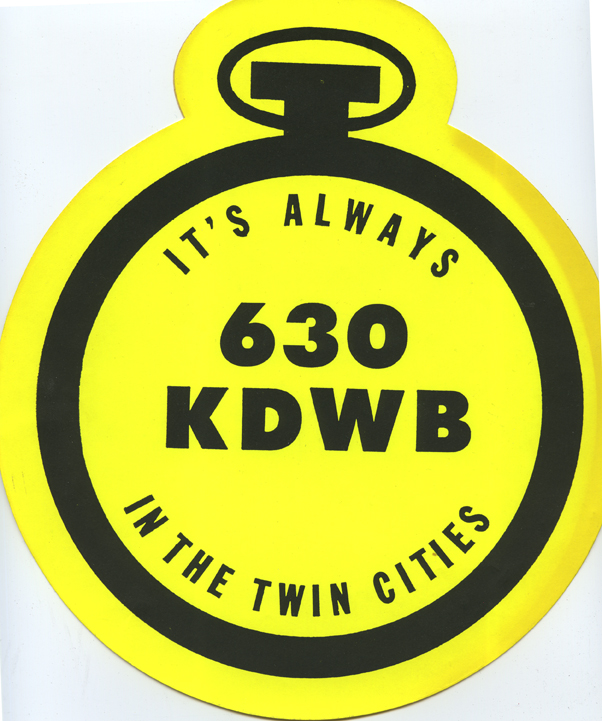
1970
In March 1970, two engineers struck for higher pay and the disk jockeys honored the picket line. The station put on its salesmen, some, like Stan Mack, were former jocks. Everyone made up and by 1972 (and probably before) the station had a Super Shooters basketball team.
The station was innovative in its promotions, had legendary DJs, features like Solid Gold Weekends, and at least two airings of “The History of Rock ‘n’ Roll,” an all-encompassing “rockumentary.”
1971-1972
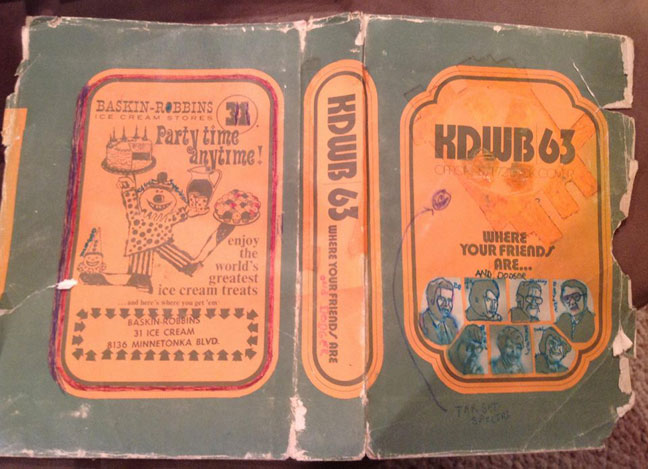
Book cover, 1971-72, courtesy Joel Held
1973
KDWB had a prime spot at the State Fair in 1973, one of the great Teen Fair years.
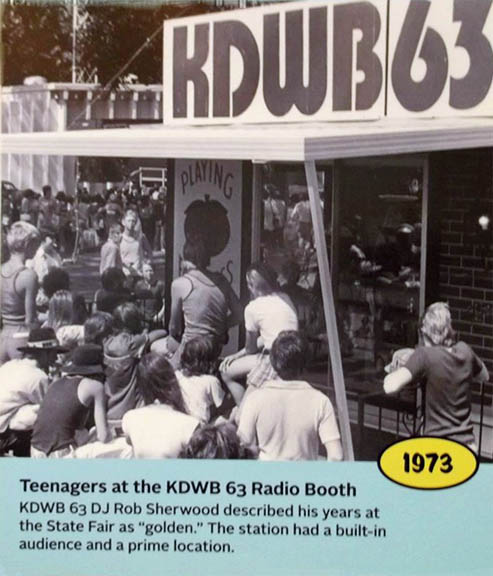
Photo courtesy Jeff Lonto
NOW THIS IS REALLY WEIRD
Similar to the biggest Christmas cookie contest of 1963, in 1973 the station sponsored a contest for the biggest snowman. The creepy monstrosity below, entered by St. Michael Elementary School, was the winner.
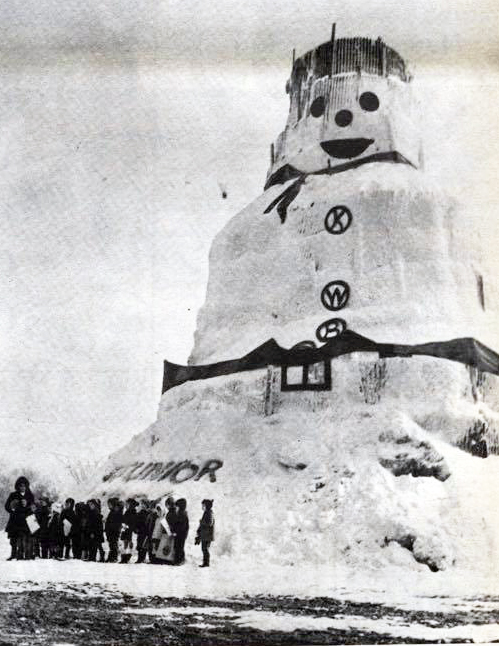
What’s especially weird about this photo is that it was posted to Facebook by Scott Kramer, who says:
I am vacationing in Kauai and a person at our Luau had this in their camera. They were from Andover, MN. We were talking and I happened to mention I was a DJ at KDWB (1982-85) and they had this photo stored in their phone picture library. Thought I would share.
So many questions. So little time. Love it, Scott!
1974
Casey Kasem’s American Top 40 began broadcasting on KDWB on January 6, 1974. Follow the link to read the story of this long-running radio show.
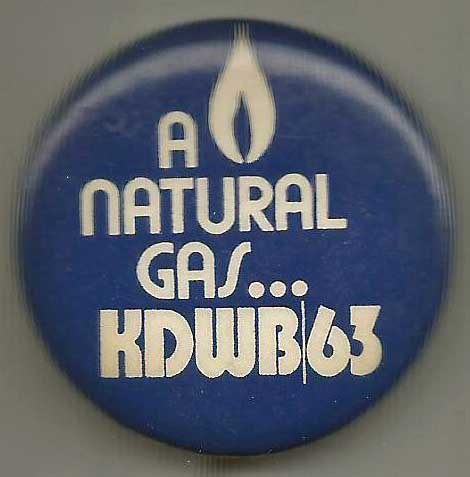
1974 Button Courtesy Jeff Lonto
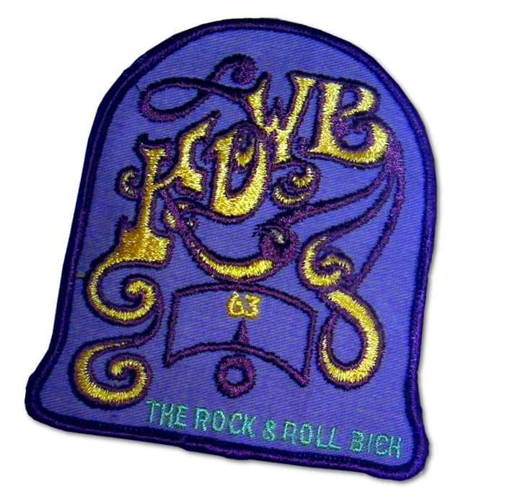
1974 Patch image courtesy Pete Ritchie
1975
The ad below is for “Position 63,” a rather suggestive takeoff of the popular Position 69 that every schoolboy loved to joke about.
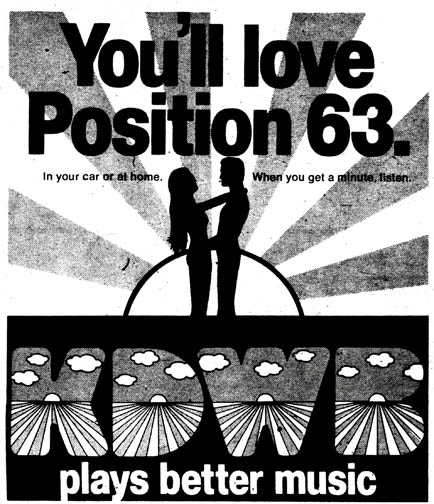
Ad from the Insider, May 1975
1976
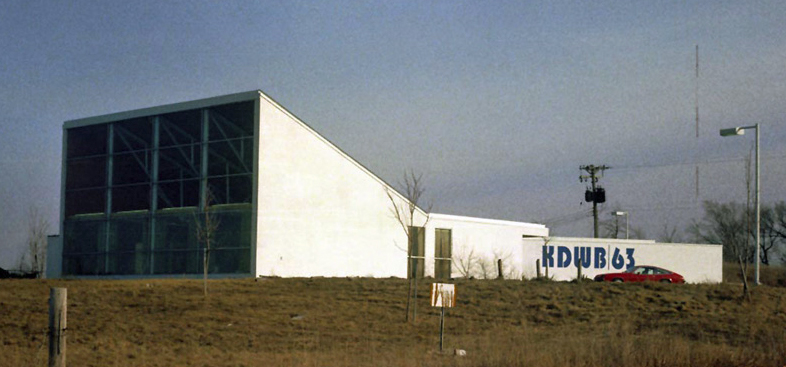
KDWB Studios, 1976 – Courtesy RadioTapes.com
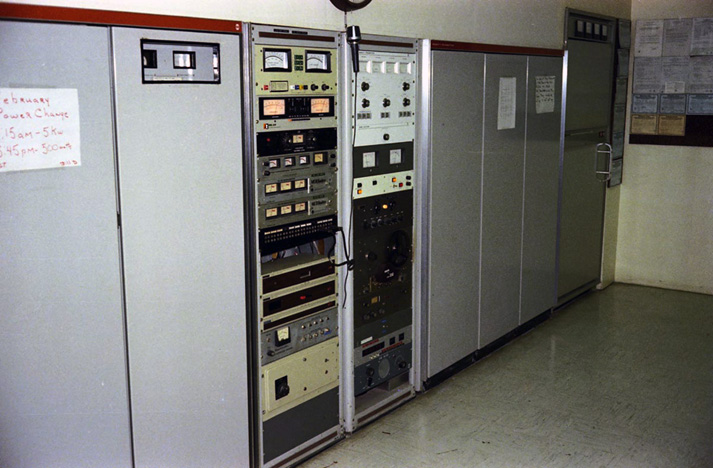
KDWB Transmitter, 1976. Image courtesy RadioTapes.com
1977
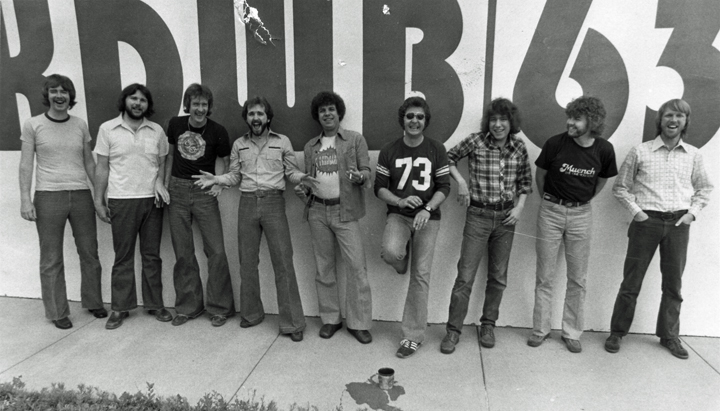
KDWB Jocks, 1977
Not sure where the photo above came from. Jay Philpott posted it to Facebook, and listed the names: Brian “Cosmic” Phenix, Bob Lange, True Don Bleu, Tim Kelly (nee Sebean), Smokin’ Joe Hager, Chuck Britton, Dave Cooper (nee Hamilton), John Sebastion (PD), and Dave Thompson.
1984
PLANE CRASH
Four people were killed when their light plane, flying in a blinding snowstorm, hit a guy wire holding up one of KDWB’s radio towers in Woodbury. It was a single engine plane trying to land at St. Paul’s downtown airport, even though it was flying without instruments. Killed were the pilot, Thomas B. Leivermann, his daughter and son, and his son’s girlfriend.
1994
On April 18, 1994, after 36 years, the 630 kHz frequency went dark. The owner, Midcontinent Media, sold the property. The state of the art facilities were dismantled, salvaged and/or destroyed to make room for the construction of the-then State Farm Insurance Companies regional headquarters. Radio Drive still exists in Woodbury to remind us of those crazy days of KDWB-AM.
Scads of airchecks and music surveys are posted at
http://twincitiesradioairchecks.com/kdwb630tapes.html
http://radiotapes.com/KDWB.htm
Return to Twin Cities Radio Stations
Save
Save
Save
Save
Save
KANO was started in 1956 by Jack Lemme, who owned a radio station in Little Falls. KANO was located in Anoka, with the studio and tower located on a gravel road just north of the Anoka County Fairgrounds in present-day Ramsey. The small 1000 watt daytime station was located at 1470 on the AM Dial. The station played Country music with a heavy emphasis on local North Suburban news and sports.
KANO was Disk Jockey Rod Person’s first radio job in 1959. Here’s a story from Rod, taken from Bullerdash, the newsletter for KSTP Pioneers:
I ran the mid-day shift from 10 AM to 2 PM. About a year and a half later I was assigned the morning shift from 6 to 10 AM. I would arrive at 5 AM, opened up the station, turned on the lights and the transmitter, and clear the two teletype machines of overnight news.
Sign-on was at 6 AM followed by five minutes of news and then country-western music for 55 minutes. At 7 AM following the news we played popular music until signoff.
One Saturday afternoon I was alone in the station working the 2 to 6 PM shift when two men came in the front door. One was a big man about 6’4″ tall, the other much shorter and wearing a white Stetson hat, white boots and a red and white country-western outfit that was so loaded with rhinestones that he literally shimmered when he walked.
I went out to the lobby to see what they wanted an was totally surprised to see Little Jimmy Dickens! He was in town doing two shows at the Flame Nightclub at 16th and Nicollet in downtown Minneapolis. Jimmy and his agent were out visiting stations that played country-western music and promoting his latest record.
We chatted and laughed on the air for about 15 minutes, talking about his devilish upbringing, singing at the Grand Ole Opry, the weekend shows at the Flame and played his latest recording…
To this day I am still impressed that a major country western and Grand Ole Opry star would drive all the way out to Anoka just to visit with someone who played country-western music for only 55 minutes a day. And, I can confirm that the man was everything his name implied: he was “Little (4’11” tall), “Jimmy” (for James Cecil), and he admittedly was full of the “Dickens.” But that’s another story….
Tom Kilbride was a DJ at KANO from 1960 to 1965. Here’s a photo of the KANO VW bus from July 1963, with his wife, sister, and daughter.
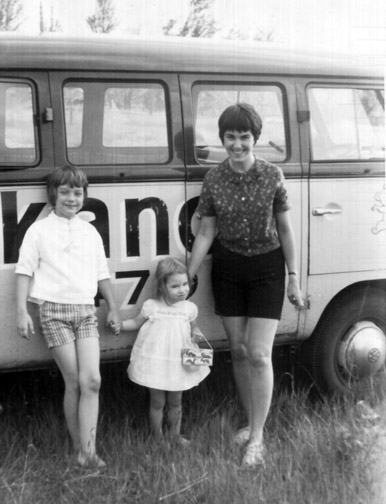
Courtesy Tom Kilbride
